

What To Wear On Safari
What clothes to pack for your safari.
The type of safari clothing you decide to pack for your safari will depend on a number of things, including the destination, time of year and what type of safari you’re going on. However, there are a number of universal principles when it comes to deciding what to wear on safari.
Click below to go straight to the most relevant section, or scroll down to read the full safari clothing article:
Safari wear basics | Safari shirts | Trousers | Footwear | Safari hats | What not to wear
Safari wear basics
What’s the best colour to wear on safari.
The basic rule of suitable colours for safari clothes is to go neutral . When trying to spot wildlife you’ll have the best chance if you blend in as much as possible with your surroundings, and bright colours will make you conspicuous to animals – particularly if you’re on a walking safari .
Ideal colours for safari wear are natural, such as:
- Light Browns
Whilst any other neutral colours are fine too, there are a number of colours you should definitely make sure you don’t wear on safari wear:
Camouflage clothing is a big no-no, and in some African countries it’s actually illegal , so leave the camouflage safari clothing at home!
White and very pale coloured clothes show up the dust, so are best kept for evening wear.
Dark blue and black colours attract insects and mosquitos, which can carry malaria, yellow fever and dengue fever – some of the most serious health risks you might encounter on safari.
Ideal safari clothing material
The ideal material for safari clothing is something that’s lightweight & breathable and makes minimal noise whilst you’re moving. Simple cotton works best for safari shirts and trousers, though there are increasing numbers of quality modern man-made materials that work just as well as cotton and are even more durable.
Think layers for safari wear
Packing lightweight safari wear has the benefit of enabling you to layer up or down according to need. Africa is a continent of extremes – it can be extremely cold through the night into the early morning and swelteringly hot by the middle of the day.
As such it’s a good idea to take multiple layers of safari clothing so you can add and remove layers as required – including at least one warm layer like a sweatshirt, fleece, or safari jacket . This is particularly important if you’re going to be doing any early morning safaris in an open-sided vehicle (though your lodge will likely provide blankets for early morning game drives).
What to wear on safari – the essentials
When it comes to safari clothing less is more, and most camps and lodges have same-day laundry services, so bear this in mind before packing a huge suitcase full of safari clothes! At a minimum you will need:
Safari shirts
A few comfortable long-sleeved shirts and long-sleeved t-shirts. Long-sleeved safari shirts have the advantage of offering protection from the sun and insects, but also being able to roll the sleeves up if it gets too hot.
Shirts with a collar to protect the neck from the harsh sun are advisable, as are shirts with pockets to store your bits and pieces (see our article on top things to take on safari if you’re after useful things to fill your pockets with!).
Our favourite men’s safari shirts:
[amazon box=”B07427LJG9,B00EO32DCW,B06XD5V6D9″ grid=”3″]
Our favourite women’s safari shirts:
[amazon box=”B0868LGBCY,B07115T7MB,B07M8BCYYK” grid=”3″]
Trousers & shorts
A pair of comfortable long trousers or two, and a pair of shorts. Combat style trousers and shorts are ideal safari gear as they have several pockets, great for storing compact binoculars, suncream, camera etc.
Long trousers have the benefit of keeping you warm and protecting you from the sun in the day and mosquito bites on evening and night game drives. Here are some good safari trouser options:
[amazon box=”B01D60XBVK,B08DTW3F7W,B00DQ5244G” grid=”3″]
The type of footwear required to wear on safari really depends on what type of safari you’re planning. For a standard game drive or self-drive safaris , special safari footwear isn’t necessary. You’ll be climbing in and out of safari jeeps and maybe a little walking around the bush, so comfortable trainers will work fine.
For more specialist safaris such as gorilla trekking you’ll be trudging through thick, uneven rainforest, so rugged Gortex boots are ideal. For any kind of walking safari, it’s advisable to have some sort of hiking boots that cover your ankles – for protection from both bush and snakes. It’s also worth considering a small investment in some hiking specialist insoles to provide extra comfort.
[amazon box=”B0779Q9G9B,B081P5WBQV,B01HFPP89A” grid=”3″]
Whilst not essential safari wear, any hat or cap is better than none at all. It will give you protection from the sun, and also shield your eyes from the glare – meaning potentially better wildlife spotting opportunities. The ideal hat is a wide-brimmed safari hat to offer maximum protection.
Read our take here on the very best safari hats , or check out these great options from Amazon:
[amazon box=”B06XH2JSK7,B072J5JS25,B07K447FF5″ grid=”3″]
The African sun can offer a surprising amount of harsh glare, so you won’t want to forget sunglasses as part of your safari attire. A pair of polarized wrap-around sunglasses will give you protection from both the glare and the dust that’s a feature of many game drives, meaning more chance of spotting that hiding leopard!
Evening wear
When considering evening safari wear, bear in mind that the days of jackets and ties at the dinner table are long gone. Most safari lodges have relaxed dress codes for dinner so there’s no need to take any formal safari clothes with you.
You’ll want to wash and change after a hard and dusty day’s game viewing, but a pair of jeans or trousers and a long-sleeved shirt will suffice, perhaps along with a warm fleece or safari jacket to ward off the night-time chill. Light colours are recommended for evenings so you don’t attract mosquitoes.
Be sure to check out whether your lodge has a swimming pool and if so, don’t forget to pack some safari-chic swimwear. A dip between game drives during the middle of the day is a great way to contemplate your wildlife viewings (past and future!) whilst working the tan.
What not to wear on safari
The above information should give you a good overview of what safari clothes to take with you, but just in case you’re still in any doubt, here’s a list of the clothes you should absolutely not take with you on safari:
A camouflage safari outfit . In a number of African countries, you can actually be arrested for wearing army-style camouflage clothes that could be confused with military wear. Best to avoid at all costs.
Overly thick fleeces and jackets . Temperatures on safari change depending on the time of day, where you are, and what altitude you’re at… so layered clothing is ideal to add or remove as the temperature requires.
Heavy walking boots . Unless you’re planning to do some serious hiking a pair of trainers will do for walking around camp and hopping in and out of your jeep.
Black and blue clothing . East Africa is home to the tsetse fly which is attracted to dark colors and packs a nasty bite – best avoided by wearing lighter colours.
Bright clothing. Don’t draw attention to yourself if you want the best chance of spotting wildlife .
Tuxedos & ballgowns. Yes, people do! Most safari lodges have a very relaxed dress code for dinner, and whilst you will want to wash and change after a hard day game viewing you won’t need to dress over-formally for any evening activities.
And one last ‘don’t do’ tip for packing your safari wear:
Packing it all in one large suitcase . Limit the risk of all of your luggage going missing or being stolen on the flight by packing some essentials – and one safari outfit – in your hand luggage.

Hawaiian shirts are a classic no-no as safari clothing
Have you been on safari lately and have some tips on what to wear on safari? Please let us know by getting involved in the comments section below!
Have a sneak preview at http://www.youtube.com/watch?v=glO-rRsPBIo&feature=youtu.be All authentic gear – made close to the Kruger National PArk in South Africa – available here in the UK
We are travelling to South Africa to do a safari adjacent to the Krugar. Is that right that Camouflage is completely no allowed? Only I have just purc hased Shorts and a Hat. Please advise
Hi Colleen, as far as I’m aware there are no restrictions on camflage wear in South Africa, so you should be fine. That said, to be sure you should drop your safari lodge a line as they may have their own rules.
This is suitable for safaris! http://www.cafepress.com/guaxinim/9341456
Do you consider light to medium gray to be ok for colors
Hi Aggie, medium grey is a good colour for safari clothes, so long as it’s not too dark and not too light!
I would be interested in specific suggestions of brands to check out for women’s safari wear. Thanks, Barbara
An item I found extremely useful for gamedrives in open vehicles during winter is my large olive rain poncho. It works fine as a wind spiele and easily fits over the extra set of blankets you might wrap around you.
Excellent idea Birgit, I’ve never used a poncho, but I’d imagine they’re ideal for game drives – lightweight, and quick and easy to get on and off according to the weather.
Sounds like a great idea Birgit. We’ve been on a few high-end safaris where they’ve provided ponchos on bad weather game drives… but taking your own means you’ll be sure to stay dry!
Top countries for safaris
- Botswana safaris
- Kenya safaris
- Namibia safaris
- South Africa safaris
- Tanzania safaris
- Uganda safaris
Safari basics
- Safari animals
- How to find the right safari company
- When to go on safari
- What to take on safari
- Safari clothing – what to wear
- Safari rules & etiquette
- Wildlife spotting tips
Most read articles
- All about the ‘big five’ animals
- Collective nouns for animals
- Safari movies to watch before you go
- The world’s fastest land animals
- Apex predators
- 10 Fascinating African tribes
- The biggest animals in the world
- 17 Epic hybrid animals
- The world’s ugliest animals
- Why are flamingos pink?
Africa’s best game reserves
- Chobe National Park, Botswana
- Etosha National Park, Namibia
- Kruger National Park, South Africa
- Masai Mara National Reserve, Kenya
- Moremi Game Reserve, Botswana
- Okavango Delta, Botswana
- Serengeti National Park, Tanzania

Session expired
Please log in again. The login page will open in a new tab. After logging in you can close it and return to this page.

What to Wear on Safari in Africa? 8 Tips for the Best Safari Outfit
Searching for practical tips about what to wear on safari in Africa for a safari outfit that is both fashionable and functional? Embarking on a safari adventure promises thrilling encounters with wildlife and breathtaking landscapes. As you plan for this unforgettable journey into the African wilderness, one crucial aspect to consider is your attire. Your safari outfit should strike a balance between comfort, functionality, and style, allowing you to fully immerse yourself in the wild wonders of the safari world while remaining practical for the natural environment you'll be exploring. In this comprehensive safari clothing guide you will learn more about the safari dress code and clothing essentials.
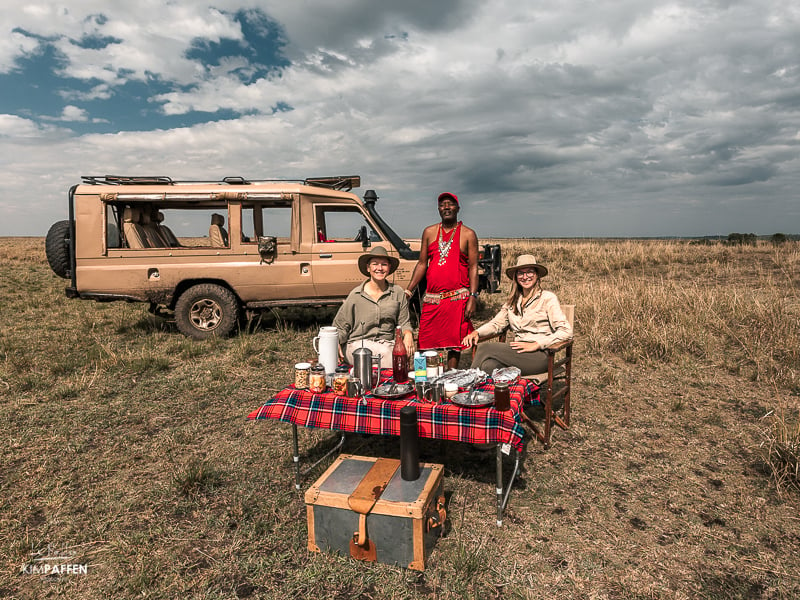
So what is a good safari outfit? A good outfit for safari helps you deal with Africa's environmental conditions like heat, moisture, dust, and insects. It’s important that they offer sun and anti-insect protection, dry quickly, and don’t wrinkle fast. There is a safari clothing rule of thumb that says: ‘Dress in layers for all activities & wear shades of the African bush’.
Your clothing choices and safari wardrobe can greatly impact your comfort and overall enjoyment during your safari. Here are 8 essential safari clothing tips for crafting your perfect neutral safari outfits :
1. Neutral Earth Colors for your Safari Outfit
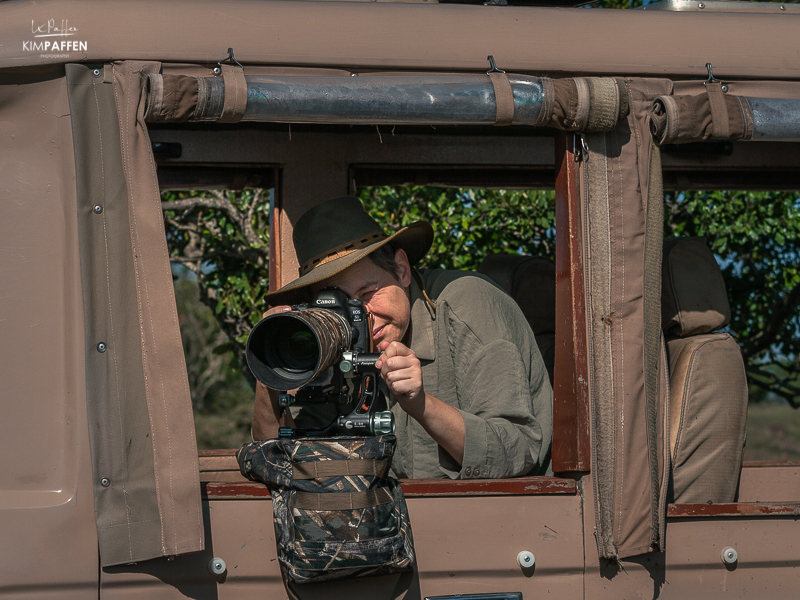
Neutral-colored tones like khaki, beige, brown, and olive green work best to help you blend in with the natural surroundings of the African wilderness and are less likely to attract insects. Another tip to keep insects away on safari : avoid applying strong smelling perfume. Instead, use essential oils with citronella or lavender to repel insects like mosquitoes. Wearing a safari outfit in earth tones also demonstrates respect for the natural environment and its wildlife. It aligns with the principles of responsible and ethical wildlife viewing.
Dark clothes for safari like black and blue attract heat, biting tsetse flies, and other insects, so these colors are better not to wear on safari. Also, avoid bright colors and neon colors that may startle or attract animals; especially when you go on a walking safari . Although white colors often look nice and stylish on the safari photos across the web, I wouldn't recommend wearing white clothes on safari drives as the roads can be extremely dusty, especially if you're allowed to go off-road in for example the conservancies around the Maasai Mara .
In summary, what colors to wear on safari and what not to wear on safari :
- DO wear on safari: Khaki, brown, sand, beige and green hues are the best colors to wear on safari
- DON'T wear on safari: bright colors, pale and neon hues, black and blue colors, busy patterns and military camouflage clothing (in African countries, camouflage attire is only worn by the rangers and military).
2. Wear Layers on Safari for Protection from the Cold
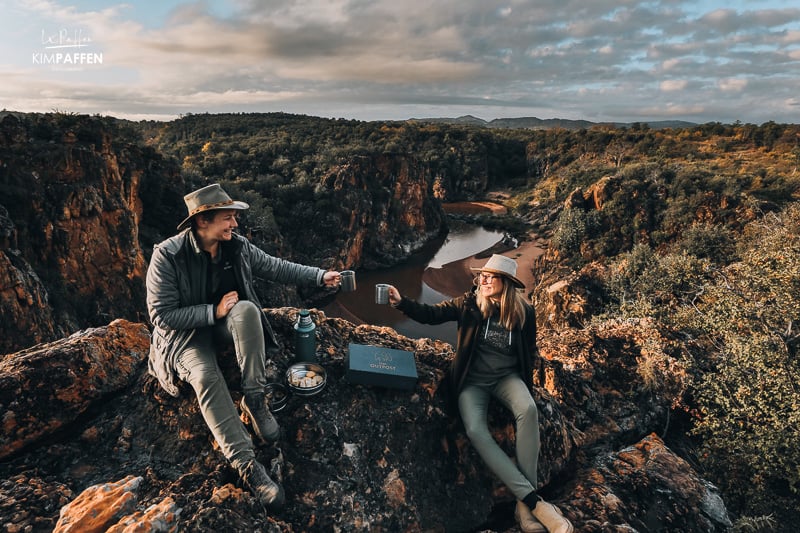
Layer Up! On safari in Africa, weather in certain seasons can change quickly and temperatures can vary significantly, especially during early morning and late afternoon game drives . In the mornings, it can be cold and windy, while in the afternoon it can still be very hot. Sometimes, Mother Nature may surprise you with a heavy rain shower; all part of your Africa safari adventure. That's why it's a good idea to wear layers when you go on a game drive or a walking safari. Layering allows you to adjust your clothing accordingly and stay comfortable in changing weather conditions.
Now, what does wearing layers mean? In the morning, when you start your game drive before sunrise, it can be chilly. So start by wearing for example a lightweight khaki short-sleeve shirt, then a beige long-sleeved blouse, and an olive-green warm fleece jacket to keep you warm in the mornings and on exciting night drives to spot nocturnal animals. When it gets hotter during the day, you can take some layers off. Simple as that. For rainy days, it's handy to have a rainproof jacket, for example a soft shell or poncho that you can easily put in your daypack.
3. Wear Breathable Fabrics on Safari
Safari destinations often have warm climates, so prioritize lightweight and breathable fabrics like cotton and linen to stay cool and comfortable throughout the day.
You can wear lightweight pants, shorts or long outdoor pants that can change into shorts (zip-offs). Choose long-sleeve neutral colored blouses made of light fabric. These best clothes for safari not only keep you cool but also protect you from bugs and the sun. If it gets hotter during the day, you can roll up your sleeves or change your convertible pants into shorts.
4. Consider Safari Clothes that offer Protection
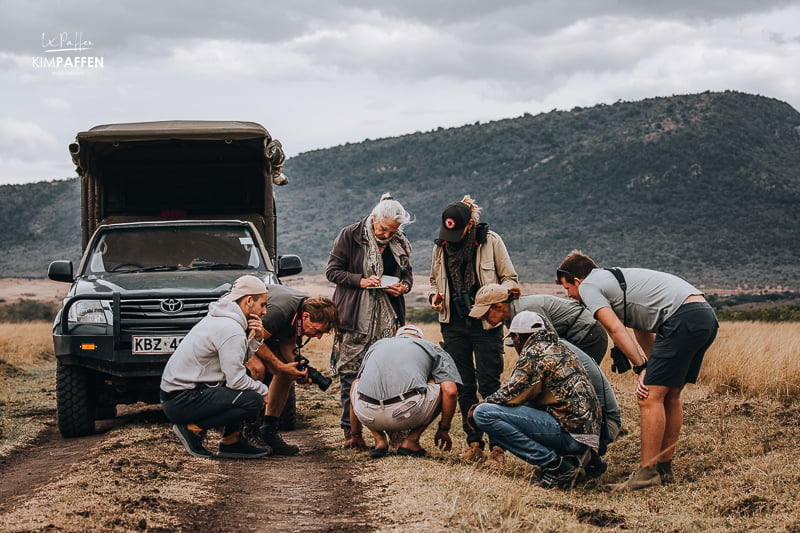
Safaris means exposure to the sun, insects, and potentially (lots of) dust. Long-sleeve shirts and pants will protect yourself from the sun an other elements like dust, wind, rain, and insects. Opt for outdoor clothing with built-in UV protection or safari clothing with insect-repellent for added defense and to minimize pesky insect bites.
Also, don't forget to bring a hat and a scarf. A wide-brimmed safari hat and safari sunglasses protect your face from the sun, and a scarf keeps you warm when it's chilly or it can protect you from rain or dust. This safari clothing with sun protection and protection against other natural elements will help you have a better time on your safari.
other safari gear to bring along on safari game drives or walking safaris is rain gear. Even during dry seasons, unexpected rain showers can happen. Packing a lightweight, foldable raincoat or poncho can keep you dry and comfortable. So, be prepared for all kinds of conditions on your safari adventure.
5. Pack Lightweight and Versatile Safari Clothing
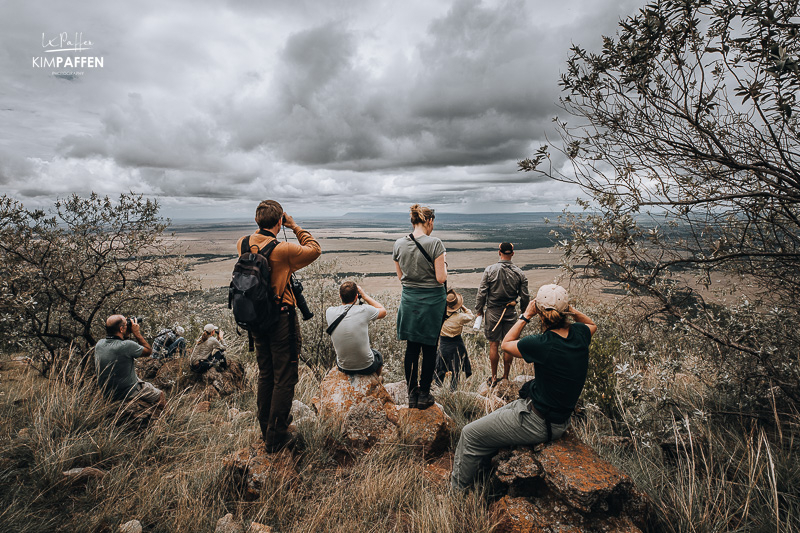
On safari, it’s smart to pack efficiently because you often travel around. Minimize your luggage by selecting versatile pieces that can be mixed and matched. Pack items that can easily be washed and dried overnight.
If you choose lightweight clothes, you can travel with a lighter bag. This is especially important when you travel around with charter flights , as most small planes used for moving between safari destinations have rules about how heavy your bags can be (often max. 10kg). Many African lodges offer laundry services, so you don't need to pack too much.
One clever trick is to bring safari clothing for hot weather and safari clothing for cold weather that can be mixed and matched and used as layers. Earth tones, like khaki and green, are not only great for blending in with the surroundings, but they also make it easier to put together your safari outfit.
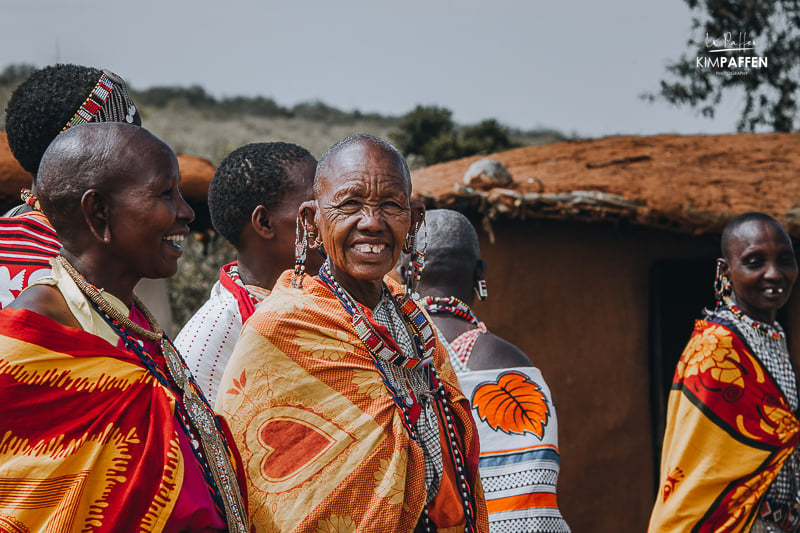
Moreover, leave valuable jewelry at home. Minimal jewelry is the way to go. It does not only enhance your comfort but also ensures your safety. Instead, by some colorful beadwork from the ladies that make beautifully handmade jewelry, like bracelets.
6. Wear Comfortable Footwear on Safari
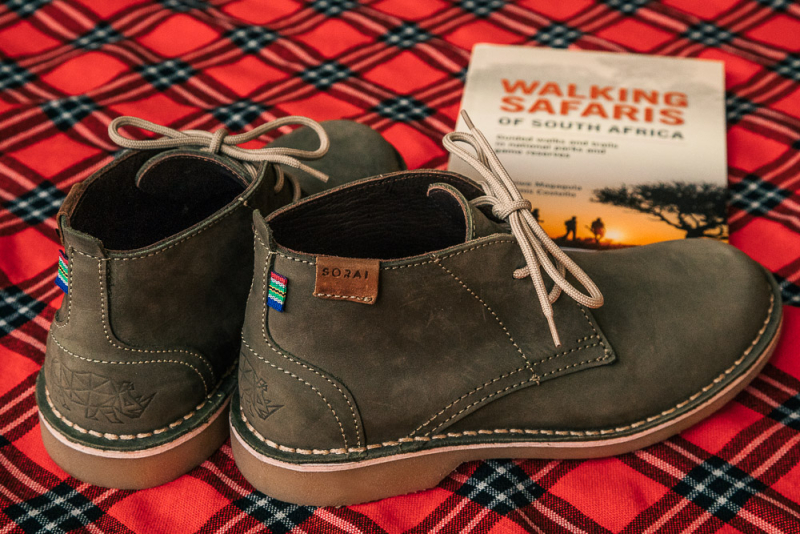
Make sure to bring along a comfortable pair of shoes to complete your safari outfit. Opt for sturdy, closed-toe shoes, boots, or vellies with good traction. You'll likely be walking on uneven terrain, so prioritize comfort and support to avoid discomfort and potential injuries.
The type of closed shoes you need depends on the type of safari and activities on your safari trip. For example, if you go on walking safaris, or if your safari involves gorilla trekking through muddy forests or hiking dusty terrain, it’s advisable to bring high-quality safari boots or hiking shoes with good grip worn with hiking socks and impenetrable soles, which can be useful to protect you from sharp objects like snares or thorns and from reptiles like snakes.
Some even wear gaiters for better protection from snake bites or ants. Depending on the terrain, I wear short olive-colored gaiters when encountering wildlife on foot in East Africa. For Gorilla Trekking in Uganda and Rwanda , I wear higher gaiters as you trek through dense vegetation than can be thorny and slippery with biting ants along the way.
If you're mainly going on a game drive in a vehicle, basic stable shoes, like lightweight trail shoes, are fine. If you're in an area with lots of bity insects and reptiles, it's wise to consider higher-rise hiking boots for added protection on safari. I prefer closed shoes on walks because of the insects and thorns but I'm also someone who loves to wear slippers on game drives. If you decide to wear sandals or slippers, please make sure to apply sunscreen on your feet.
One of my preferred safari shoes choices is the authentic South African Veldskoen boot. These shoes are handcrafted, comfortable, durable, and have a stylish touch. Many local field guides in Africa wear these boots too.
7. Respect Cultural Sensitivities
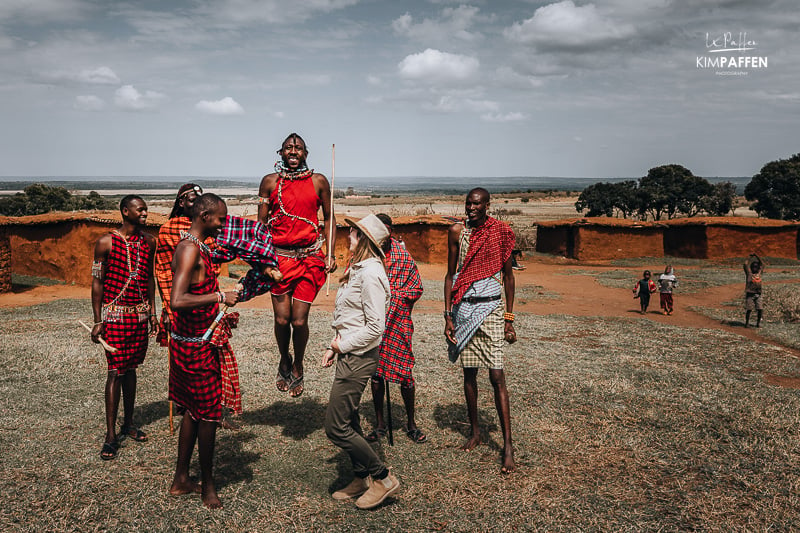
Respect local customs and traditions by dressing modestly , particularly if you'll be visiting communities or cultural sites during your safari. In (rural) communities, revealing clothing, such as short shorts or low-cut tops, can be considered disrespectful or offensive. If your safari includes visits to local communities , opting for clothing that covers your shoulders, arms, and knees is advisable.
If you have the opportunity to participate in local festivals or ceremonies, wearing clothing that aligns with the traditional attire of the community can be a sign of respect and can enhance your cultural experience.
8. Check the Camp or Lodge Dress Code
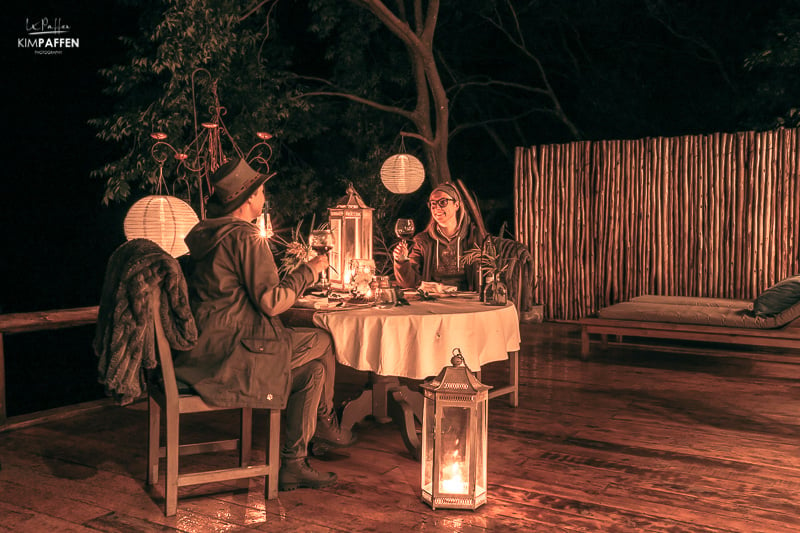
Most safari lodges and camps have a casual safari-style dress code . In that case, formal (evening) wear is not necessary to pack. If you prefer, you can change your safari outfit for formal evening wear, but in reality, most people go straight to dinner after arriving from the evening game drive.
On my first African safari , I used to go back to my room to take a shower and change my safari clothes . But I quickly learned that most people prefer to stay by the fire after the game drive while sipping on a glass of wine or cold beer as an after sundowner . From gazing into the fire and talking about your sightings with other guests, you go straight to dinner. Most safari days don't end extremely late as you have early morning game drives.
Some lodges or camps may have specific dress codes for certain activities or dining areas, so it is advisable to check the clothing guidelines of your lodge or camp in advance.
Frequently Asked Questions (FAQs) about what to wear on Safari
Can i wear shorts on safari.
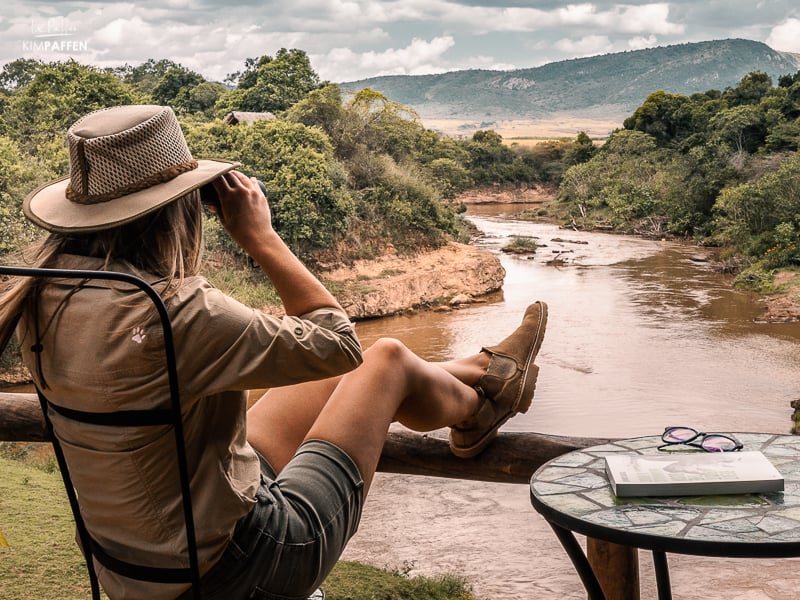
While shorts can be comfortable, long trousers are recommended for better protection against insects, thorny vegetation, and the sun, especially on safari walks.
Should I Wear Camouflage Clothing?
It's best to avoid wearing camouflage clothing as safari attire, as it's often associated with military or hunting activities, which may not be appropriate in wildlife conservation areas.
Are Hats Necessary on Safari?
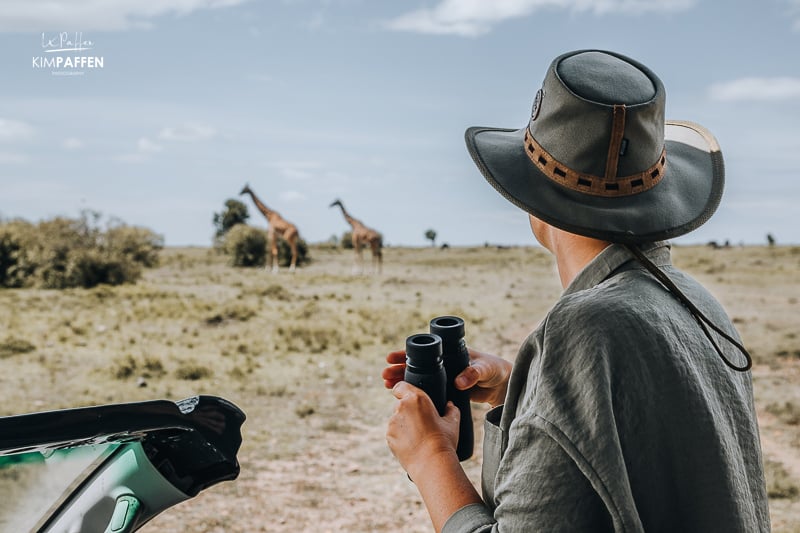
Yes, sunhats are essential for sun protection. Since most African safari destinations are located around the Equator, the sun is fierce! I therefore recommend wide-brimmed styles to shield your face and neck from the sun's rays. Additionally, I always recommend applying sunblock between 30 and 50 spf.
What is a stylish Safari Hat?
Rogue Hats are a popular choice to wear on safari. These safari hats are not only stylish, but also practical for protecting yourself from the African sun. They are known for their quality and durability. Many safari-goers appreciate the wide brims of Rogue Hats, which offer excellent shade and sun protection. If you're looking for a blend of fashion and function during your safari, Rogue Hats are a fantastic option to consider.
What are the Best Safari Clothing Brands for Women?
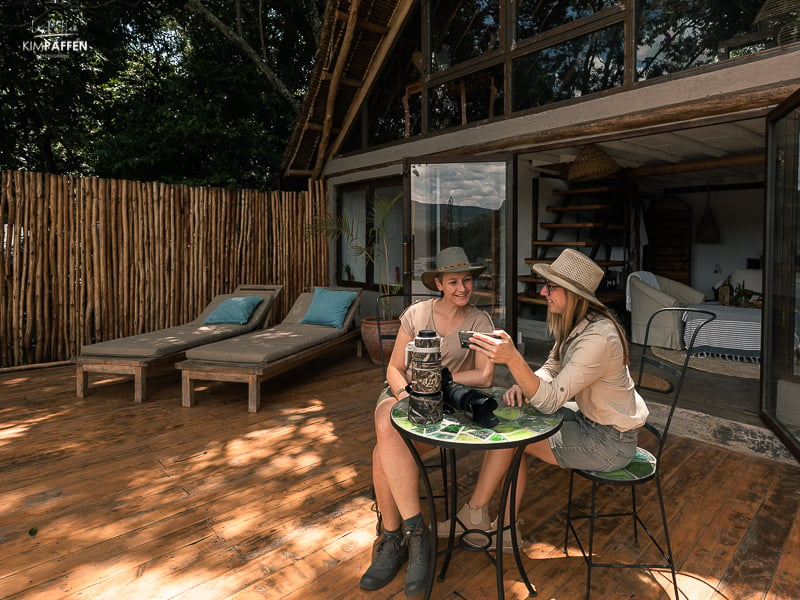
For women, it can be tough to find a stylish women's safari outfit as most affordable safari clothing is designed with men in mind (sold as unisex). The best safari clothing for women is also very subjective, but I love to wear for example the "Tayla Jane Range" of RuggedWear, designed by and for women. RuggedWear is among the most popular safari clothing brands, especially in South Africa . Another brand I love is Fjällräven. This is not a safari clothing brand and doesn't fall under the category cheap safari outfits, but a great outdoor clothing brand with sustainability in mind.
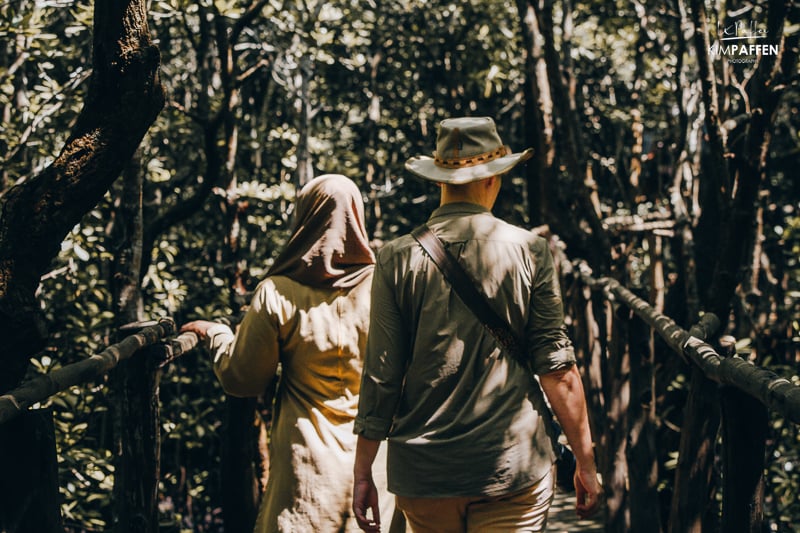
One of my favorite safari essentials is a lightweight green jacket made of thermal and water-repellant material. It's from the luxury Italian clothing brand Colmar. The side pockets and a practical adjustment drawstring make the jacket feminine and functional for safari.
Closing Thoughts: The Best Safari Outfit to Wear on Safari

Safaris are extraordinary adventures, and your attire plays a significant role in ensuring a memorable and enjoyable experience. By selecting the right clothing and accessories, you can fully immerse yourself in the safari experience. Crafting the perfect safari outfit is all about finding the right balance between comfort, functionality, and respect for the environment and local culture. Choose safari clothing with moisture-wicking properties , and lightweight earth-toned fabrics for practicality and blending in with nature on the various safari activities.
Safari Packing List
Curious about what other things to pack for safari in Africa? I crafted a complete safari packing guide about what to pack for safari in Africa or have a look at the safari packing list below.
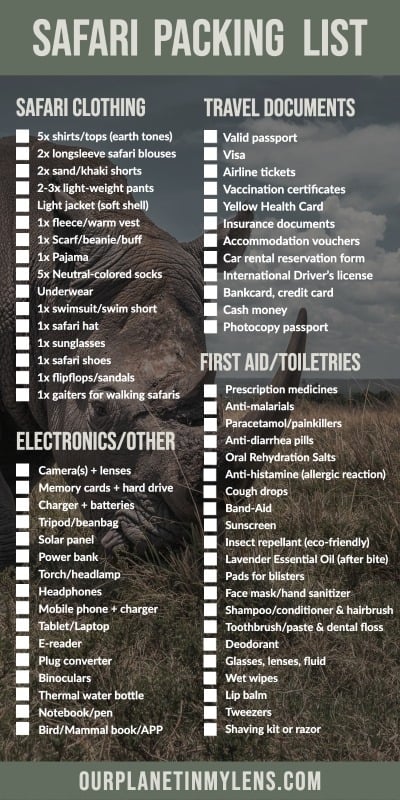
In conclusion, by following these safari clothing tips and considering your destination's specific climate and activities, you'll not only be ready to embrace the wild wonders of Africa but also ensure a more comfortable and culturally sensitive journey. So, pack wisely, explore passionately, and make the most of your safari in style, wearing a safari outfit that is comfortable and fashionable. Please feel free to leave a comment if you have questions or tips about what to wear on safari.
"Safari Njema!" (Save travels in Swahili ).

What To Wear On Safari: My Detailed Safari Packing List With Photos
Written by BELLA FALK
You’ve all seen the brochure photos: a smiling family is sitting at a camping table in the middle of the African bush. Behind them, the sun is setting, and perhaps a giraffe is crossing the savanna landscape.
Contents (click to view)
What are they wearing? I’m sure you can picture it: lightweight designer safari gear, all matching, in indistinguishable shades of beige, taupe and camel. Maybe the dad is wearing khaki chinos and the mum has a floppy-brimmed hat (colour: putty) on her head. They all have sand-coloured lace-up boots on, and from head to toe all their clothes are pristine, clean, and crease-free.
If it’s your first time figuring out what to wear on safari, it might feel like this is the model you have to follow. Like, having booked the blindingly expensive trip of a lifetime, you now have to go out and splurge hundreds more on the ‘proper’ kit, otherwise people will laugh at you and you may even get into trouble for not doing it right.
Well I’m here to reassure you: that’s rubbish.
What should you wear on safari?
I’ve been on five safaris (to Kenya , Botswana , Tanzania , Uganda and South Africa) and I still don’t own any ‘official’ safari clothes. I’ve always worn stuff I already own and been just fine.
That said, there are some dos and don’ts about packing for a safari, some things it’s a good idea to make sure you bring with you, and some stuff you should definitely leave at home.
So welcome to my complete safari packing guide. I’m going to go through a few points and FAQs, and then make a handy list at the end. Scroll down if you just want to skip ahead to that.
What happens on a safari?
Days on safari follow a similar schedule. You wake early and head out shortly after sunrise for a morning activity – usually a game drive but sometimes a boat cruise, guided walk, or scenic flight.
You return to the camp mid-morning for brunch and have some hours to relax in the heat of the day before heading out again for another activity later in the afternoon. Your afternoon game drive or boat cruise normally ends with sunset drinks in a beautiful location, before you head back to the camp for dinner.
After dinner you might sit round the campfire or boma enjoying a few drinks with your fellow guests, but most people go to bed fairly early, ready for another dawn start the next day.
Read more: Top 50 African Birds: A Safari Photo Guide
What to wear on safari during the day
The most important thing to note is that a safari is not a fashion show. It can be hot and dusty, or rainy and muddy, so it’s important to dress for comfort and practicality, so leave the designer gear, luxury fabrics and bling jewellery at home. Instead, bring stuff that washes easily, dries quickly and hides the dirt well!
You’ll also be coating yourself daily in suncream and insect repellent, so don’t bring anything that won’t mix well with those!
When I was in Botswana in December, some days reached 40 degrees C (104 F) with high humidity, so think lightweight breathable fabrics like cotton, viscose or sweat-wicking sportswear, or even linen if you don’t mind the creases).
T-shirts and shorts are your friends, but I’d avoid strappy vests for two reasons:
- Many African countries are quite conservative, and it doesn’t do to flash a lot of skin.
- The sun is extremely strong and the more skin you show, the more of you there is to get burned, even in a shaded safari car.
What to wear on a game drive or boat cruise
On wildlife viewing trips you’ll be sitting in a car for several hours, so it’s important to be comfortable. T-shirts and shorts are a great option.
Early mornings in Africa can be chilly, so bring a long-sleeved shirt, light sweater or jacket just in case.
Don’t forget your hat and sunglasses. Safari cars have roofs, but sometimes the roof rolls back so you can stand up, and when the sun is low in the sky it can shine in from the side very strongly. I was surprised by how much I ended up needing my hat.
Since you won’t be walking around much, light sneakers or sandals are fine.
Safari cars are open-sided, so if it rains you may get a bit wet. Most safari companies carry ponchos in the car, to hand out to guests when it rains, but you might want to bring your own light waterproof raincoat just in case.
What to wear on a walking safari
For a walking safari the principles are the same, but you should wear long trousers to prevent your legs being cut or scratched by branches, and closed-toed shoes to protect you from biting or stinging animals or insects.
Although walking safaris can sometimes last for three or four hours, you don’t actually walk that far because there’s a lot of stopping and looking at stuff. So you don’t need hiking boots; comfortable trainers or walking shoes are fine. If you’re travelling in rainy season you might want to bring waterproof or Gore-Tex ones.
Read more: 46 Amazing African Safari Animals – A Photo Guide
Do I need warm clothes on safari?
We think of Africa as being hot, and it is, but it can also be extremely cold. If you travel during the northern hemisphere summer, that’s winter in most of Africa, and temperatures can drop below freezing especially in desert areas, if you’re at altitude, and the further south you go.
In Botswana and South Africa during the winter, average nighttime temperatures can be 0 or even -2 degrees C (28-32 F), and remember that most safari cabins and tents are not heated!
Even in Kenya, which is much closer to the equator and therefore not as cold, nights and early mornings can definitely be chilly.
Staff in camps will provide you with hot water bottles and blankets both in your tent and on game drives, but you still need to bring warm clothes with you as well.
If you’re travelling to the southern African countries between April and October, I’d recommend bringing at least one pair of long trousers, one long-sleeved top, one jumper, and a packable down jacket.
But remember to dress in layers, as the day quickly warms once the sun’s up, and even if it’s close to freezing during the night, afternoon temperatures can ramp up to high 20s (70+ F) or more.
It’s very important to check the weather forecast before you travel, as different regions’ climates can vary.
What colour should you wear on safari?
It’s recommended that you wear plain designs in neutral, earthy or natural colours, such as shades of beige, grey, brown or natural greens.
Avoid vibrant, bright colours like orange, red and yellow, or vivid patterns. This is for two reasons:
- It helps to make you less noticeable to animals.
- You can get pretty dusty on safari, and natural shades don’t show the dirt so much!
Bright white and full black are also not recommended. This is not only because they show the dust really badly, but because many animals actually only see in black and white, and large gleaming white shapes or dark black ones are very noticeable to them.
With that all said, I wouldn’t worry about it too much, and you certainly don’t need to rush out and buy an entire new wardrobe full of khaki and beige. As I just mentioned, many animals only see in black and white, and when you’re inside the car, most only see the car as one large object, and not the people inside.
It’s more important to stick to the rules when you’re on a walking safari and don’t have the protection of the car.
But in general, if you pack plain, neutral-ish colours, you’ll be fine.
Why not wear blue on safari?
Some people recommend not wearing blue on safari. Apart from being a pretty noticeable bright colour, it’s said to attract tsetse flies, which are prevalent in some areas of southern Africa and can deliver a nasty bite and spread disease. They are also thought to prefer black (another reason not to wear it).
That said, my light down jacket is bright blue, and I also took a blue t-shirt and a pale blue cardigan to Kenya, and I wore all three with no problems.
Read more: An Epic Uganda Itinerary In 2 Weeks
What to wear on safari evenings
Most people like to dress up when they go on holiday, so you might think about throwing a few glamorous dresses, high heels or some party shirts into your suitcase.
But you probably won’t wear them. Even in the luxury camps, most people really don’t dress up for dinner, for four main reasons:
- At night it’s a good idea to cover your arms and legs to avoid insect bites, so floaty skirts and strappy tops are a bad idea.
- It can get quite chilly at night, so you’ll probably be more comfortable in trousers and a fleece anyway.
- You’ll be tired after a long day and an early start; you’ll probably find you can’t be bothered to dress for dinner as you’ll be going to bed soon afterwards anyway.
- Walking round camp after dark you may run into snakes or spiders, and paths can be muddy and uneven, so high-heels are a definite no-no.
When I was in Botswana in December (the height of their summer) it was still 30+ degrees (86 F) in the evening, so I wore lightweight trousers or a long casual dress and then liberally coated myself with insect repellent. In Kenya in September it was a bit cooler, around low 20s (70 F), so I wore trousers, a t-shirt and a light cardigan, and had my jacket handy for later in the evening as the temperature dropped.
Is it OK to wear jeans on safari?
It’s perfectly fine to bring a pair of jeans for the cooler evenings, especially if you’re travelling in winter when you know it will be chilly at night.
However jeans aren’t recommended for game drives as you’ll probably be too hot in them during the day, and if you need to wash them they’ll take ages to dry.
As a general rule I wouldn’t take jeans on safari but instead bring lightweight trousers. The convertible zip-off ones that turn into shorts are especially good as you can have long pants for cold mornings and safari walks, and convert them into shorts once the day’s warmed up.
Pro tip: Whatever you choose to bring, make sure you have some ‘room to grow’! The food on safari is usually really good and you won’t be doing much exercise, so stretchy waistbands are a good idea!
Can you wear leggings on safari?
Yes, absolutely. Leggings are a great thing to bring on safari because they’re lightweight, wash and dry easily, are comfortable, and protect you from bugs and the sun. Just stick to neutral colours and leave the snazzy activewear designs at home!
I always pack a pair of leggings for safari – and if there’s a gym in the hotel then I can also use them for a workout!
What are the best shoes to wear on safari?
As I mentioned above, high heels and smart shoes are definitely not the thing to bring on safari. For game drives it’s fine to wear sandals or light sneakers, and for safari walks you want closed-toed comfortable walking shoes. You definitely don’t need to buy special safari boots, no matter what the sales people might say.
If your lodge or hotel has a pool, you might want to bring some flipflops (also handy to have for walking around in your tent at night, or for nipping to the bathroom block if you’re staying in a campsite).
Can you wear trainers on safari?
Yes, absolutely. I always pack a pair of Asics Gore-Tex trail trainers that I wear for exercise, when it’s muddy or raining, and for walking or hiking. On game drives and boat cruises, and for walking around the camp in the evening, I have a pair of Skechers Go-Walk sneakers that are super comfortable and easy to slip on and off.
Read more: Kenya Vs Tanzania: Travel Experts Decide
What to pack for the beach in Kenya or Tanzania
Many people like to combine their safari with a few days on the beach, perhaps in Zanzibar in Tanzania, or at Diani or Vipingo in Kenya .
Here’s where you will get the chance to dress up a bit – as if you’re staying in a nice hotel or beach resort destination, there will definitely be opportunities to put on a strappy dress, holiday shirt, or some sparkly sandals.
If you’re planning to hit the beach for a few days at the end of your trip, you’ll definitely want to throw in one or two nice evening outfits. And don’t forget swimwear and a beach cover-up too!
Can you wash clothes on safari?
This is a very important question, and the answer is yes! Almost all safari lodges and camps offer a laundry service and most of the time it’s included in the price of your stay. So you can wash your clothes as often as you like at no extra cost – which means you really don’t need to bring huge amounts of luggage as you can wash and re-wear your clothes several times.
Note that in many places the laundry is done by hand by the hotel staff, dried out in the sun, and ironed using an old-fashioned coal iron. This is yet another reason not to bring anything too delicate or precious, as there’s a small chance it may get damaged during the laundry process.
What sort of underwear should I bring for safari?
Ladies: remember that you may spend many hours bouncing around over unsealed and bumpy roads in the back of a safari car. Being quite an athletic build, this is not something that’s ever bothered me, but I’ve been reliably informed by more curvy girls that a sports bra can be a life-saver in this situation. So if you’re particularly susceptible to bouncing, bring sports bras!
It’s also important to note that the people who handwash your clothes are usually male, and for cultural and hygiene reasons they won’t wash women’s underwear. Ladies will need to bring a small amount of hand wash (though sometimes laundry soap is provided) and wash your own pants and bras in the basin. For this reason it’s a good idea not to bring anything too fancy or delicate: lightweight, quick-drying microfibre underwear is best.
Read more: Chimpanzee Trekking In Uganda: A Breathtaking Wildlife Adventure
Other things to pack for safari
Of course, packing is not all about clothes. Here are a few other things you won’t want to forget (more in the complete packing list below):
Camera, spare batteries, chargers, plug adapters
Can you imagine going all that way on safari on the trip of a lifetime and then forgetting your phone charger or camera? I know, I’d die!
So definitely make sure you pack all your gadgets, and all the cables and plugs you’ll need to make them work! And then bring spares!
Often hotel rooms and safari tents only have a limited number of plug sockets, so if you have loads of gadgets, it’s a good idea to bring a multi-socket splitter. I recommend one with surge protection : power cuts can happen frequently and if there’s a surge when the power comes back, your devices can get fried. This happened to me the night before my Tanzania safari , so now I’m extra careful!
Medication and toiletries
Most of the places you’ll be staying will be out in the bush, with limited access to shops. Make sure you bring all the toiletries, medicines and personal items you’ll need, as once you leave the airport, opportunities to replace anything that’s missing will be very limited.
Do you need malaria tablets for safari?
Large parts of Africa have malaria, including popular safari countries like Kenya, Tanzania, Uganda and Zimbabwe, so it’s very likely that you may need to take malaria tables on safari. I usually take doxycycline which is cheaper than malarone, but may not be suitable for everyone so speak to your pharmacist or travel clinic.
You can check the malaria risk for the country you’re visiting, as well as any other vaccine requirements at the Travel Health Pro website here .
Some countries also require you to have a proof of yellow fever vaccination – you can check if this is needed on the website above as well. For example, places like Kenya and Tanzania won’t let you in without proof of vaccination if you’ve spent time in a yellow-fever-risk country before arriving. If you have already had your yellow fever jab, make sure you pack the certificate!
What to wear for safari in Tanzania
If you’re planning your safari in Tanzania or Kenya as part of a trip that also involves climbing Kilimanjaro (or any other mountain), then check out my essential Kilimanjaro packing list here .
Best suitcase for safari
This is important, so pay attention! Many safaris involve internal transfers by tiny plane or even helicopter. They all have pretty strict packing rules, with a maximum of 15 kg weight per person and no hard-shelled suitcases allowed. Luggage must be soft sided, and don’t overpack! You shouldn’t need to anyway, since you can wash everything when you’re there.
Wheels are OK as long as it’s a soft bag, so I recommend a soft holdall with or without wheels, or a wheely backpack like the one I have and love . This one came to Kenya and Botswana with me with no trouble at all.
Read more: Nature Vacations: 25 Amazing Places For An Outdoors Adventure
Packing for safari for photographers
If, like me, you’re travelling with 15 kg of camera gear, don’t stress. The little internal plane operators are used to photographers and will let you put your backpack of gear at the back of the plane. I travelled with 15 kg of hold luggage and another 15 kg of camera gear around Botswana and Kenya, and it was never an issue.
There’ll be more on safari camera gear in a separate post, coming soon!
Meanwhile, for safari photography tips, check out 40 Safari Photography Tips For Stunning Wildlife Photos .
What should you NOT take on safari?
Now I’ve told you all the things you should bring on safari, here are a few things it’s a good idea to leave at home.
Perfume: No one in your safari car will thank you for dosing yourself liberally with Eau de Whatever, and if you wear a very strong scent it may even allow animals to detect you sooner and run away faster.
Hairdryer: Many safari camps run on solar power and cannot support a hairdryer. Those that can (if they’re on the grid, or running off a generator), will usually provide one that’s suited to the electricity supply. As I said, no one really worries too much about their appearance or cares about what your hair looks like on safari anyway.
Camouflage clothing: This might surprise you, but wearing military-style camo print clothing is a no-no in many African countries, where it’s associated with the military. It’s actually illegal to wear camo gear in Ghana, Uganda, Zimbabwe and Zambia.
Plastic bags: Disposable plastic bags are banned in Kenya, Uganda, and Rwanda. You should be fine with the little zip-lock one for your liquids on the plane, and I’ve used reusable plastic packing bags many times with no problems, but try to keep plastic bags to a minimum or you may get a fine.
A drone: Unless you have special permission, drones are not allowed in most lodges and African National Parks.
Expensive watches, jewellery, and other valuable items: This doesn’t just apply to African safaris but to all travel. Jewellery can easily get lost, damaged or stolen, so if you care about it, leave it at home.
A hard-shelled suitcase: As mentioned above, all safari companies ask you to bring a soft bag or at most a wheeled soft holdall , as these are much easier to pack into the small luggage spaces on planes and in cars. You will not be thanked if you bring rigid-sided luggage.
Where to buy safari clothing
For the most part, you don’t need any specialist clothing for safari. You can wear your own normal clothes. However, there are some great companies that do excellent clothes for travel, in suitable colours, and made from practical fabrics that are sweat-wicking, comfortable and don’t crease.
My favourite brands for travel clothes are The North Face , Patagonia , Rab , Mountain Equipment , Arc’teryx and Craghoppers , and my favourite places to shop in the UK are Ellis Brigham and Cotswold Outdoor , which stock all these brands at competitive prices, have high-street stores where you can get advice and try stuff on, and often have good end-of-season sales too.
What to wear on safari: my Africa packing list
So now we’ve gone through the details, here’s what I would pack for a 10-day or two-week safari in Africa.
What to wear on safari: Clothes
- T-shirts in neutral or earthy colours x 5. The green t-shirt in the photo above is by Mountain Equipment . I love it so much I bought three!
- Long trousers x 1 pair. I really like my lightweight ones from The North Face .
- Shorts x 1 pair.
- Convertible trousers that zip-off into shorts, or a second pair of shorts . North Face and Craghoppers both do good convertible trousers for men and women .
- Leggings . I’m a big fan of Sweaty Betty.
- Long-sleeved shirt for covering up in bright sunshine.
- Lightweight jumper or cardigan for chilly evenings.
- Lightweight jacket , fleece or mid layer for cold nights. I have a fleece from Arc’teryx and a mine is a Nano puff from Patagonia .
- Waterproof jacket . I have two, a lovely Zeta LT by Arc’teryx and a packable Meridien jacket by Rab .
- Dress or smart shirt for the evening if you’re going to a city or the beach (x2). For packable jersey or lightweight viscose dresses I love Boden , Sugarhill Brighton and Joanie Clothing .
- Gym kit – if you think you’ll need or use it. But many safari camps don’t have fitness equipment and you can’t go for a run in the bush or you might get chased by a predator!
- Sports bras or comfortable wireless bralettes x 3.
- Underwear x 7. If you’re staying for longer you’ll need to handwash. I recommend something quick-drying and non-delicate like these microfibre ones from M&S .
- Swimwear . I get cute bikinis and swimwear from M&S , Next , or Pour Moi .
- Sarong or cover up (if you’re spending time on the beach)
- Sandals or flip flops . I love my walking sandals by Teva .
- Trainers or walking shoes for exercise and walking safaris. Mine are Gore-Tex trail trainers from Asics .
- Soft sneakers for walking round the camp, game drives and boat cruises. I’m a big fan of Skechers Go Walks .
Pro tip: if you’re going to the beach and plan to do a lot of snorkelling, pack a rash vest or t-shirt to swim in. The sun is super strong and we all got very burnt even though we were wearing Factor 50!
What to pack for safari in winter
If the forecast is for cold weather, I would add:
- Another long-sleeved top or baselayer .
- A warmer, packable insulated jacket .
- A pair of jeans.
- Beanie hat.
What to pack for safari: Accessories
- Baseball cap or hat. My cap is this one this one by Buff and I really like it.
- Scarf or buff to keep dust off (and you can dip it in water to cool you down on very hot days)
- Headphones or ear buds (for the plane), you won’t need them on the actual safari! I have these ones which are pretty good and much cheaper than Apple ones.
- Eye mask and ear plugs (if you’re a light sleeper).
- Camera, batteries, memory cards and charger
- Charger cables for all your devices
- Portable phone charger. Mine is this one from Anker .
- Plug adapter for the country you’re going to, or a universal plug adapter
- Plug splitter or 3-way adapter with surge protection
- Refillable water bottle (though some safari companies provide them, so check). An insulated water bottle will keep your water colder for longer on hot days.
- A padlock for your luggage to protect you from airport thieves
Safari packing list: Toiletries
As well as all your usual toiletries and medications, don’t forget:
- Suncream. I swear by Riemann P20 because it’s hard wearing and you only need to apply it once a day. Or for the best face SPF you will ever find, that’s non-greasy and non-orange (!), I love this one from the Body Shop .
- Insect repellant (though this is often provided in camp).
- Malaria tablets ( check to see if these are required in your destination )
Pro tip: Luggage goes missing more and more frequently these days, so pack your medication or anything else vital in your hand luggage.
Where to next?
If you liked this post, why not try some of my other safari and Africa posts?
- Leroo La Tau In Botswana: See The Incredible Zebra Migration
- Uganda Animals: The Amazing Wildlife of Uganda
- Ol Doinyo Lengai Tanzania – Climb the Terrifying Mountain of God
- Entebbe Zoo – Uganda’s Wildlife Education Centre
- An Epic Uganda Itinerary In 2 Weeks
Liked this post?
Social shares help support my hard work! You can share via the buttons at the bottom, or pin this handy Pinterest Pin. Thank you!
46 Amazing African Safari Animals – A Photo Guide
Is cardamom house in vipingo the best beach hotel in kenya.
Some of the links on this site are affiliate links. This means that if you click through and make a purchase, I will earn a small commission at no additional cost to you. Passport & Pixels is a participant in the Amazon Services LLC Associates Program. As an Amazon Associate I earn from qualifying purchases.
© 2024 Passport & Pixels. All Rights Reserved.
WORK WITH ME
Best safari clothing: brands, clothes & tips for African safaris

You’re off on safari! You’ve done all the research , purchased the guide books , and the tickets are hot in your hand.
But most importantly, you’re getting ready to pack your ultra-light bag with everything you’ll need for your trip of a lifetime.
You’ve read all the advice you can handle (perhaps even this post on how to pack for safaris for your African bush adventure).
But when it comes down to the line, you still have no idea whether your favorite sweater is going to be a help or a hindrance, if you should pack jeans, how many pairs of socks are enough, and what on earth to expect once you are out in the wild.
What to wear on safari is something of a conundrum , the answer to which is entirely dependent on whether you are a complete slave to fashion and constantly worry about your appearance.
Or whether you don’t care if your trousers absolutely match your shirt and if your shoes co-ordinate properly with your camera bag.
So, in a bid to help sort the wheat from the chaff when it comes to safari style, this guide aims to highlight the best safari clothing brands and tips for your next trip to Africa .
African Safari Clothes: 7 Useful Tips
The African savanna has seen virtually every take on both the best and worst dressed safari goers , including some of the most practical and impractical safari gear around.
This includes everything from haute couture animal prints hot off the Milan catwalk, to Prada stilettos getting stuck in between the slats of wooden decks, and $300 silk scarves ripped to shreds by thorn bushes.
There are also tales of wild baboons getting hold of Victoria’s Secret lingerie and leaving it draped for all to see high in the branches of an acacia tree.
There are plenty of stories about complete wardrobe disasters—but to ensure you’re not one of them, here is a list of useful tips on how to dress for safaris .
1. Leave the luxury safari clothing at home
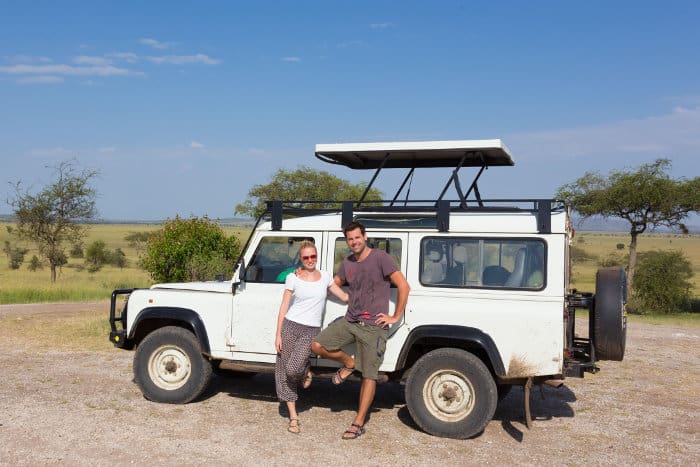
Lesson 1 in safari style is to NEVER take your best clothes into the bush .
If you find a pair of shorts, trousers, or a top you love and know that it would break your heart to have it ruined on safari, it’s probably best to leave it at home .
Instead, look for clothing that is specifically suited for the wild . And if the item comes in different colors, buy the range!
This way, over the years, you’ll acquire a variety of clothes which come everywhere with you. Look out for clothes that you can team together to create practical yet stylish outfits.
2. Keep your clothes for safari simple
Lesson 2 is learning how many of each item you will need . As a rule of thumb, always go with four of the basics.
Four pairs of shorts , four pairs of cut-off pants , four string vests , four t-shirts , four pairs of long pants , four button-through shirts (two of which are long-sleeved), four sets of underwear , four pairs of socks … you get the drift, I am sure!
When traveling in winter or during the colder months of the year, add to this scenario two lightweight long-sleeve t-shirts and two knitted sweaters , plus two fleeces or warm jackets , thermal long johns , gloves , a scarf , and a beanie .
When considering your safari apparel, ALWAYS pack a swimsuit and a couple of sarongs/kikoys . Even in the winter, it’s usually warm enough to suntan during the day and sometimes even swim.
3. Your safari wear should include comfortable shoes
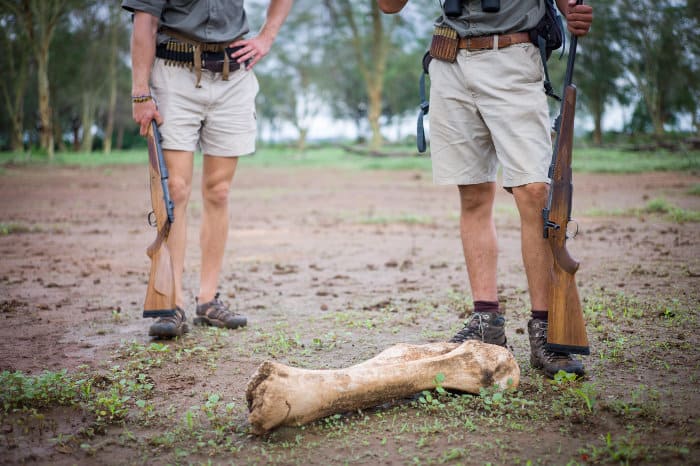
Lesson 3 concerns footwear . In the heat of the summer, it is best to pack at least two pairs of “bush slops” – flip flops (thongs) which are heavy-duty, waterproof, and good enough to handle walking in the light bush for game drives.
You may also need two or three pairs of fashionable flip-flops or sandals for around camp and evening meals, and a pair of good walking shoes ( Merrells ) for walking safaris.
In the winter, replace the walking shoes with walking boots and add a pair of lightweight faux-fur lined “trendy” flat boots for evening wear.
4. Safari fashion: accessories
Accessorize – that’s the key to lesson 4 – it’s the difference between a good safari wardrobe and a bad one. Two or three lightweight colored scarves and/or wraps are a must in any safari bag .
Usually, they have beadwork or applique of some description on them. These are useful for dressing up even the most conservative safari outfit—great if you’re looking to add a dash of glamor to your evening meals. Team them up with a couple of great “ethnic” bead necklaces and earrings .
Another essential item to include with your safari attire is a hat —and these can most certainly be fun. Pack in a couple of lightweight, floppy straw sun-hats, as these are great for game drives or tiger fishing.
Another good option is the usual peak baseball-style caps.
5. What to wear on safari – quality
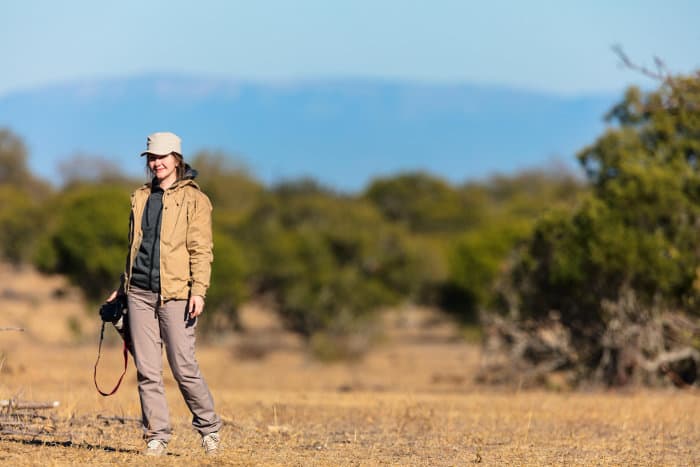
Lesson 5 is all about quality . Everything you take into the bush with you needs to stand the test of time.
This includes the elements of the African wild, the rigors of hand-washing, and bumping and grinding in the back of a safari vehicle halfway across Africa.
So it’s important to check your clothes before you pack to make sure they can be hand-washed, aren’t going to fall apart the first time you wear them, and are not likely to fade too drastically when hung in the sun to dry.
The material of your clothing is also important. When out in the wild, it is best to stick to strong natural materials like hemp , linen , leather , and wool .
Nylon and polyester also tend to provide adequate protection against the elements.
6. Best safari clothing brands
Wondering where to buy safari clothes? Most of the high-street fashion chains carry good quality fashionable safari clothes which will stand up to the average safari conditions.
As such, you may be able to avoid the need to go to specialist outfitters and camping/outdoor stores where things tend to cost a lot more.
And, of course, the big brands like Jeep (a favorite with safari goers because their clothes are practical, hard-wearing, and pretty at the same time) and Cat always have some great clothes for safaris—including some of the best safari shirts.
In addition to these, here are several more reliable brands to consider when buying safari clothes:
- Columbia — this is a good option for those seeking affordable safari clothing that is still good quality.
- First Ascent — if you’re buying safari clothes in South Africa, keep an eye out for this brand as it offers some excellent quality clothing.
- Patagonia — while the brand is more expensive, they provide some of the highest quality outdoor clothing and gear on the market.
- REI — if you’re shopping online, REI is often the go-to for outdoor gear. Their house brand is affordable and offers many items that will serve you well on your safari.
- Ruggedwear — proudly South African, it is an official partner of the Field Guides Association of Southern Africa (FGASA).
- Sapmok — footwear for every adventure. Comfy. Durable. And stylish.
7. What color clothing for African safaris

Finally, lesson 7 concerns white . Do you take white clothes into the bush with you? Hell yes.
As long as you don’t expect them to remain white for long and can accept the fact that no matter where you wear them, they’re bound to get a little dirty. It’s more or less a bush essential in my book because it reflects sunlight , keeps you cool and goes with everything .
Everyone says, “don’t wear white on a safari vehicle,” – but this is far from the truth. However, white isn’t the only color that’s good for safaris.
When dressing for safaris, the basic color range is simple: khaki , beige , white, and brown (or variations thereof).
Avoid black and blue during the day because they attract tsetse flies .
But do occasionally take these colors for evening wear when the tsetses have gone to bed.
What to Wear on an African Safari: Checklist
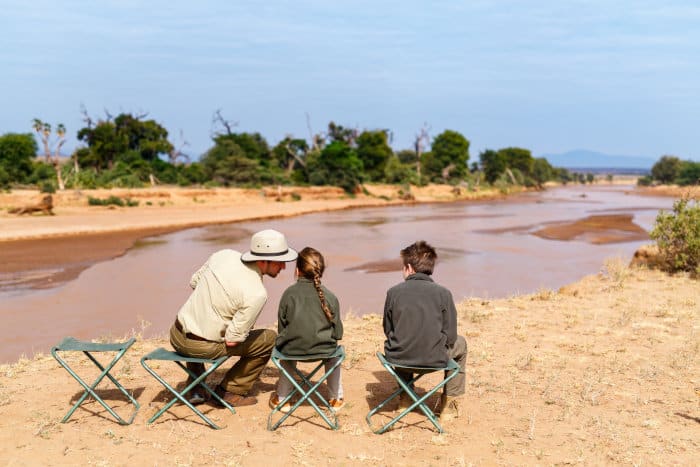
Now that you’re all clued up with what to consider when deciding what clothes to wear on a safari, it’s time to pack.
Here’s a checklist to ensure you don’t miss anything.
Africa safari clothing list
Below are some of the most essential pieces of clothing to bring along on a safari:
- 4 safari shirts
- 4 casual t-shirts or vests
- 4 safari pants or shorts
- 4 pairs of blister-proof socks for safari walks
- 3 pairs of pajamas
- 2 warm fleece tops or jackets (good for a summer or winter safari outfit)
- 2 pairs of flip-flops or sandals (one for the wild and one for at the lodge)
- 2 safari dresses (for at the lodge)
- 2 swimming costumes
- 1 waterproof jacket
- 1 kikoy or sarong
- 1 wide-brim hat or baseball cap
- 1 pair of safari shoes or boots
Safari gear and accessories list
In addition to clothing, you should include the following items when packing for a safari:
- 4 pairs of anti-chafing tights (good for walking safaris)
- 2 pairs of garden gloves (useful for gorilla trekking safaris)
- 2 pairs of ankle gaiters
- 1 pair of sunglasses
- 1 bottle of sunscreen
- 1 safari belt
Start Packing Your African Safari Clothing
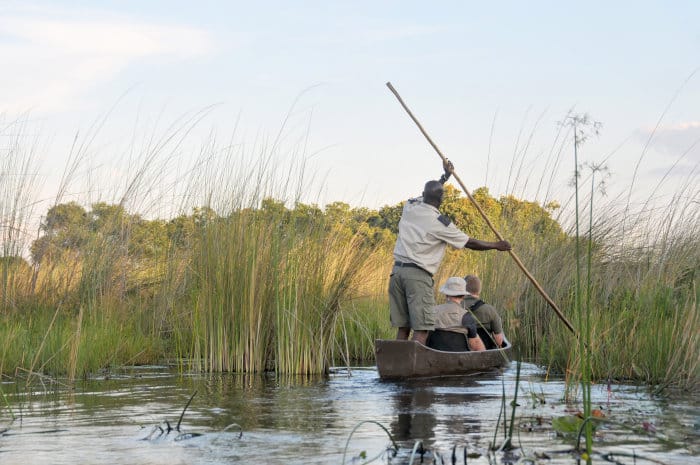
There’s nothing quite like getting down and dirty on an African safari. Whether you’re going on a game drive or a walking safari, you’re sure to come in contact with the various elements of the wild—and not to mention the wildlife, too.
For this reason, having the correct clothing is important . This will protect you during excursions and allow you to blend in better with the natural environment.
So next time you’re contemplating what to wear on African safaris, review the list above . These useful tips will guarantee you have a pleasant experience, both at the lodge and in the bush.
So what are you waiting for? Check out these incredible African safari deals and start packing!
About The Author
Sharon van Wyk
Related posts.

African safari packing list – What to bring on a trip to Africa
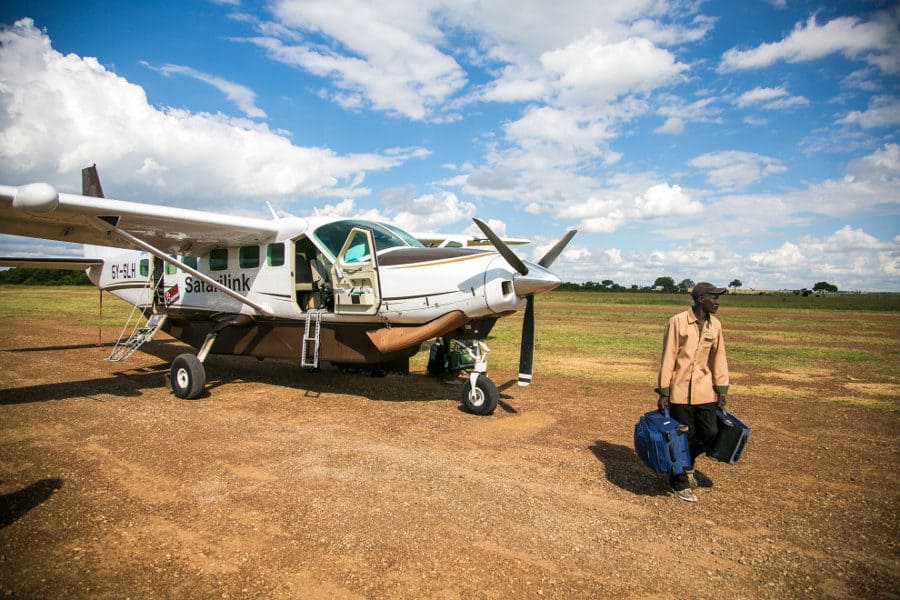
Best safari luggage – Duffel bags & backpacks for African travels
Leave a comment cancel reply.
Your email address will not be published. Required fields are marked *
African Safari Tours
- Arusha, Tanzania
- [email protected]
- Call/ Whatsapp +255 745504340

What to Wear on an African Safari: A Comprehensive Guide
What to wear on an african safari: a comprehensive guide..
An African safari is a dream adventure for many travelers. The opportunity to witness the magnificent wildlife, explore breathtaking landscapes, and immerse oneself in the rich cultures of Africa is an experience like no other. However, packing for an African safari can be a daunting task, especially when it comes to choosing the right clothing. In this comprehensive guide, we will walk you through what to wear on an African safari, taking into account the diverse climates, activities, and cultural considerations you may encounter during your journey.
1. Understanding the Climate
Africa’s diverse landscapes mean that the climate can vary greatly from one region to another. Before packing for your safari, it’s crucial to research the specific area you will be visiting and the time of year you plan to go. The best wildlife viewing months in Tanzania are during the Dry season from late June to October. The best chance of seeing the wildebeest migration in the Serengeti is during June and July and the time to see the wildebeest calving is late January to February. Tanzania’s main rainy season, or the ‘long rains’, last during about March, April, and May. Best East Africa Safari Clothes for Comfort and Protection. Here are some general climate zones you may encounter:
Tropical Rainforest: Hot and humid with frequent rain showers. Think Central Africa, like Uganda or Gabon.
S avannah: Warm to hot with distinct wet and dry seasons. East Africa Packing List What to Wear on Safari. Iconic destinations like the Serengeti fall into this category.
D esert: Extremely hot and dry during the day, but often quite cold at night. The Sahara Desert is a prime example.
C oastal: Moderate temperatures with ocean influence. Coastal regions like Kenya’s Mombasa offer a different experience.
Mountain: Cool to cold, with temperatures dropping at higher altitudes. Consider places like Kilimanjaro or the Drakensberg Mountains.
2. Layering is Key
Given the varying climates in Africa, layering your clothing is a smart approach. Layering allows you to adapt to changing weather conditions and temperatures throughout the day. Here’s how to effectively layer for an African safari:
Base Layer : What to Wear on an African Safari? Start with a moisture-wicking base layer to keep sweat away from your skin. This can be a lightweight, long-sleeved shirt and long underwear.
I nsulating Layer : Depending on the weather, exactly know what to Wear on an African Safari by add an insulating layer, such as a fleece or lightweight sweater, for warmth.
O uter Layer : What to Wear on an African Safari? Your outer layer should consist of clothing that is both breathable and weather-resistant. A light, waterproof jacket or vest is a great choice to protect against rain and wind.
3. Safari Clothing Essentials
3.1 neutral-colored clothing.
Neutral colors such as khaki, beige, olive green, and light brown are the go- to choices for safari clothing. These colors help you blend into the natural surroundings and minimize the chances of startling wildlife. Avoid bright colors and flashy patterns, as they can attract unwanted attention from animals.
3.2 Comfortable and Breathable Fabrics
Choose clothing made from breathable, moisture-wicking fabrics like cotton, linen, and lightweight synthetic materials. These materials will keep you comfortable in the heat and help regulate your body temperature. Ultimate Safari Clothing Guide- What To Wear On Safari in Africa, Complete African Safari Packing List [Checklist and Guide], The Ultimate African Safari Packing List, Safari Outfits Ideas That Are Easy & Affordable, The Comprehensive Guide to What to Wear on Safari, Safari Clothing – Expert safari packing advice and top tips, Women’s Safari Clothing for Africa Overland Travel.
3.3 Long-Sleeved Shirts and Pants
Long-sleeved shirts and long pants are essential for protecting your skin from the sun, thorny vegetation, and insect bites. Look for clothing with built-in UV protection for added safety against the sun’s harmful rays. What to Pack African Safari Packing List, 10 Things You Must Pack for Your Safari. What to Pack for an African Safari, The Ultimate Packing List for Your African Safari. Safari Packing List & What To Wear On Safari.
3.4 Closed-Toe Shoes
Comfortable, closed-toe shoes with good tread are a must. Choose lightweight hiking boots or sturdy sneakers that provide support for walking and exploring the terrain. Ensure they are well broken-in to prevent blisters.
3.5 Hat and Sunglasses
A wide-brimmed hat is essential to shield your face and neck from the sun. Sunglasses with UV protection will protect your eyes from the harsh African sun and glare.
4. Accessories and Gear
In addition to clothing, there are several accessories and gear items to consider packing for your safari:
Binoculars: A good pair of binoculars will enhance your wildlife viewing experience, allowing you to spot animals from a distance.
C amera and Accessories: If you’re a photography enthusiast, bring your camera and essential accessories like spare batteries and memory cards.
Reusable Water Bottle : Staying hydrated is crucial, so carry a reusable water bottle to reduce plastic waste and ensure you have access to clean water.
I nsect Repellent: Pack a reliable insect repellent to protect yourself from mosquitoes and other biting insects, especially in malaria-prone regions.
M edications : Carry any necessary medications, including antimalarial drugs if required for your destination, along with a basic first-aid kit.
P ower Bank : Ensure your devices stay charged with a portable power bank, as electricity availability can vary in safari lodges.
5. Cultural Sensitivity
Respect for local cultures and traditions is vital when it comes to clothing choices . While on safari, you may have opportunities to interact with local communities. Here are some tips for dressing respectfully:
Cover Shoulders and Knees: In many African cultures, it’s customary to cover shoulders and knees, especially when visiting villages or religious sites. Pack a lightweight scarf or shawl to cover up when needed.
Modesty : Avoid clothing that is overly revealing or provocative, as it may be considered disrespectful in conservative areas.
Remove Hats Indoors : It’s polite to remove your hat when entering someone’s home or a place of worship.
Ask for Permission : Always ask for permission before taking photos of local people, and respect their wishes if they decline.
Recommended Serengeti Safari Packing List/ Clothing to bring
T-shirts and tank tops Long-sleeved shirts (for protection from sunburns) Shorts Light long pants or convertible long-short pants Warm fleece pullover or jacket One swimsuit Cotton socks and underwear Pajamas One pair of comfortable walking shoes One pair of sandals or flip-flops Wide-brimmed hat Bandana (for dust) Heavy sweater, gloves, and toque if traveling in the cold season (June – August).
What to Bring on your East African Safari
Passport Plane tickets Travel Insurance Policy & Emergency Contact Numbers Yellow Fever Vaccination Certificate (if applicable) Safari itinerary U.S. dollars in large and small denominations ($20, $50 & $100 bills should be issued after 2005) Credit cards and ATM bank cards Sunglasses Sunscreen and lip balm Small flashlight or headlamp Insect/Mosquito repellent Eye drops and extra contact lenses or spare glasses (if applicable) Anti-bacterial hand sanitizer Tissue paper and small travel towel (washrooms in Tanzania often don’t have toilet paper or paper towels) Camera, extra memory cards, batteries, and charger, if applicable UK plug adapter and transformer/voltage converter, if applicable Ziplock bags for toiletries, camera equipment, snacks, etc. Personal toiletries
FAQs What to Wear on an African Safari
What should i wear on a safari in the summer.
In summer, lightweight, breathable clothing is essential. Opt for long-sleeved shirts and pants made from lightweight fabrics. Don’t forget a wide-brimmed hat, sunglasses, and sunscreen for sun protection.
Can I wear shorts on a safari?
While shorts are generally acceptable for safaris, it’s advisable to wear longer pants or convertibles for added protection against sun, insects, and vegetation. Bring a pair of shorts for more relaxed moments at the lodge.
Do I need to dress up for dinner at safari lodges and camps?
Most safari lodges and camps have a relaxed dress code, but it’s a good idea to check with your specific accommodation. Casual attire like khaki pants and a collared shirt is usually sufficient.
Are camouflage clothes allowed on a safari?
Camouflage clothing is typically discouraged on safaris, as it’s associated with military or hunting activities. Stick to neutral colors to respect the wildlife and local regulations.
What’s the best footwear for a safari?
Closed-toe shoes with good traction, like hiking boots or sturdy sneakers, are the best choice. Ensure your footwear is comfortable and suitable for walking in various terrains.
Should I bring a swimsuit?
If your safari includes a lodge or camp with a pool, it’s a good idea to bring a swimsuit for relaxation. Check with your accommodation to confirm if a pool is available.
What colors should I avoid wearing on a safari?
Avoid wearing bright colors like red, orange, and neon shades, as they can startle wildlife. Stick to neutral tones like khaki, beige, and green.
Can I wear jewelry on a safari?
It’s best to keep jewelry minimal to avoid drawing attention to yourself and potentially attracting wildlife. Simple accessories like a watch and stud earrings are generally safe choices.
I n conclusion, packing for an African safari requires careful consideration of the climate, activities, and cultural norms. By following the guidelines in this comprehensive guide, you’ll be well-prepared to enjoy your safari adventure while staying comfortable and respectful of the environment and local communities. Remember to plan ahead, check the specific requirements of your destination, and prioritize comfort and functionality when choosing your safari attire. Enjoy your safari and the incredible wildlife and landscapes of Africa!
Comments are closed.

The Essential Safari Clothing Guide
The first thing you may be thinking is, why safari clothing? What makes it different?
First, it’s tailored to the outdoor conditions common on safaris.
Second, all of the pockets on African safari clothing can be very useful when you carry gear around, especially if you’re out to take photos and/or videos to document this incredible adventure travel experience.
Sometimes you may be out in the elements for hours on end as you wait to spy some incredible wildlife, and you’re going to enjoy the experience a lot more if you’re comfortable.
This brief guide to African safari clothing will help you to do that as you watch for majestic lions, elegant giraffes, stately elephants and all of the other amazing wildlife you’ll see while on safari in Kenya , Tanzania , South Africa or another African location.
So what kind of safari clothing should you be thinking about while preparing for your expedition to Africa?
Keep this in mind: Chances are you’re going to be out in some hot weather and maybe walking through some rugged country while out in the bush, so you need to protect your skin from head to toe. That means you need to cover up as much as you can.
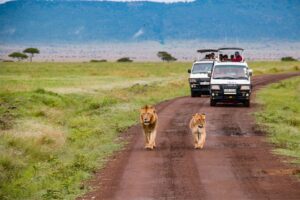
Do bring some extra safari clothing for colder weather. You may be surprised how much the temperatures can drop at night, so think layers.
Three comfortable outfits (shirts, pants, underwear) are often recommended for a safari, but check with your guide and ask for their recommendation based on the number of days of your safari, seasonal weather conditions and the type of safari you choose.
You may want to dress differently if you’re going to be trudging through the bush as opposed to sitting in a vehicle the whole time.
Wear neutral colors like khaki, brown and olive.
Bright colors, like red, draw attention to you and are not good for viewing wildlife. They may even scare off some of the animals you want to see.
White (and pale colors in general) can also draw attention and they will show all of the dirt you run into on your safari, so stay away from them as well. And some claim that blues and blacks attract certain nasty insects that like to bite, so you may also want to stay away from these colors.
Do not bring camouflage colored safari clothing. You may get mistaken for the military and that, my friend, could ruin your whole safari.
Here’s your list of essential African safari clothes.
Safari hat The safari hat is the key to protection from the sun. You’ll want it to be gas permeable to release the heat from your head and it should have a wide enough brim so that your neck and face are protected even when the sun gets low.
Look for a hat with an absorbent band on the inside to catch your sweat and make sure it’s waterproof to keep you a little drier should you run into an unexpected rainstorm.
Long safari trousers You’re going to need long safari pants for full protection against sunburn, mosquito bites at night and getting scraped up in the bush. You might also want to bring some safari short pants for those hot African afternoons. Just make sure you stay in the shade or put on plenty of sunscreen.
Here’s a great tip for you. Find long safari pants that are convertible to shorts. They’ll have zippers about half way down the leg that allow you to remove the bottoms. They’re the perfect solution for any safari weather conditions.
Long sleeved shirts The long sleeved safari shirts follow the same principles as the trousers. You need them for protection from the sun and from getting scraped up when out walking in the bush. Do take a short sleeved shirt, or two, if you like, or just take loose fitting long sleeved shirts that you can roll up past your elbows.
Safari jacket (or safari vest) Safari jackets are great for the evenings and at night when it can get pretty chilly, or for the cooler times of the year. An alternative for when it’s hot is the safari vest. The great thing about both of these garments is that they have plenty of pockets, which is great when you need to carry gear (like photography equipment).
A couple of points to wrap things up Think lightweight when packing: Safari clothing made from lightweight fabrics, lightweight safari walking shoes or boots (no heavy boots unless they are necessary for a walking tour) and don’t over pack. You don’t want to be hauling heavy luggage through the bush.
And leave your jewelry at home. It will just get in the way, and it doesn’t impress the wild animals anyway, so why bother.
Leave a Comment Cancel reply
Save my name, email, and website in this browser for the next time I comment.
Privacy Overview

Best Women’s Safari Clothing for Africa Overland Travel
Africa Packing Lists , Packing Lists , Travel Packing Lists
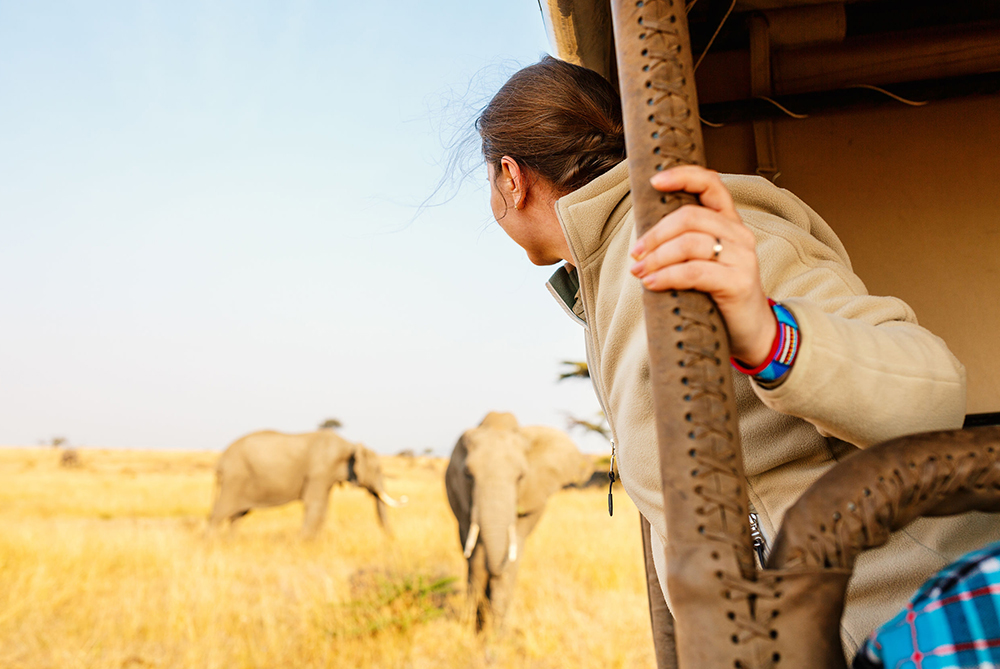
Support TFG by using the links in our articles to shop. We receive a small commission (at no extra cost to you) so we can continue to create helpful free content. We earn from qualifying purchases made to the featured retailers. Thank you, we appreciate your support!
Planning a safari or overland tour through one of Africa’s incredible game parks? This is the best womens safari clothing for your trip. Read our complete guide to find out exactly what to wear on safari!
Women Safari Clothing
Table of contents.
An African safari is one of the most exciting trips you can take as a traveler. Roughing it in the wilderness surrounded by the Big 5 is truly a thrilling experience. There are several things to keep in mind when you choose safari clothing for this type of adventure.
How should I dress for an African safari?
The focus of your safari attire should be on comfortable safari clothing in neutral colors and light fabrics. If it’s not something you would feel comfortable wearing something on an overnight flight, it’s best to keep it out of your safari gear.
Safari clothes for Africa should be relaxed, so you can enjoy the experience to the fullest. The drive time on overland trips can vary anywhere from 6 to 12 hours each day. Making comfort key on those long-haul journeys — the distances in Africa are massive!
Expect your safari clothing to be covered in dust and keep in mind that you won’t have much time to do laundry. Your safari clothes should feature synthetic fabrics that are hard wearing, quick-dry, easy to wash, and won’t show dirt or dust.
What to Wear on Safari
When it comes to options for what to wear on an African safari, womens travel brands tend to feature technical fabrics focusing primarily on khaki and olive colors. But unless you’re planning to live in the bush or are taking a Gorilla trekking trip to the jungle, it’s likely that this type of clothing isn’t necessary.
The majority of Africa safari tours will see you viewing animals within the confines of a vehicle, whether a giant overland truck or 4×4 car. This means that the khaki safari shirt or safari pants that you purchased will tragically go to waste.

Safari Clothing Essentials Packing Guide: An Overview
Before we get into the nitty-gritty of your clothing options, let’s take a look at an overall view of what your safari gear for your travel capsule wardrobe should consist of. Here’s a quick snapshot of the amount of what should be on your bag when you’re planning what to wear on an African safari.
TFG Recommended Clothing List
4 sleeveless or short-sleeve tops 2 long-sleeve tops 1 dress or skirt 4 pants 1 shorts 1 windbreaker jacket 1 fleece or warm jacket 1 swimsuit 3 bras (sports bras are recommended) 3 socks 7-10 underwear 1 jacket 1 scarf 1 sunglasses
TFG Recommended Shoe List
1 pair comfortable sneakers 1 pair flip-flops
What is the Best Women Safari Clothing?
Whether you’re looking for what to wear on safari in Kenya or are camping in the Serengeti, you need the best of the best when it comes to your safari clothing. Our selections offer you a nice range of safari pants, tops, dresses, and even safari jackets. That way you can be confident and comfortable on your jaunt in Africa!
Best of all? You can avoid the head-to-toe khaki safari outfits that somehow became the must-have on an African safari. Here are some realistic clothing pieces you’ll love carting along with you:
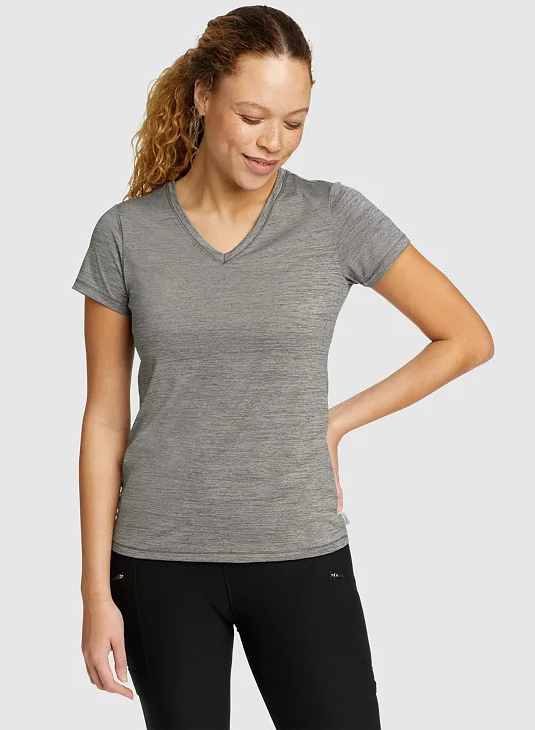
Shop Sizes XS-3X: Eddie Bauer Resolution T-Shirt
Best Safari Shirts for Women
As you plan what safari clothes to pack, make sure to bring a variety of tops and include sleeveless tanks, short sleeve tees, and long sleeves that you can layer!
The best safari shirts for the day time and warm weather are sleeveless or short sleeved breathable, moisture wicking tees in neutral colors.
For really hot days or to layer underneath warm items if cold, add a couple of casual tees. These also will be beneficial for those long safari travel days (read more on this in the Pants section below).
Stay cool with these moisture wicking shirts !

Shop Sizes XS-4X: Smartwool Merino Short Sleeve
Merino wool tops are some of the best safari shirts because they are both practical and can be re-worn without washing. This is particularly important on longer safari trips when you won’t have access to laundry for extended periods of time.
However, If you plan to hand wash your merino wool tops you’ll have to wait until you spend two or more nights in one location to allow time for the clothes to dry. This is why either quick-dry or long-lasting items are the best as safari clothes.
While merino wool is more expensive, you can get away with bringing just a few tops and then re-wearing them every few days. This is key for packing light!
Merino wool Icebreaker tops like these have a higher price point but are excellent for safari trips because they’re practical and you can rewear them (for weeks) without washing.
Learn more about how to hand wash while traveling !

Shop Sizes XS-XL: Icebreaker Merino Women’s Siren Tank
If you are traveling in hot weather, you might prefer a sleeveless top like the Icebreaker Merino Women’s Siren Tank one pictured above (perfect safari shirt). Like the short sleeve tops, the ideal fabrics are from performance brands with quick dry 100% cotton, merino wool, or synthetics.

Shop Sizes XS-XXL: Columbia Cades Cape Tank
If you’re looking for a sleeveless safari shirt that’s less body hugging, then one like the Columbia shown here is perfect.
A sleeveless top not only helps to keep you cool on your safari days, but it can also be dressed up when you’re visiting the city! Pair it with a cute skirt and you have an instant evening outfit. Double-duty top!
Plus, it also looks the part of an African safari shirt!

Shop Sizes XS-3X: Columbia Quick Dry Sun UV Protection Convertible Long Sleeve
For the sunny days you’ll want to bring one light but practical womens long sleeve safari shirt to protect you from the sun’s beating rays. This will be a piece you’ll want to re-wear, so we advise choosing a quick dry fabric so that when you wash it, it will dry relatively quickly!
The dark khaki convertible womens long sleeve safari shirt (pictured above) is not only quick dry, but it’s specifically designed for UV protection. Plus, with it being convertible you can make the sleeves longer and shorter based on your preference.
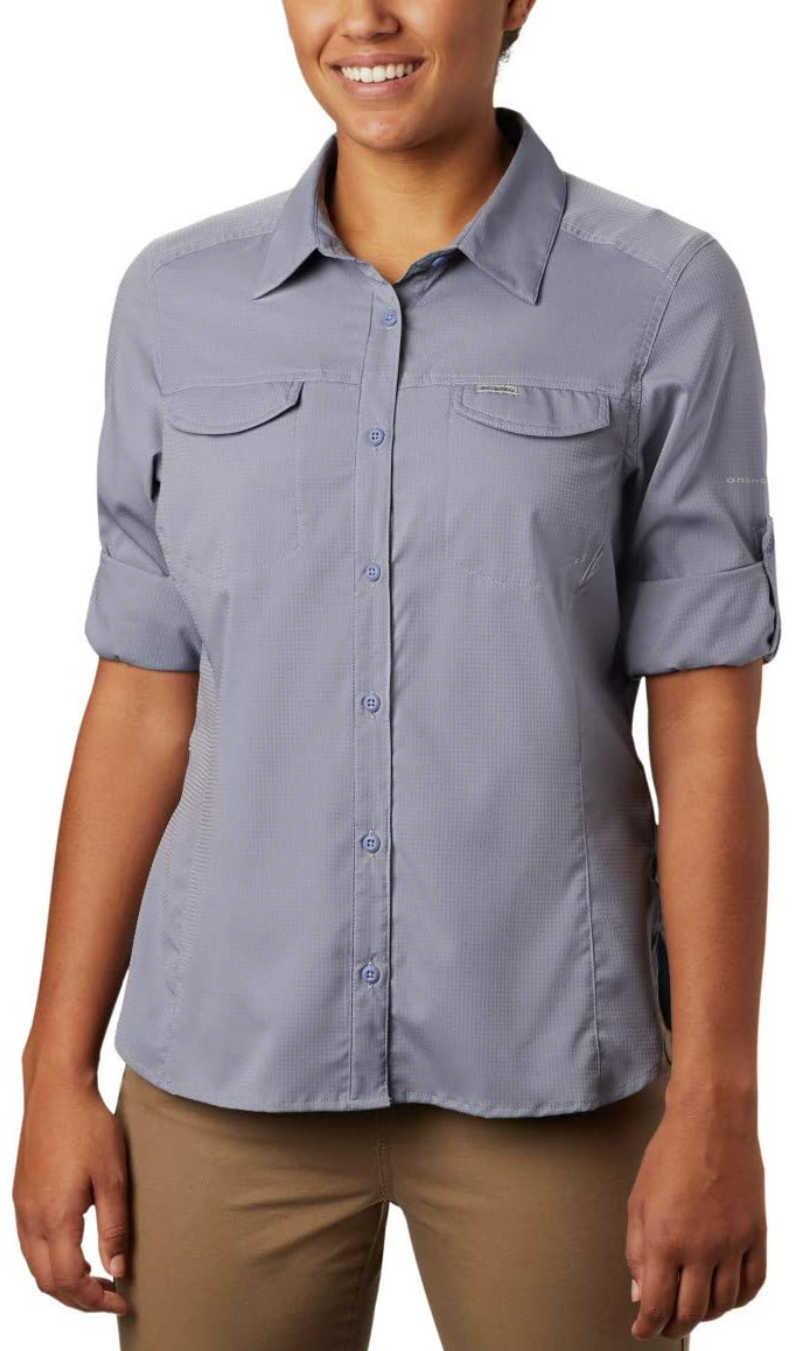
Shop Columbia Silver Ridge Lite Long Sleeve : Amazon | Columbia (Sizes XS-3X)
Can you wear grey on safari? Grey is a great color choice for safari clothes along with other medium to dark neutral colors like khaki. These colors are good choices due to the fact that your clothes are likely to collect a lot of dust, especially the ones you use for the outer layers, and the darker neutral colors are able of masking it.

Shop Sizes XS-XL: Unbound Merino Long Sleeve
When you’re planning what to wear on a safari, make sure to bring at least one warm long sleeve or thermal top . You should also include a long-sleeve blouse you can use to cover you from the winter sun and to wear in the cities.
Depending on the time of year you’re headed on your safari and the region in Africa that you’re going to, you might need to add a few extra long sleeve tops to your safari wardrobe to layer at night. It can get pretty cold!
Safari Packing Tip : You’ll want to keep your safari attire as light as possible. To keep your packing light, make sure to include six to eight safari shirts. Any more and you’ll be overpacking!
Best Safari Pants for Women
When you are actually on a safari, you are much more likely to be going inside of a vehicle — walking safaris aren’t the norm. Being inside a vehicle allows for the undisturbed observation of the wildlife in a natural setting. Perfect for safari adventurers!
Of course, it’s best not to assume. So if you aren’t sure that you’ll be in a vehicle, double-check with your tour operator (if you have one).

Shop Sizes XXS-XXL: Zella Live In High Waist Leggings
It might surprise (and excite you) to find out that some of the best pants for safari are leggings. Seriously! This is specifically the case when you are taking a driving safari tour, NOT if you are getting out of the vehicle and walking in the bush.
Leggings are the perfect safari pants choice for comfort. Avoid choosing thick fabrics that will take too long to dry if you are hand washing them.
Leggings are also great for travel days. If you’re looking for leggings to take on your safari, TFG readers voted for the best leggings for women , so you’re bound to find a pair you like! We also really love these leggings from Zella (which are also available in plus size ).
Leggings are the most comfortable, packabe safari pants. So they’re definitely a good choice to wear on safari. While you can easily wear a pair of black leggings when you’re inside the vehicle, you might want to consider a lighter color to wear outdoors by the campfire (you’ll thank us later).
Safari Packing Tip : Make sure to choose a legging color that you can easily re-wear in-between washes!

Shop Sizes XS-XL: Scuba Mid-Rise Pant
If leggings aren’t your thing, a good alternative is casual joggers. Lululemon — a much-loved brand by yogis and travelers alike — makes a great pair of chic joggers which are great safari pants. They also make some pretty nice leggings too!
The travel-friendly fabric in these safari pants makes them easy to clean and de-wrinkle. Plus, with four-way stretch and a drawstring waist, you can wear them comfortably on the longest of overland safari rides!

Shop Sizes 2-24: Amazon | Columbia | Zappos
When you first think about what to wear on African safari, you might imagine an outfit consisting of a khaki button down shirt and convertible trousers. But generally speaking, convertible pants are not a necessary item to add to your safari attire (unless they make you comfortable and confident, that is).
We recommend a modern-yet-functional pair of travel pants like Saturday Trail Pants by Columbia . Not only are these safari pants versatile, but more importantly they’re comfortable! They also pack light, dry quickly and don’t stain easily — what more are you looking for in your safari pants?
As an added bonus, they have a stretchy pull-up waist band that’s sitting down for long periods of time. It’s also easy to remove for quick bathrooms stops on an overland trip.
Here are 16 best hiking pants for women that are lightweight and practical!

Shop prAna Halle Pant: Amazon | prAna
If you’re looking for both more traditional and budget-friendly safari pants, these prAna travel pants are for you! Both safari pants are ideal for walking safari tours or trips that will incorporate both extensive time outdoors and inside a vehicle.
If you are going to be trekking through the bushes, we highly recommend making technical womens safari clothing part of your wardrobe.
When you’re planning on what to wear on safari, make sure you always pack a pair of safari shorts! Safari shorts are casual and easy-to-wear on hot days.
You might also want to consider including a breezy long skirt or sarong. Both make it easier to “pop a squat” on the side of the road without baring it all to your tour mates!
Travel Tip : There aren’t usually bathrooms along the long roads, and stops are typically infrequent.
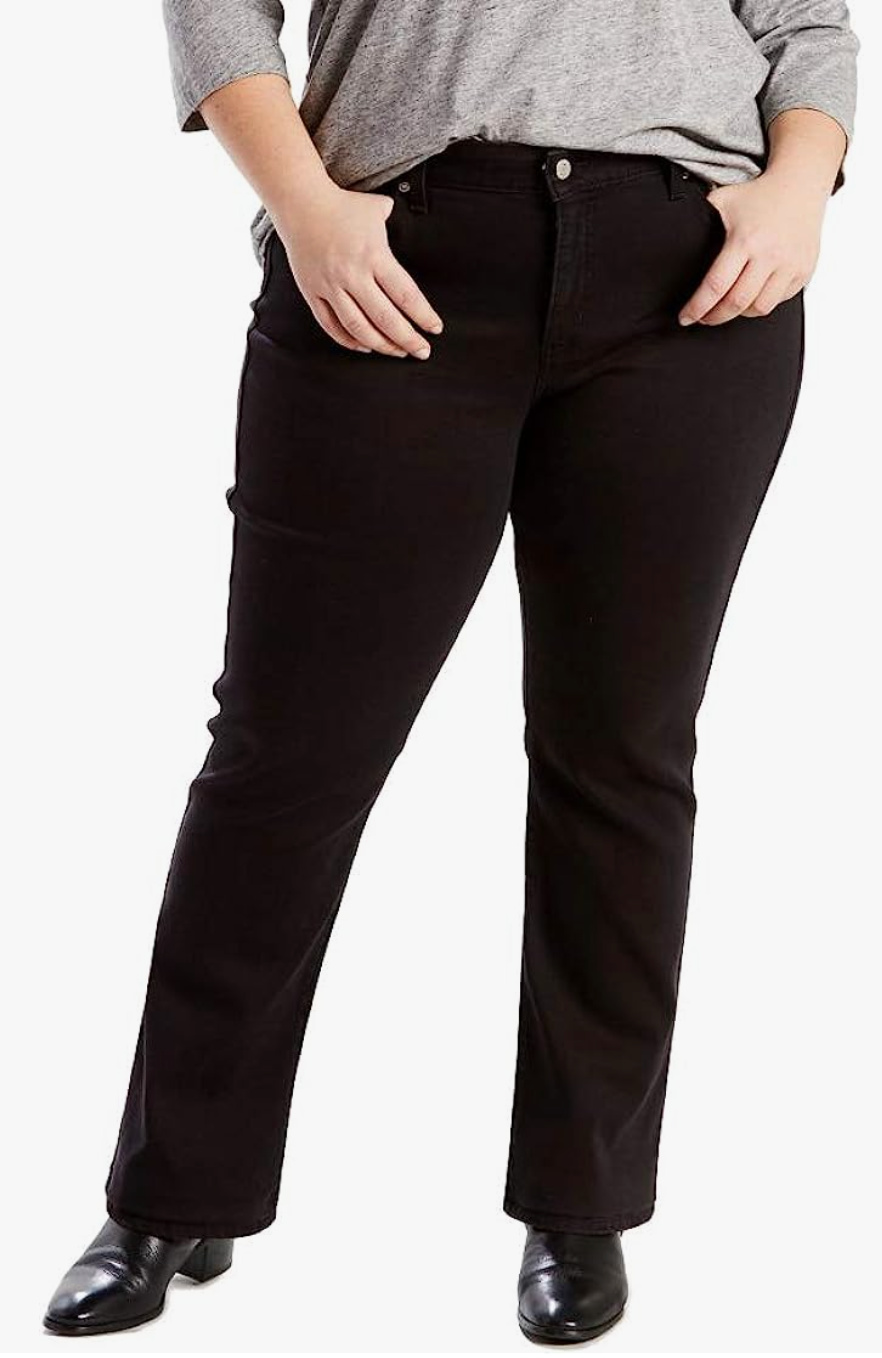
Shop Sizes 26-40: Levi’s Classic Straight Jeans
Can you wear jeans on safari? Jeans are a must, especially if you’re traveling in the winter! Sometimes the best women’s safari clothing isn’t necessarily the most technical travel gear. Jeans are not only practical, but they’ll provide you with warmth disguise dirt, and also give you a bit of style if you make a top in a major city like Cape Town!
But make sure not to hand wash your jeans! They’ll take way too long to dry. Denim is practical because you can re-wear it constantly without washing it. Denim designers make them specifically for multiple uses, and it’s one of the main reasons that modern travelers pack jeans. Jeans are a must-have when it comes to what to wear on safari !
You’ll also want to have a comfortable pair of pants that you can wear around the campsite at night.
Safari Packing Tip : Make sure you’re packing light. You should need no more than 5 pairs of safari pants.
Best Safari Dresses

Shop Columbia Freezer III Dress: Amazon | Columbia (Sizes XS-3X)
A dress may sound like the exact opposite of safari clothing. But, it’s always good to have at least one dress that you can sport on the beach in Zanzibar or wear out to a nice dinner at Victoria Falls.
The best safari dress is a little black dress that you can dress up for restaurants or a fun night out in the city. This one by Columbia features wicking, cooling, and sun protection fabric. Plus it’s available in sizes up to 3XL.
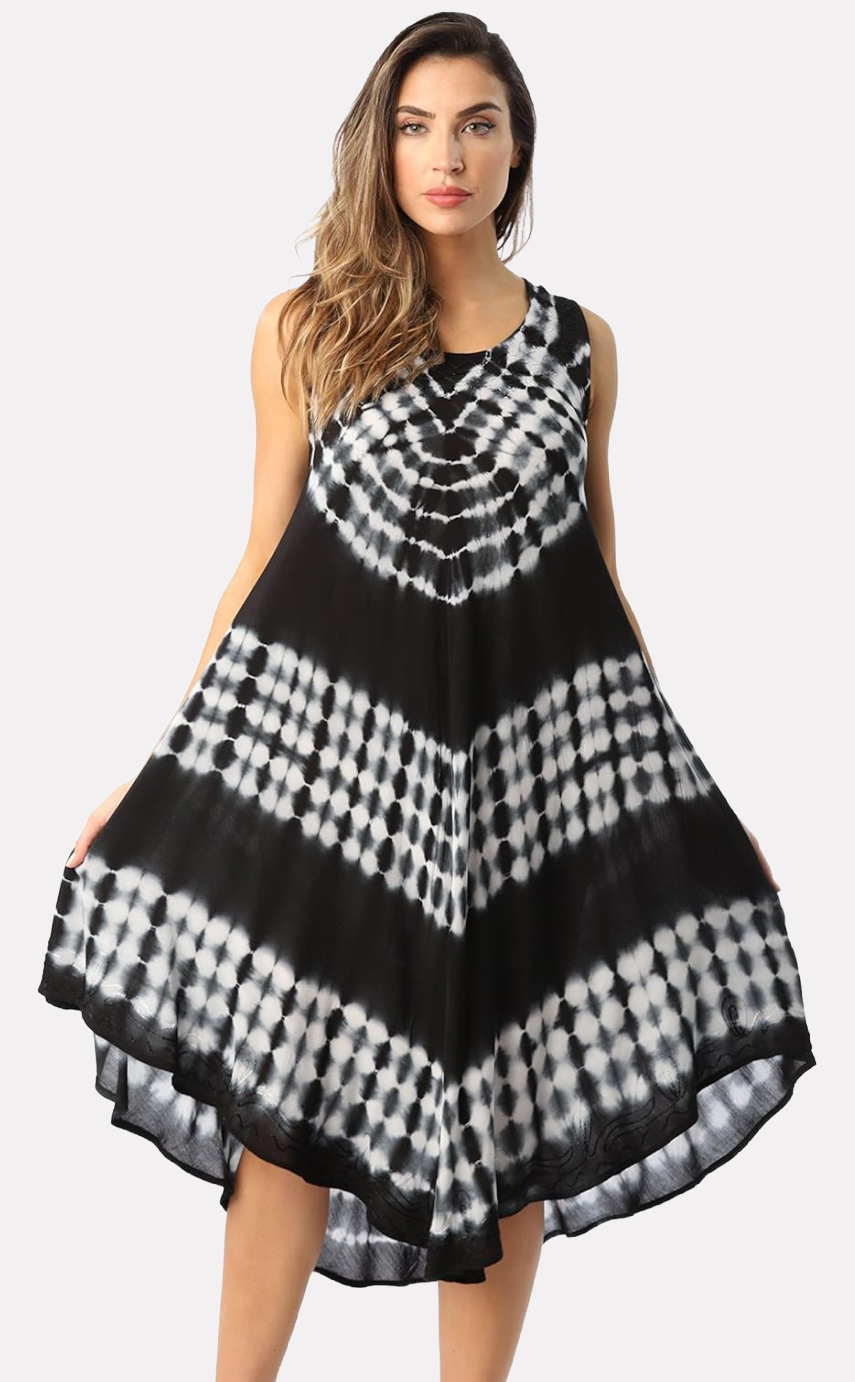
Shop Sizes S-3X: Riviera Sun Tie Dye Summer Dress
When it’s hot, a loose and lightweight safari dress is also ideal for those long overland trips. In fact, dresses are more practical than pants — especially when you need to stop on the side of the road for a quick bathroom break in the bush along with your fellow tour mates!
When it comes to picking the best safari dress, choose something both versatile and comfortable. When it comes to choosing what to wear on safari, you’ll want a dress that can be worn on the beach and doubled for dinner and night on the town!

Shop Sizes XS-3X: WEACZZYLoose Trapeze Dress
If you aren’t a person that’s comfortable in dresses, you simply don’t like them or you’re going to be traveling when it’s colder, a long tunic top that covers your backside cans also do the trick for those safari roadside bathroom stops.
Long tunic tops can be versatile just like a safari dress — you can wear it in the camp after a shower, on the beach over your bathing suit, loosely over a comfy pair of safari pants or tick it into your shorts for a cute but casual safari outfit!
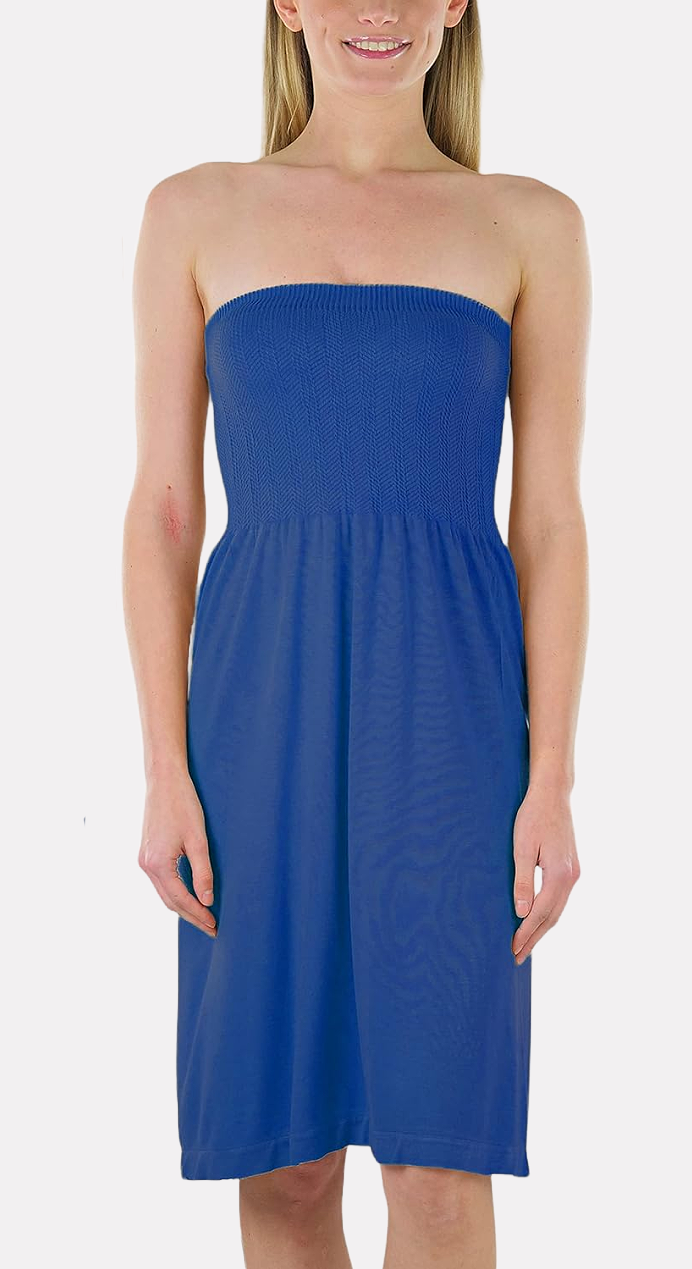
Shop One Size: ToBeInStyle Strapless Dress
REALLY IMPORTANT TRAVEL TIP : WHEN PLANNING WHAT TO WEAR ON SAFARI, AVOID ROMPERS. ESPECIALLY ON AN OVERLAND TRIP FOR TRAVEL DAYS . YOU DON’T WANT TO HAVE TO PULL OFF YOUR ENTIRE ROMPER TO USE THE BATHROOM ON THE SIDE OF THE ROAD. NOT COOL .
If you’re something that has the same comfy and lightweight feel as a romper, opt for a strapless sundress like the ToBeInSty Strapless (seen above). You can wear it as a safari dress during the day for those long safari travel days or layer it over your leggings if it gets cold outside.
A strapless dress can also be worn as a safari skirt. Simply pair it with a cute top and dress it up with some jewelry that you find at a local shop during your travels!
Remember to avoid choosing bright colors on a safari so you don’t draw attention away from the safari (or frighten away any animals!). But if you pack bright colors in your safari wardrobe, you can wear them on travel days when you’re not on a game drive.
If you’re looking for maximum versatility, one of these convertible travel dresses might be perfect for your safari attire!
Best Safari Clothing for Cold Weather

Shop Sizes XS-XL: Terramar Silk Undershirts | Terramar Silk Thermal Pants
Contrary to what you might think, it does get cold in Africa. That means that layering your safari clothes is key to surviving those cold African days. We’ve previously written about how to layer for cold weather , we’d highly recommend you take a peek before you start packing!
Regional climates in Africa vary throughout the season, so be prepared to encounter both hot and cold temperature. Make sure you always check the weather forecast before you go so you’re dressed right!
If you happen to be traveling during the cold season, from May to August, you might want to consider packing a set of thermals for women with your safari clothes so you can stay warm. You can wear them up to two weeks (or longer) without having to wash them!
Safari Packing Tip : For maximum warmth, pack one set of merino wool thermals. Especially if you’re camping in the winter!
Best Women’s Jacket for Safari
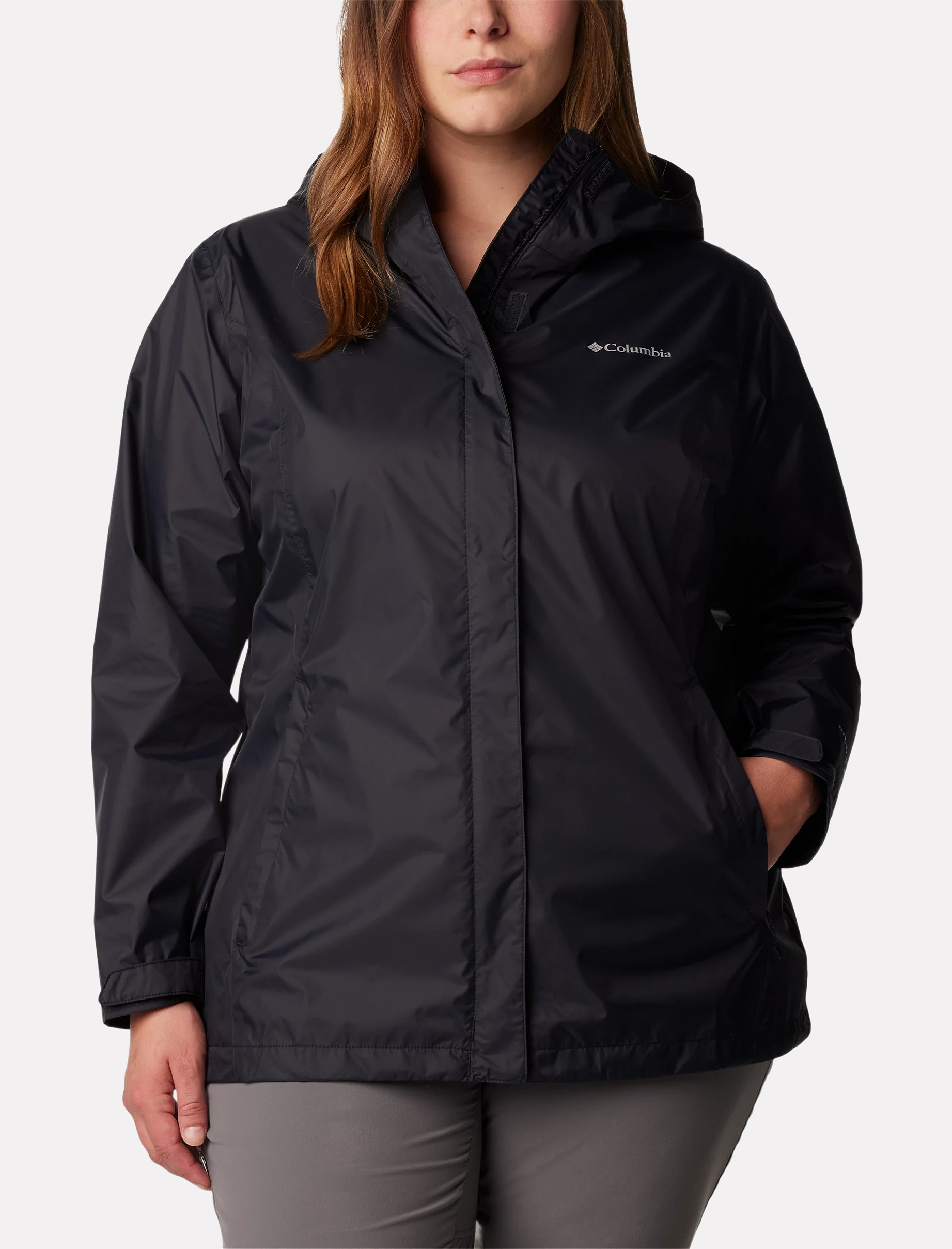
Shop Sizes XS-3X: Columbia Womens Arcadia II Rain Jacket
As you’re preparing your safari clothing checklist, make sure you pack a good jacket for safari. The roof and windows of some safari vehicles are open as you drive around the parks. With those open windows it can get quite chilly both at dawn and during night drives.
When you’re looking for the best jackets for safari, you should look for a good, quality jacket that can also serve as a windbreaker. You’re sure to feel a chill in the air with an open window first thing in the morning!

Shop Columbia Full Zip Fleece Jacket: Amazon | Columbia (Sizes XS-3X)
A travel fleece or rain jacket for safari are most needed when you’re doing an African overland trip that crosses various countries. When deciding what to wear on safari, make sure you don’t underestimate how cold it could get in Africa on your trip!
While it might be hot and sunny during the day, when the temperature drops at night you’ll be glad you packed a rain jacket and fleece in your safari clothes. TFG has a list of the best windproof jackets and fleece jackets for your travels.
When you’re packing your safari wardrobe, make sure you pack both a windproof jacket and a merino wool or fleece jacket for safari clothes.
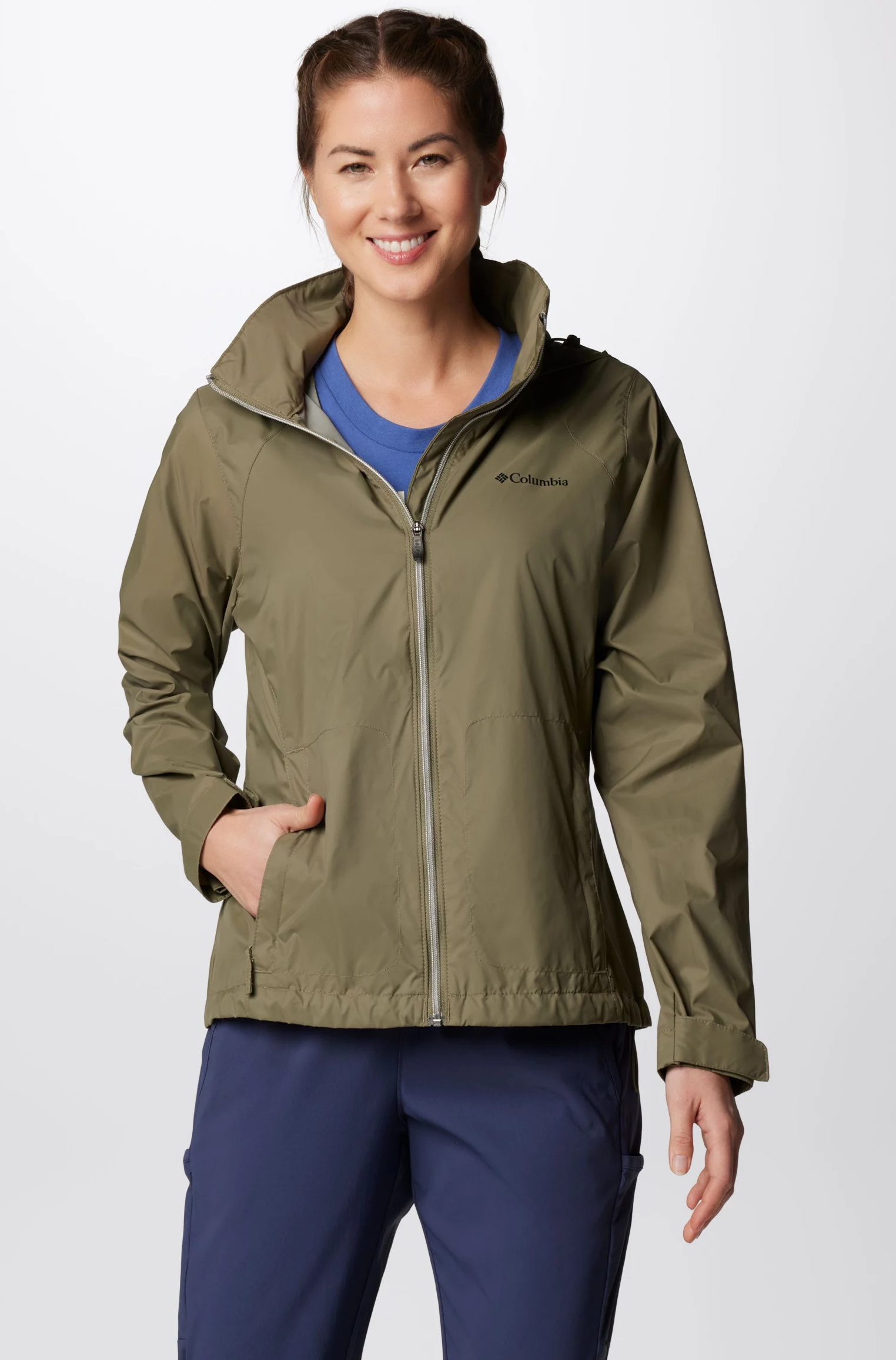
Shop Columbia Switchback Jacket: Amazon | Columbia (Sizes XS-3X)
Remember to choose neutral tones for your safari clothing. This is especially the case for items that are highly visible such as your jacket for safari.
Trust me on this one. If you’re head is hanging out of a vehicle at 5:30am, you’ll feel the crisp morning air and wish you had a warm jacket — it happened to me!

Shop Sizes XS-XXL: Style & Co Safari Jacket
For a stylish jacket for safari option that you can wear as part of your safari outfit, the Style & Co Safari Jacket is both chic and practical. When it comes to choosing a jacket for safari that’s neutral, easy-to-clean and will hide the dust, go for the grey, khaki, or olive green color!
Best Safari Shoes

Shop Merrell Moab 3 Shoe: Amazon | Zappos
Now that you’re packed and ready with your safari clothing, it’s time to plan your safari shoes! This is probably going to be much easier than you think!
We recommend taking only two pairs of shoes. When it comes to picking those safari shoes, go with a pair of sneakers and flip flops (for camps, shower, and beaches). Your sneakers should be something comfortable you can wear on the truck, for occasional safari walks, and at the campsite at night if it’s cold.
However, if your safari itinerary includes walking safaris, you’ll need substantial sturdy safari shoes. For multi-day treks through the jungle, you’ll want to bring sturdy hiking boots . But for the occasional day trip, regular all-terrain sneakers or hiking shoes will work as safari shoes.
Ideally, you’ll want your safari shoes to be waterproof and easy to clean in case they get muddy or otherwise dirty.

FitFlop Iqushion Super-Ergonomic Flip-Flops
Flip-flops may seem like a random item to add to this safari packing list. But it’s nice to air out your toes if you’ve had them in sneakers all day. Flip-flops are also great safari shoes as they’re convenient to wear in camp showers. And don’t forget about the beach!
Not a big fan of flip-flops? Try one of these slip-on beach sandals as your second pair of safari shoes instead. Throw in a pair of cute ankle boots or stylish slip ons if you’re traveling in Cape Town .
But make sure not to add too many shoes to your safari wardrobe!
Best Safari Socks
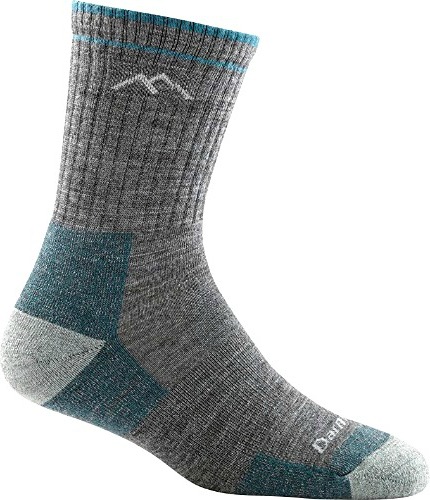
Darn Tough Crew Socks
Whether you need to pair your socks with safari boots or sneakers, make sure they are moisture wicking socks ! This is particularly important so you can keep your sock numbers down.
I know we’ve mentioned merino wool a lot, but just as with the rest of our suggested safari clothing, merino wool socks are perfect to pair with your safari shoes because you can rewear them multiple times without having to wash them.

Kirkland Signature Trail Sock
Several TFG readers agreed that Kirkland’s merino wool socks are a great pick to add to your safari wardrobe. One reader says, “I wash them in cold water and hang them to air dry, but they have held up really well and keep my feet warm, too.”
If you’re camping, you can bring a pair of Kirkland socks (like the ones shown above) to keep your feet warm at night. If you choose dark colors or prints they won’t show the dust as easily.
Best Bras and Underwear for Safari

Panache Underwire Sports Bra
Last but not least for your safari travel checklist, make sure to pack a good sports bra for the bumpy journey! Vehicles in Kenya, and other countries, often cover all terrains including deeply rutted roads and huge potholes.
Make your ride more tolerable by wearing a sports bra whenever you are being transported. Also, take some motion sickness meds beforehand if you are prone to car sickness.

Shop Sizes XS-XL: Icebreaker Siren Merino Wool Bikini
Also, quick dry travel underwear helps you easily do laundry without having to wait ages for it to dry!
Because you may be moving locations every night, you won’t have much time to wash your safari clothing, so it’s best if you bring fast drying fabrics or clothing you can re-wear easily.
Safari Travel Tip: Most of the time, you’ll be popping a squat on the side of the road, so a female urinary device or even a flowy skirt might be helpful if you’re not crazy about the idea of flashing your goods. Don’t forget your antibacterial hand wipes!
Other Safari Gear

UPF 50+ Sun Protection Quick Dry Baseball Cap
TFG has a great post on what to pack for African safari tours that we’d highly encourage you to check out so you know what other safari gear you’re going to need on your trip!
To go along with your safari clothing choices, you’ll need a few accessories.
Hats are great because they can help shield you from the sun and hide unwashed hair. But while hats are a definite must, but that doesn’t mean they have to be unattractive.
When it comes to your hair, you will want to keep it covered and pulled back in a ponytail or bun so it doesn’t get tangled in the wind and full of dirt from the road. We have a few suggestions for some hair accessories that will help keep high maintenance hair on the down low during your safari tour.

Compass Rose Secret Bra Wallet
Sunglasses are also a must-have, they offer shade and protection from the sun which is really important considering how close to the equator you’re going to be! A few other safari necessary accessories include a bathing suit and scarf.
Don’t be a target for unwanted attention. When you choose what to wear on safari, make sure you don’t dress too flashy or showy. Make sure you don’t bring any of your expensive jewelry and leave your designer handbags at home (or another safe place).
Finally, conceal the majority of your money and extra credit cards for extra safety. This bra wallet is a great way to do that!
We’ve got some great anti-theft tips for you so you can protect your valuables during your safari travels.
Essential Packing List for Safari

Shop Osprey Fairview 55L: Amazon | Osprey
Which luggage should I choose for safari?
When it comes to choosing luggage for safari, check out the Osprey Fairview 55L . It’s kind of perfection.
I found it easier to lug a soft bag than a suitcase, as everyone’s gear gets piled up under the truck. I personally use it with the Compass Rose packing cubes to stay organized and fit in everything!
Don’t worry so much about the baggage weight. My bag never goes over 30 lbs using the guidelines suggested on the site. If you aim to pack light, you shouldn’t be overpacking!

Left: Compass Rose Medium Packing Cubes (13″ x 8.5″ x 2.8″) | Right: Compass Rose Slim Packing Cubes (13″ x 5″ x 2.8″)
Should I use packing cubes on safari?
Yes! You should definitely use packing cubes on safari. Packing cubes will help keep you organized, keep your bag light, and help you avoid over packing.
Many readers use our packing cubes for this task. The Compass Rose Packing Cubes are now offered in two sizes: slim and medium. The slim size cubes measure 13 x 5 x 2.8, and the medium size cubes measure 2.8 x 13 x 8.5. Both fit an international carry-on suticase and can help you organize and compress clothing items. The medium sizes is great for bulkier items.
Watch this video to learn how to pack light thanks to packing cubes!

pStyle Urinary Device
What should I pack for toiletries on safari?
When it comes to what you need to pack for toiletries on safari, there are a few things you’re definitely going to need.
You definitely will want to have a female urinary device , because the only bathroom breaks you get are in the bush. Finding adequate coverage can be a challenge, so you might also need to get comfortable with flashing your bum at other women on the trip!
You’ll want to bring a travel towel so that it can dry quickly when you’re constantly on the go. You should also pack any prescriptions you might need along with mosquito repellent … don’t forget that! And while it’s not exactly a toiletry, you’ll want a collapsible water bottle , too!
If you’re going to go the carry-on only route, make sure you cut back on your toiletries. It’ll help with TSA if you put all of your liquids in a Ziploc bag, following the 3-1-1 rule !
Learn all about packing toiletries with this guide !

Travelon Anti-Theft Cross-Body Bag
What should I take for a purse on safari?
You’ll want to choose a bag that can fit into your carry-on when it comes to the perfect purse for safari. TFG recommends taking a crossbody travel purse with anti-theft features like the Travelon Anti-Theft Cross-Body Bag bag or other similar purse.
See our picks for the best anti-theft purses for travel .

Lewis N. Clark Deluxe Neck Stash
What anti-theft accessories do I need on safari?
We recommend you make sure your purse is built for security. Other great anti-theft accessories for safari might include a secret bra wallet , neck wallet , or even a money belt.
Read about popular anti-theft accessories !

International Travel Adapter

What electronics do I need on safari?
A headlamp will be a lifesaver when it comes to camping at night during your safari.
A few other things that might come in handy include a travel adapter , portable battery charger , and your headphones . Plus, if you’re planning on taking any pictures, you’re going to need your camera and gear!
Printable Travel Checklist

Don’t forget to download the TFG Printable Travel Checklist
The Dos and Don’ts of Safari Clothing Packing
Packing for your African safari can seem overwhelming, so let’s finish off by going over our main dos and don’ts when it comes to getting together your safari gear and planning your safari attire!
What should you not wear on safari?
What you shouldn’t wear for an African safari depends highly on the actual trip type that you’re participating in. An overland trip that touches on a variety of countries is going to mean different must-haves from a short safari to Kruger Park that’s smack in the middle of a longer trip.
If your African safari trip is long, you’re going to want to focus on making comfortable, practical safari clothing a priority. But if you’re headed on a short three-day trip, you can definitely get by with wearing regular clothes.
But for both trips, we highly recommend that you DO NOT wear a romper on a safari — three days, seven days or otherwise. We know that we’ve mentioned this before, but it’s such an important note that we want to talk about it in a little more detail!
When you’re on an overland safari trip, it’s common place to simply pull over on the side of the road to go to the bathroom — in public — as there really aren’t bathrooms along the way. The reason why we stress that you shouldn’t wear rompers is due to the fact that going to bathroom in a romper means taking all of your clothes off to go to the bathroom.
While you might be able to find a somewhat “discreet” spot in the pushes to pop a squat, you’ll still be pulling off your entire romper in public and it’s much harder to attempt to conceal the top and bottom half of your body at the same time. It’s much easier to focus on covering your backside.
We know you’ll thank us for this advice later!

What colors should you wear on safari?
As exciting as it is to experience nature in its rawest form, you don’t have to immerse yourself to the extent that your safari clothing completely blends in with the foliage and desert itself. We can leave that for the Hollywood movies!
With that in mind, the best colors for safari clothes include:
- Olive green
A tip for picking the best color for your safari clothing is to go with colors that are inspired by nature. Measure your clothes with the image above, if they’re in the same tone, intensity and relatively the same color they’re good to go. You’re looking to blend in, but you don’t have to look like Crocodile Dundee or wear full tactical gear!
What color should you not wear on safari?
If you’ve done your safari clothing due diligence, chances are you’ve come across something that tells you not to wear bright colors. It seems like a strange request, but it’s recommended that you choose neutral colors because you don’t want the animals to see you — if they do they might be scared off!
Stick to neutral colors but avoid white because your safari clothes are bound to get very dirty, especially if you’re camping, and white will show it all!
Can you wear black on safari?
Wearing black on safari is not recommended. Black clothing attracts mosquitoes, and you’ll want to avoid that as much as possible to keep your trip its most enjoyable!
If you do end up bringing some black pieces, keep them to a minimum and opt for lightweight fabrics wherever possible!

What are your tips on choosing the best womens safari clothing? Share and comment below!
For more Africa packing lists, please read:
- What to Pack for Safari: South Africa to Zimbabwe
- What to Pack for Africa: Safari and Beaches
- Africa Travel Packing Tips
- 10 Essential You Absolutely Need for Safari
Suggested Travel Resource:
- Lonely Planet Tanzania
- Lonely Planet South Africa
- Lonely Planet Africa on a Budget
LIKED THIS POST? PIN THIS PIC TO SAVE IT!
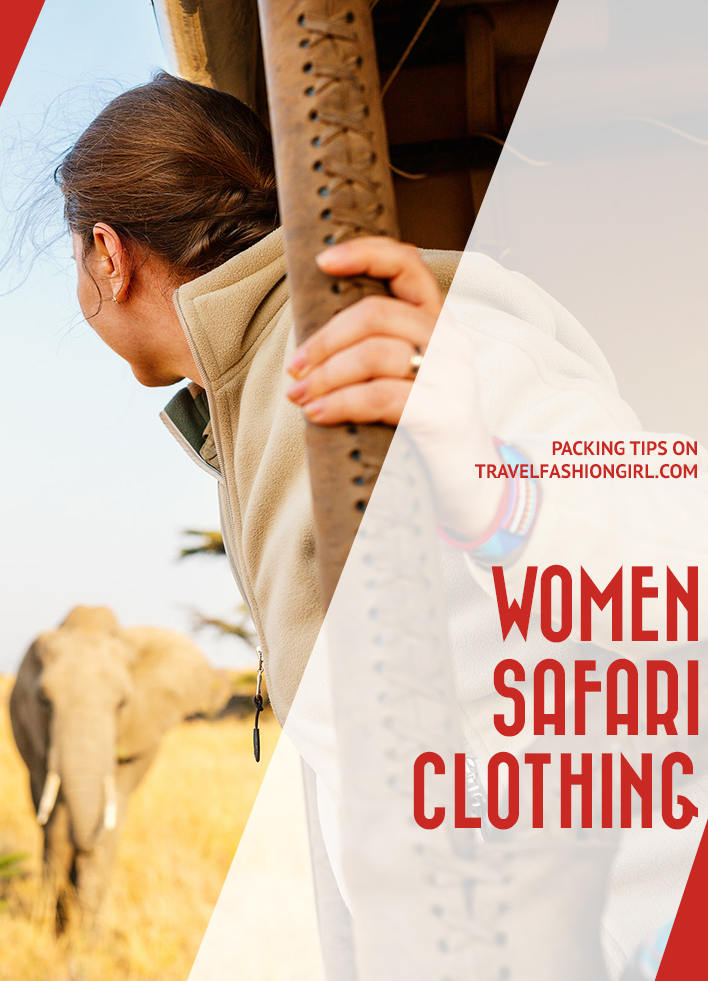
Hope you liked these safari clothing women’s tips. Don’t forget to share this post on Facebook, Pinterest, or Twitter. Thanks for reading!
63 comments.
I’m going on a safari next week, and the packing list looks like it would be a lifesaver, but I’m getting an error that the page is unavailable when I click on it. Anything I’m missing? Thanks!!
Hi Amy, I am so sorry about this. Please can you email us at [email protected] so we can send it over to you.
Have a wonderful time on your Safari!
On August 2, 2022, Just got back from South Africa; Cape Town, Cape Winelands, then off to safari at Kruger; Victoria Falls, Zimbabwe; Botswana, Okavango Delta! It was a great 12-women trip, Women, Wine and Wild. I researched and looked at this site for everything from suitcases, carry-ons, cross-body bags, packing, lists of clothes, shoes, jackets, underpinnings, toiletries, hats, scarves, etc.; for varying types of travel, city, winelands, safaris, and Travel Fashion Girl came through on all fronts – I was ordering things left and right even in the last few days and got it all together and had the most wonderful trip. I may have taken a little too much, but I really used most everything I brought so it all worked out. But as they say, less is more; I wouldn’t bother even with a little heel for dinners out if it’s only a few night in a city. I wouldn’t take as many pants as those can be interchangeable pretty easily, especially if you bring a few blouses/tops. For chilly mornings or evenings, a lightweight puffer jacket was perfect. And scarves are perfect to help mix it all up and really be able to wear the same things with different scarves. TFG is an amazing place to go for everything travel; I love it!
Just got back from our 3 week honeymoon on safari in Kenya and Tanzania including a week in Zanzibar – these packing lists from TFG were so helpful for knowing what to expect and helping to minimize how much luggage to bring. Definitely recommend carry on backpack for this trip to fit in the small trunks of the land cruisers and for small airplanes (we took one with only 12 seats!)
This recommended packing list was just what I needed for a 10-day safari in Tanzania.Thank you 🙏
Someone recommended we take soft travel bags to fit onto the small airplanes which I would NOT do again. Due to their weight, it made the grueling trek through airports a painful experience 😣 Instead, we would have preferred rolling, carry-on luggage. My two-cents, but unless you travel lightly, soft bags aren’t the way to go for this type of trip. Anyone else?
Thank you for sharing your own feedback with us Tracy, this is really helpful to know. Hope you had an incredible time!
It was an incredible time, thanks Alex! Would love to go again 😀
Loved this packing list! I only went on a two day safari but this was immensely helpful with helping me choose the right clothes to pack for a conference plus my safari outing.
We’re just back from a Safari in Zimbabwe , Botswana and Zambia And I found previous posts on Safari clothing on this site invaluable! And def no all in ones ! We stopped for loo breaks whenever needed and took it in turns to go round to the back of the truck so it was totally private and discreet! I took very thin summer dresses for the middle of the days and was really glad of these . And we definitely needed warm things for early morning … I had a cashmere snood I was so thankful for … I could pull it up over the back of my head . Also silk gloves ! And it was the best holiday we have ever had !
Thank you so much Julia, so glad we were able to help you with your packing. And thank you for sharing your packing insights with us, these are all super helpful.
So pleased to hear you had such an amazing time!
Just came back from a trip that included: Capetown; The Winelands; Vic Falls; Chobie game drive in Botswana; self drive through Kruger; and a luxury resort/safari game drive; — oh yeah and we had a two day stop over in Doha (!) So we had temps that ranged from 50-65 degrees in Capetown/Winelands; 55-85 in Kruger, and 98-112 degrees in Doha (!)
So one big thing to consider is that the weather is vastly different depending where you go: Capetown in July is Winter, which is chilly and drizzly, can be windy and stormy, BUT because it’s their winter, it was the best time to go on Safari on the other side of South Africa, which was Great Kruger National Park, so just remember, your season might not be their season. Best safari pants I brought was North Face Hybrid Yoga/cargo pants in olive — stretchy, quick dry, had tons of pockets, but felt like leggings. Also the lululemon “Smooth Departure” packable rain coat. Ultra light, and looks good while on safari or in the city. Lastly, even if you go during a “light bug” season, I would recommend at least one Insect Shield SPF long sleeve top (that can be also rolled up) and at least two pairs of their socks. Long sleeve shirts that have SPF can keep you cooler than a t-shirt because the African sun is HOT!! And even if you come from a sunny state (Like CA, as I do) your arms can get really get burnt. Also, a first layer underlayer (for cold) can do double duty. I wore it over my bathing suit while I was going into Devil’s Pool (Victoria Falls), and it really saved me because the water was COLD!! Because it was dry-wicking, it dried almost immediately. Also, just a note: our safari guides would NOT have recommended wearing that bright turquoise jacket that’s pictured in the photo (especially on a walking safari) — maybe it was more “neutral” looking in real life?
Hi Victoria, thank you for sharing your trip report with us and all your great travel tips! This is really helpful. Hope you had an incredible time on your trip! ?
Thank you for the advice! I am looking to travel to Togo, Africa at the end of January 2020 for roughly 2 months. I think the best take away for me I hadn’t really considered is laundry and drying time! I tend to get hot, sweat a lot and very easily. I will let you know how it goes!
Hi Mari, so pleased you found this atricle helpful. Looking forward to reading how you get on. Have the most incredible time! ?
Hello, we are going to Ezulwini Lodges in the middle of March. I have struggled over what to wear and what essentials I should take. I have loved reading all of your comments over the years and am finally taking a 7 night trip there. We are also going to spend 2 night in Maritime Bushveld Estates. Any thoughts on attire?
Hi Jody, thank you for your lovely comment, so pleased you enjoy reading our blog!! 🙂 For other tips to help with your packing for your safari, have a read of this article: https://www.travelfashiongirl.com/what-to-pack-for-african-safari-tours/ You may also find this article interesting, its about how one TFG reader packed carryon for her African safari and how she also was able to keep the weight to below 10lb: https://www.travelfashiongirl.com/safari-packing-list/ Also our readers have the best advice and tips, so I have gone ahead and posted your question on TFG’s facebook page. Keep your eyes out for our readers replies from Wednesday: https://www.facebook.com/TravelFashionGirl/ Hope this helps. Have an incredible trip!!
Hi Jody, here is the FB thread with our readers replies to your question: https://www.facebook.com/TravelFashionGirl/posts/2240284559328533 Hope this helps! 🙂
Thanks so much for sharing this Alex! It’s really helpful . Well, I’m going to Tazania in mid of December. Plan a week in there, there are 2 days will be soft hinking with group. Any tip of packing for specific December weather. Please advise! Thanks in advance,Tracy
What shades of blue need to be avoided? Just dark blue or also aquamarine/baby blue and royal blue? How about lavender? Thx!
thank you for this very inclusive list. I appreciate all the work and effort to provide this resource.
YES it gets COLD, even in summer! Keep in mind that some local flights out into the bush have a weight limit on luggage so double check on this- they’re strict! Also, some safari’s do laundry daily so that helps cut down on what you need. I survived a 2 week trip with 2 pairs of leggings, 1 hiking pant from Athleta (cute!), 1 pr of shorts, 5 shirts, (mix of button ups, tanks and athletic type t’s) a fleece and a windbreaker. Don’t overdo the shoes either! One pair of sneaker types and one pair of sandals is fine!
Great tips Megan, thanks!
Great article! Having lived in Africa for the past nine years, I might also advise against wearing shorts. Most of Africa is significantly more conservative than many Western countries, and the only people I ever see in shorts are the tourists and, at times, wearing anything cut above the knee can attract unwanted attention from males- an unfortunate but true reality
Hi Emily, thank you so much for your comment! Thank you for sharing your travel advice 🙂
Hi Alex, Emily’s comment about shorts also might include strappy tank tops and leggings. Your comment about wearing sports bras was right on. Safari trucks have lousy shocks and you will be bounced around. A scarf is useful for keeping dust out of you eyes and mouth.
This really helped me on my recent trip to Kenya and Tanzania. Thank you! 😊
Love your posts! What kind of shoes do you recommend? Are light nike trainers enough or do you need sturdier shoes that are waterproof? I am going on an overlanding trip to South Africa, Namibia and Botswana in July, not to many walking safaris scheduled. Thanks!
I found my regular cross trainers worked well as we only had one walking safari. A few more tips here: https://travelfashiongirl.com/what-to-pack-for-african-safari-tours/
We are going to Tanzania Zambia staying in lodge accommodation at the end of November,we are on the older side but are fairly fit. What clothes should I take..?we have a black tie do to attend in Zambia.I like clothes with sleeves
Try this: https://travelfashiongirl.com/what-to-pack-for-kenya-and-tanzania/ and https://travelfashiongirl.com/what-to-pack-for-africa-serengeti-zanzibar/
We are going to Cape Town for 4 days then winery for 4 days, safari for 5 then victoria falls. Will it look silly if I wear kaftans for dinners? And what about days for shopping and touring in towns? I can’t imagine having only a carry on and not a variety of clothing.
If you’d normally wear kaftans to dinners at home then you should wear them while you’re traveling too 🙂
No blue clothing, as it (like black) attracts mosquitos. Bring decent underwear, something you won’t be embarrassed for camp staff to wash by hand, as I found one fellow doing. You’ll wear the long-sleeve shirt in the jeep during the afternoon so you don’t get sunburned. Unless you’ll hike, closed-toe sandals are good for everything. I wore clogs for the plane and around camp. Glad I brought a fleece jacket for cold mornings. I brought older clothing and left it. In Tanzania, I left sneakers with a camp staffer who was extremely grateful, even though they were one size too big for him. To my safari driver went my bathing suit and robe (someone will wear them), fleece jacket, and old Tevas. I suggest a headlamp, which you may need (tents and hotels were short on light).
Thanks for your feedback Emmy, great tips!
I would add one trash bag to the packing list. In the morning game drive on our last day of the safari, it rained cats and dogs on us, and we got soaked (we all had rain ponchos on but they didn’t help much). Thankfully, someone had trash bags to spare, so we could put the wet clothes in the bag and put in the luggage without everything else getting damp.
That’s a really great tip Midori! thanks for sharing!
Is there a printable safari packing list so I can have it with me shopping, in my closet and when I am actually packing? Thanks
No printable option, maybe take screenshots of this post to help? Happy travels!
I have been to Tanzania (with way too many clothes) and am heading back to Africa for a trip to Cape Town, Namibia, and Victoria Falls. Your packing list suggestions are very helpful as I tend to grossly over pack! Thank you!!!
Thanks for reading Cathy! Sounds like you have an incredible trip planned! We are happy that you have found the packing suggestions helpful! Less stuff is less stress! Happy travels!
Great tips! What size bag did you pack? We’re going mid-July for 3 weeks, and will be spending several days on Mauritius at the end of our trip, so I’ll need to take a few things to dress up a bit.
Hi Cynthia, glad you like the post! This was before I traveled carryon only so I had a 65L backpack. However, I was on a round-the-world trip and had been traveling for nine months before I got to Africa.
Currently, I would never travel with anything larger than a 22″ or 46L suitcase since that’s what I use on my long-term travels now 😉 All the luggage styles Ive used throughout the years can be found here: https://travelfashiongirl.com/best-osprey-backpacks/
This post will help you downsize your suitcase as much as possible: https://travelfashiongirl.com/10-step-packing-guides/10-step-guide-to-packing-in-one-suitcase-for-any-trip/
You can find more tips here: https://travelfashiongirl.com/africa-packing-lists/
Have a great trip!
Can you tell me the name of the hiking shoe in the above pic? Thanks
Hi Jennifer, the shoe is the Merell Calia found here http://amzn.to/1Abb4Js
For more ideas, please take a look at: https://travelfashiongirl.com/best-hiking-boots-for-women/
Could you tell me what brand of hiking shoe is shown above? Thanks
Just got back from an Africa safari, and here is my recommendations: 1.) Take Sunscreen! I burned one half of my face sitting in the safari vehicle one day…so I switched sides to burn evenly the next. 2.) A hat would help combat problem #1. 3.) Don’t waste space on hair dryers or makeup etc. No one in the bush cares. 🙂 Bring soap, shampoo, toothpaste and call it done. 4.) I only brought hiking tennis shoes. I longed for a pair of flip flops on the long days in a car. 5.) It can get quite chilly at night. Bring long pants for sleeping if you are staying in a tented camp. I was on my honeymoon so pajama’s wasn’t a top priority when packing…wish it had been! Lol! 6.) Bring a clean outfit for the plane ride home and put it aside. Coming out of the bush after a week of bucket showers you feel dirty enough. 7.) Last and most important: Don’t pack anything that resembles food in a tented camp. I had a granola bar in my bag and we had a honey badger break into our tent while we were gone. It ate the granola bar, chewed up all my underwear, and then took a big poop in my husbands suit case!
Great tips Kate, thank you! Hope you had an amazing experience 🙂
At least one knee length skirt or dress is a must if you are going to be exploring outside of the parks at all. A sarong also goes a long way and I have a nice knit hat I alway bring along in the winter. Also, the first time I traveled to Tanzania I made the mistake of thinking I would only need camping gear and spent the whole time wishing I had a cute top with me. I highly recommend bringing an outfit you can wear to dinner or a club. Overall, great tips! Thanks!
Great add! Thanks 🙂
Thank you so much for this post! I have been searching everywhere for something like it and it’s perfect! I’m off to fashionable Dubai & Iran after overlanding in Africa, so I’m trying to figure out a way to keep my suitcase light AND have enough clothes that are fashionable and practical! I reckon a few colourful scarves may be the way to go, and one long black skirt as well as the above.
That sounds about right! You can always buy a few new things upon arrival. This post might also be helpful: http:/travelfashiongirl.com/how-to-dress-for-conservative-countries-modest-clothing-essentials/
I am not sure if you have already gone trekking or not, but I might consider changing your black skirt to tan, beige, grey or even light pink. I spent two years in and out of Dubai and Afghanistan….you will constantly be trying to clean your black skirt, the sand is more like a talcum powder and sticks to everything, also the dark colours are hot! You will definitely want something feminine/girlie though and the scarves are an excellent idea! Have a wonderful time! 🙂
great tips!
I love all your posts! One question, do the outfits go in addition to what you will be wearing or do you wear one of the outfits in the photos? Thanks!
Hi Catherine! Sorry, which outfits specifically? Thanks for commenting 🙂
I think she means are the clothes pictured above ALL of the clothes for the trip, as in, are the clothes that you would be wearing on the way there and back included in the picture.
yes they are
As always, love, love, love the lists! In all parts of Africa, it’s best to always err on the side of modesty and cameo prints should always be avoided. On safari, it would be worth spending the extra money for clothing that is sunscreen rated/treated with bug repellent.
Thanks Vanessa!
Love that you show a sports bra – those African roads can be amazingly bumpy!!
Yes and painful without support! Ouch!
I always bring gloves with me when I’m in Africa. The morning game drives are always cold.
Oooh that’s true! Forgot that one…thanks for the reminder 🙂
Submit a Comment Cancel reply
Your email address will not be published. Required fields are marked *
Save my name, email, and website in this browser for the next time I comment.
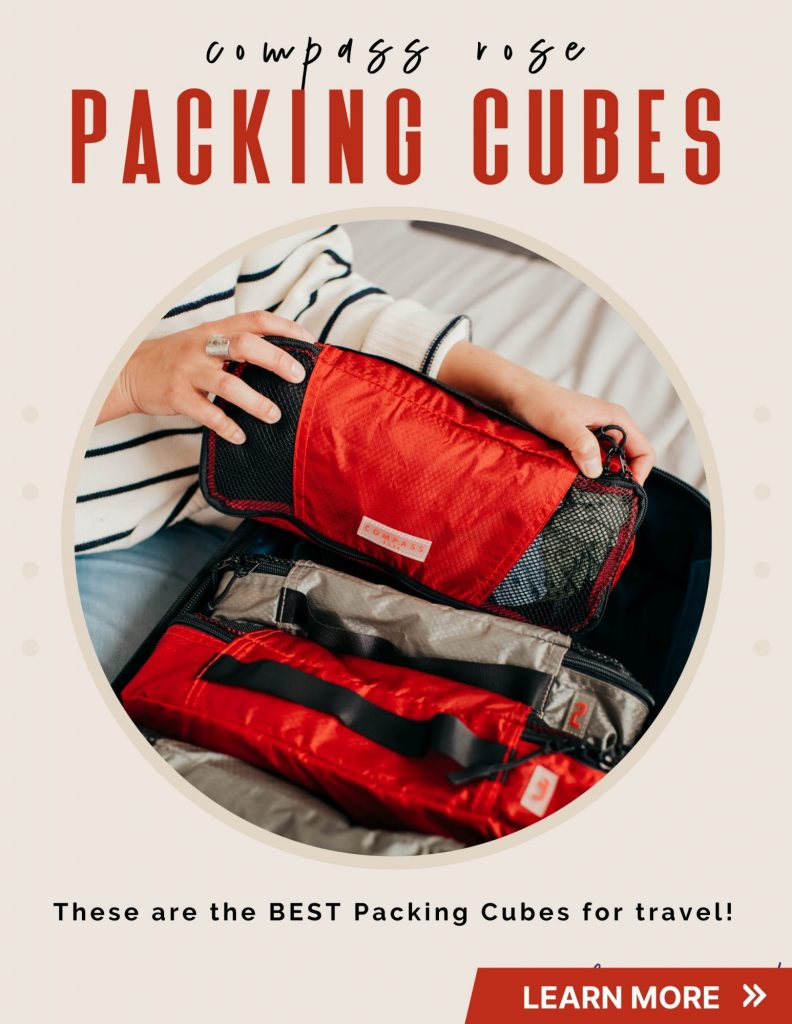

Best Colors to Wear on Safari

Did you know that there are best colors to wear on safari? Before we heading off on our safari vacation in South Africa and Uganda I had no idea how or indeed why the color of clothes your wear on a safari is important but it really is. In this guide we will tell you the worst and best colors to wear on safari and why you should stick to a restricted color palette whether you are going on a safari in Tanzania, South africa or indeed anywhere in Africa.
Important Note : This post may contain affiliate links which means if you click through and make a purchase I will make a small commission at no extra cost to you.
Table of Contents
Why Does the Color of Safari Clothes Matter?
The truth is that color is a really important factor when putting together your safari capsule wardrobe. But why does the color of safari clothes matter?
Blending in With your surroundings
The point of being on safari is seeing the amazing wildlife. If you are wearing neon clothes you will definitely stand out from your bush surroundings.
If you want to see more animals we recommend wearing colors that will help you blend in to the surroundings.
This is important no matter whether you are doing a safari by car, by boat but especially important if you are doing a walking safari.
Keeping clean
It shouldn’t come as a shock that going on a safari isn’t a sterile experience. Chances are you will get dusty and dirty even doing a safari in a car but certainly if you are doing a walking safari.
So you don’t look filthy in your photographs you want to be wearing colors that will not show the dirt so much.
So now you know why it is important to wear and not to wear certain colors on safari we will look in more detail color by color to help you when packing
Packing a Capsule Wardrobe
Keeping to this limited color palette will also help you create and stick to a safari capsule wardrobe which will help you pack light which is an essential for those who are using light aircraft to get to their safari lodges.
While this safari guide is applicable for anywhere in Africa, if you want a country specific packing list check out our dedicated guides:
- What to wear on safari in Botswana
- What to wear on safari in Tanzania
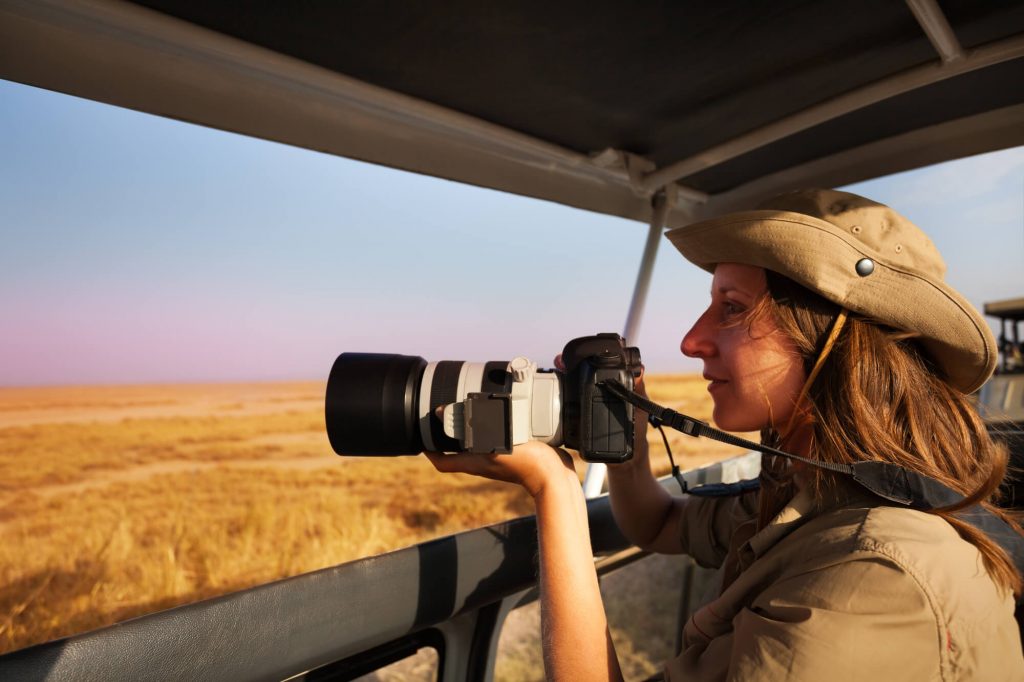
In our opinion the best colors to wear on a safari are:
The reason we recommend these colors over all others is that these are the colors that will help you blend in most with the African landscape be that forests, savannahs or plains.
By blending in you will have a much better chance of seeing wildlife and not drawing attention to yourself in a negative way.
Also we found Khaki shirts the best for not showing up dust while tan, beige and brown were the best in our opinion for hiding the mud when doing gorilla trekking and other muddy activities.
What Colors Not to Wear on Safari

We recommend adding the colors below to your what not to wear on safari list. While it is probably more important for those on walking safaris to adhere to this most strictly we recommend following it whether you are in a car, on foot or on a boat. This is especially important when relating to health and safety.
Blue and Black
Blue and Black tend to be go to in my wardrobes, particularly in my outdoors wardrobes however in my opinion these are the colors that you should most avoid on safari.
This isn’t because they will make you stand up or show up dirt but for a very serious health and safety reason.
Africa unfortunately is home to the Tsete Fly. They are particularly abundant in East and Central Africa and we did see them when we were on safari in Uganda. Tsete Flies are known to cause Sleeping Sickness which is a horrible disease and you should try at all costs to prevent getting bitten by a Tsete Fly to avoid this.
Tsete Flies are attracted to two colors above any other. And you guessed it those colors are Blue and Black. although this is especially important when visiting Central and Eastern Africa I would follow this advice wherever you are going on safari just in case.
Can you Wear White on Safari?
We often get asked whether you can wear white on safari. I think most people have a romantic notion of what a safari wardrobe looks like from watching films and movies where women wear pristine white linen tops while out in the bush and savannah.
However this really isn’t a good or practical idea. Out of all the colors you could wear on a safari white is the color that will make you stand out the most. Also white will absolutely show up dust and dirt more than any other color.
If you have to have a white linen shirt in your safari wardrobe I would personally recommend you wearing this just for dinner in your lodge rather than out on safari drives and walks.
Can you wear bright colors on safari?
It is not recommend that you wear bright colors on safari. Neutral colors, such as tans and khakis are a much better choice. Bright colors will make you stand out which could prevent animals coming out or even attract some that you don’t want to be too interested in you especially on the walking safaris.
We therefore leaving bright colors out of your safari capsule wardrobes.
Is grey ok to wear on safari?
Grey is not the worst color to wear on safari however I would definitely prefer to keep khakis and neutral tones in your wardrobe instead.
Can I wear pink on a safari?
Pink is not as bad as white, blue or black on safari and it doesn’t attract anything in particularly depending on the shade but I personally would still not add pink to my safari wardrobe.
Light pink, similar to white will show up all the dirt and dust and won’t look great in pictures and darker or brighter pinks will make you stand out too much.
Can you wear red on a safari?
Red is not known to attract Tsete Flies however red will make you very conspicuous to the animals and therefore isn’t a recommended color to wear on safari.
Can I wear orange on safari?
Orange no matter the shade is considered a bright color and as such is not recommended to wear on safari. Not only because it will make you stand out to animals but also because insects love orange and you really don’t want to attract more insects towards you on a safari.
Can you wear Camo on Safari?
Although Khaki is a great color for safari you should NEVER wear khaki on a safari. This isn’t anything to do with the Animals but in Africa came or camouflage is almost exclusively used by soldiers and the army. And in fact it is in some places illegal to wear camouflage if you aren’t in the army.
Therefore we recommend leaving anything came behind.
Is it OK to wear black on safari?
No black is a color that you shouldn’t wear on safari. As we mentioned above black attracts Tsete Flies and therefore should be avoided at all costs.
Saturday 1st of July 2023
On what to wear, second to last paragraph, you mention camo, but in the paragraph below, you insert "Khaki" and "came". Not sure if "came" is a different invocation of "camo" or just a typo.
"Although Khaki is a great color for safari you should NEVER wear khaki on a safari." ???
Friday 28th of July 2023
Thanks for pointing this out Bob and I will get this edited. Camo i.e. military camouflage isn't great on safaris as depending on the country you are in it is illegal to wear camouflage outside of the military.
I hope you have a great trip

- Safari Stories
- What To Wear On Safari
Stories: ALL | ADVICE | EXPEDITIONS | DESTINATIONS | NEWS | PROJECTS
What to Wear on Safari
This is our infographic cheat sheet for packing for a safari. it is a visual - & quick - guide on men's and women's safari clothing advice and what to wear on safari - an additional visual travel resource as you prepare for your safari.
⊙ Use our safari clothing packing advice cheat sheet below for handy tips on what to wear on safari and the safari clothing to pack in advance.
⊙ Use this infographic together with our full safari clothing advice for the full picture on what safari clothes to pack for Africa.
⊙ Please also read our comprehensive guidelines for packing for a safari by visiting our expert safari packing advice pages too. Specifically, get detailed information on safari binoculars , safari luggage advice for bush planes and overland safaris, and advice on essential safari accessories for your African travels.
⊙ Please also go to our best-in-the-business safari packing list for your comprehensive, tailor-made travel checklist.
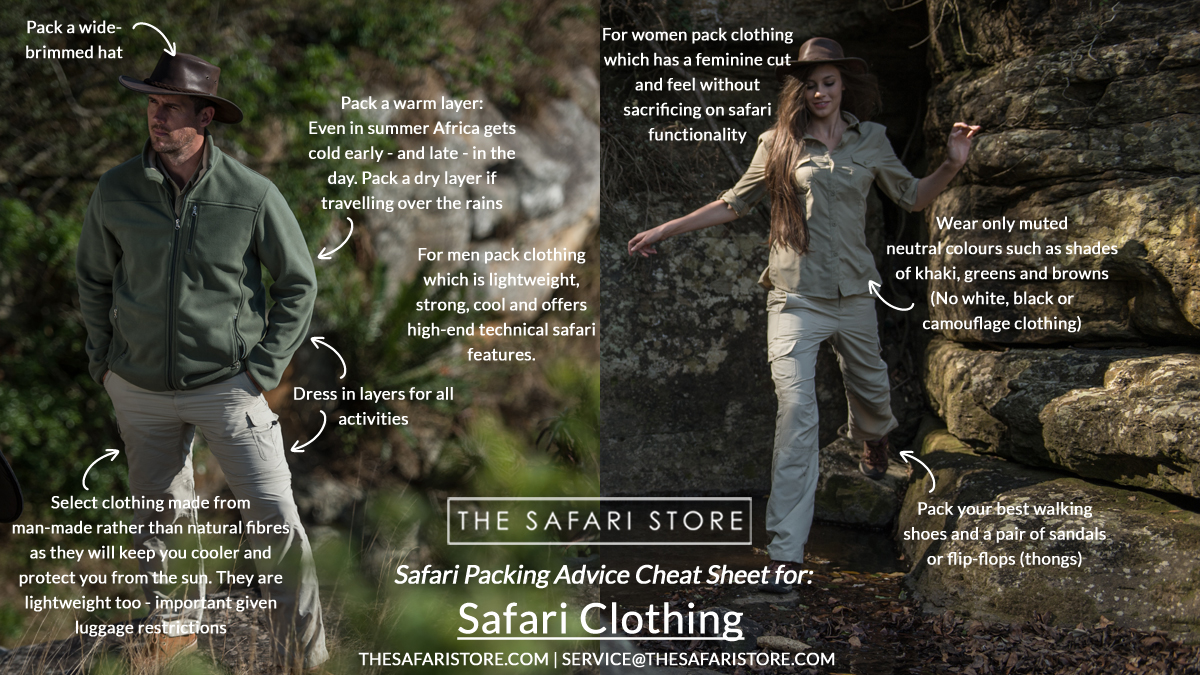
Women's Safari Clothing >
More Stories

Go To Give Back

Safari Clothing Packing Advice: What clothing to pack for your safari.
This website uses cookies for it's shopping basket, you must have cookies enabled in order to use this site.
What to Wear on Safari: A Comprehensive Guide for Your Next Adventure
Stephanie Patterson
Table of Contents
Planning a safari can be an exciting and thrilling experience. However, packing for a safari can be quite challenging, especially when it comes to deciding what to wear.
The right safari outfit should be comfortable, practical, and protective. But with so many options to choose from, it can be overwhelming to know where to start.
As someone who has been on several safaris, I know firsthand the importance of packing the right clothing.
The African bush can be unpredictable, and you want to make sure you are prepared for any situation.
Whether you are embarking on a walking safari or a game drive, your outfit can make all the difference in your overall experience.
In this article, I will provide you with a comprehensive guide on what to wear on safari.
I’ll cover everything from clothing to shoes to accessories. With my tips and advice, you’ll be able to pack the perfect safari outfit that will keep you comfortable, safe, and stylish throughout your trip.
Choosing the Right Clothing
When it comes to safari clothing, comfort and practicality are key. You’ll be spending long hours in a vehicle and walking around in the bush, so you’ll want to wear clothes that are comfortable and allow for ease of movement.
It’s important to choose clothing that is appropriate for the climate and environment. Africa can be hot and humid, so lightweight and breathable fabrics are a must.
Opt for natural fabrics like cotton, linen, and bamboo, which are comfortable and help regulate body temperature.
Neutral colors like khaki, beige, and brown are the best choice for safari clothing. These colors blend in with the natural surroundings and help you to avoid standing out, which can be important when viewing wildlife.
Avoid bright colors and patterns, which can attract unwanted attention from animals and make it difficult to blend in.
When it comes to footwear, closed-toe shoes or boots are a must. You’ll be walking on uneven terrain, so sturdy shoes with good grip are essential.
Sneakers or hiking shoes are a good choice, but avoid sandals or flip flops which offer little protection and can be uncomfortable on long walks.
Layering is also important when it comes to safari clothing. Mornings and evenings can be cool, so bring a warm jacket or sweater that you can easily take on and off.
A lightweight rain jacket is also a good idea, as rain can be unpredictable in some areas.
Lastly, don’t forget to pack a hat and sunglasses. A wide-brimmed hat will protect your face and neck from the sun, while sunglasses will help to reduce glare and protect your eyes from dust and debris.
Colors to Avoid
When packing for a safari, it’s important to keep in mind the colors you wear. Some colors can be a magnet for insects, while others can make you stand out too much in the bush.
Here are some colors to avoid when going on a safari.
Black and Blue: These colors are not recommended as they attract tsetse flies, which are known for their painful bite. In fact, fly traps are often made from blue and black fabric. So, it’s best to avoid these colors altogether.
White: While there is no health and safety reason to avoid white, it’s best to steer clear of this color as it can easily get dirty on safari. The last thing you want is to be stuck with a stained outfit for the rest of your trip.
Bright Colors: Bright, flashy colors should also be avoided as they can make you stand out too much in the bush. Instead, opt for more muted, natural colors like beige, brown, and green. These colors will help you blend in with your surroundings and make it easier to spot wildlife.
Camouflage: While it may seem like a good idea to wear camouflage on safari, it’s actually not recommended. In some countries, it’s even illegal to wear camouflage as it’s associated with military personnel. Stick to neutral colors instead.
By avoiding these colors, you can ensure that your safari experience is comfortable and enjoyable. Stick to neutral, muted colors that will help you blend in with your surroundings and keep you safe from insects.
Layering and Accessories
When packing for a safari, it’s important to consider that temperatures can vary greatly throughout the day. Layering is key to staying comfortable and prepared for any weather conditions.
I always start with a base layer of moisture-wicking fabric to keep me dry and comfortable. Then, I add a mid-layer for warmth, such as a fleece or sweater.
Finally, I top it off with a waterproof and windproof jacket to protect me from the elements. Aside from clothing, there are a few accessories that are essential for a safari.
A hat with a brim is a must-have to protect your face and neck from the sun. Sunglasses are also important to protect your eyes from the glare.
Additionally, a scarf or bandana can be useful for keeping dust out of your face and for warmth during early morning game drives. Another accessory that is often overlooked is a good pair of gloves.
They can be useful for keeping your hands warm during cold morning game drives or for protecting your hands from the sun and wind. Lastly, don’t forget about your feet. Comfortable walking shoes are a must-have for any safari.
Closed-toe shoes with good traction are ideal for walking on uneven terrain. Additionally, packing a pair of sandals or flip-flops for relaxing around camp can be a nice addition.
Overall, layering and having the right accessories can make all the difference in staying comfortable and prepared during a safari.
When it comes to safari footwear, comfort and practicality are key. You’ll be spending a lot of time on your feet, so it’s important to choose shoes that are comfortable for walking long distances and standing for extended periods of time.
At the same time, you’ll want shoes that are durable and protective, as you’ll be walking on uneven terrain and encountering various wildlife. For most safaris, a good pair of walking shoes or boots is essential.
Look for shoes with good traction, ankle support, and sturdy soles. Hiking boots are a great option, as they provide the necessary support and protection while still being comfortable for long walks.
If you’re planning on doing a lot of walking in wet conditions, consider waterproof shoes or boots. This will keep your feet dry and comfortable, even in the rain or when crossing streams.
For hot weather safaris, sandals or open-toed shoes can be a good option.
Look for sandals with good arch support and a comfortable fit. Keep in mind that sandals may not be suitable for all activities, such as walking in areas with thorny vegetation or encountering certain wildlife.
It’s also a good idea to bring a pair of flip-flops or sandals for wearing around camp or in the shower. These can be lightweight and easy to pack, and will give your feet a break from your heavier walking shoes.
Overall, when choosing safari footwear, prioritize comfort, durability, and protection. With the right shoes, you’ll be able to enjoy your safari to the fullest, without worrying about sore feet or blisters.
Additional Tips
Based on my experience, here are a few additional tips to consider when packing for a safari:
- Bring clothes that can be easily layered. Temperatures can vary greatly throughout the day, so it’s important to have options to stay comfortable.
- Consider packing clothes made from lightweight, breathable fabrics such as cotton or linen. These fabrics will help keep you cool and comfortable in hot and humid weather.
- Don’t forget to pack a hat or cap to protect your face and head from the sun. A wide-brimmed hat is ideal as it offers more coverage.
- Invest in a good pair of binoculars. A safari is all about spotting wildlife, and a pair of binoculars will help you see animals that are far away.
- Bring a camera with a good zoom lens. You’ll want to capture all the amazing wildlife sightings, and a zoom lens will help you get up close without disturbing the animals.
- Consider packing a small backpack or daypack to carry essentials such as water, snacks, and sunscreen during game drives.
- Finally, be sure to pack a positive attitude and an open mind. A safari can be an incredible and unforgettable experience, but it’s important to be flexible and open to new experiences.
Similar Content

How to Wear White Eyeshadow: Tips and Tricks for a Bold Look

How to Wear Wedding and Engagement Rings: A Guide for the Newly Engaged

How to Wear Tampons: A Step-by-Step Guide for Beginners

How to Wear Sunglasses with Glasses: Tips and Tricks

How to Wear a Scarf: A Comprehensive Guide for All Seasons

How to Wear Samsung Earbuds: A Step-by-Step Guide

How to Wear Perfume: Tips and Tricks for a Long-Lasting Scent

How to Wear Oversized T-Shirts: A Guide for Guys

How to Properly Wear an N95 Mask: A Step-by-Step Guide

How to Wear Multiple Rings: A Comprehensive Guide
Cancel reply.
Your email address will not be published. Required fields are marked *
Your Question / Comment Your Answer / Comment *
Save my name, email, and website in this browser for the next time I comment.

What To Wear On a Luxury Safari to Kruger National Park
Sharing is caring!
I was invited to visit Johannesburg, Kruger National Park, and Cape Town by South African Tourism, and when I found out I was going on a safari in Kruger National Park I immediately began researching clothes for a safari and what to pack for a safari.
After I read dozens of packing list articles on what to pack, what to bring, and what to leave at home I was still confused about what to wear to a safari.
I decided I needed to create a very detailed guide for what to pack for a safari depending on the season and time of year you visit South Africa.
Y’all know I had to be cute for those Instagram-worthy photos!
Deciding what to wear on safari really depends on the time of year and the weather.
The weather in Africa was nothing as I expected. I was under the impression it was going to be hot but NO, it was freezing!
Freezing! Freezing!
South Africa gets extremely cold and thank Gawd I checked the weather app because I would have been up a creek.
This was my first time visiting the continent so I am not sure what I expected but it definitely was not frigid temps. I will take the guesswork out of what you need to pack for this epic adventure.
The links in this post may be affiliate links. That means that if you click them and make a purchase, this site makes a commission. It will have no impact on the price you pay or the experience of your purchase.
I will cover what to wear on safari, what to bring on safari, what colors are appropriate for safari, as well as what you can probably leave behind at home.
Before you begin purchasing clothes for a safari you need to determine what time of the year you will be visiting Africa because that determines what you will need to pack.
Hopefully, I will answer all of your questions and this will be the only safari packing list you will need. Take your time and go through each section as the article is long but extremely thorough.
When is the Best Time to Visit the Kruger National Park?
The best time to visit the Kruger National Park is the dry season from May to September for the best game viewing and walking safari conditions.
Vegetation is low and sparse at this time of year, making animals easier to spot and track, while the permanent water sources offer a rewarding safari experience in the Kruger.
Generally considered a year-round destination, choosing exactly when to go to the Kruger depends on what you want to experience.
Kruger has two distinct seasons, the dry winter from May to October, and the summer rainy season from November to April. However, every day in the Kruger National Park is a one-of-a-kind safari adventure.
The best time to visit Kruger National Park is during the dry winter months from May to September.
At this time, the bush thins out, and animals congregate around waterholes and rivers. Conditions tend to get better as winter progresses, and September is particularly lovely since the mornings are less chilly than in mid-winter.
The best wildlife viewing time also coincides with the low season, making it even more attractive.
May to September (Dry season)
High Season
December to January and July to August (Especially during school holidays)
April to mid-June and September to November (Except for the October school holiday)
Best Weather
April to May and September to October (Mild weather and little rain)
Worst Weather
June to August (Chilly mornings and nights) and December to February (Hot and humid)
Now that we have discussed the weather and you have determined what time of the year is best for you to go on a safari let’s get to discuss what you need to pack.
The 7 Safari Outfits you will Pack for your First Safari
There are plenty of options for what to wear on an African safari but I suggest sticking with primarily khaki or olive colors.
The safari tours in Kruger National Park are viewed from within the confines of an overland truck or 4×4 car.
You will be driving around the bush all day in an open jeep so be prepared to get covered in dust.
With that being said understand that shirts, pants and shoes, and whatever else you may be wearing will get dirty and dusty.
- Note: It is illegal to wear Camouflage in Kruger National Park, so stick to your one-toned khaki clothing
P & G Recommended Safari Packing List
3 short-sleeve tops
2 long-sleeve tops
1 windbreaker jacket
1 fleece or warm jacket
2 bras
5 underwear
1 sunglasses
P & G Recommended Shoe List
1 pair of comfortable sneakers
1 Pair of hiking boots
1 pair sandals
Layers, Layers, and More Layers
As I said earlier if you are under the impression South Africa was warm all year round nothing could be farther from the truth. I realized this as soon as I landed in Johannesburg because it was chilly AF there and it only got colder as we traveled from Jo’Burg to Kruger National Park.
The temperatures dropped to a low of 30 degrees as soon as the sun started to set.
Game drives are timed for when animals are most active . Typically, this means leaving your room for a 2-4 hour game drive beginning at sunrise.
I chose not to do the early morning game drive because I hate being cold and I am not a morning person.
Once you return from the morning game drive you will return to the room for lunch and relaxation, followed by another game drive late in the afternoon.
The temperatures will begin to cool off as soon as the sun sets – it goes from feeling relatively nice out to freezing within a matter of minutes which is why layers are essential to pack for a safari in Kruger National Park.
A good packing list for safari will include both short and long sleeve cotton shirts to wear during the day, warm sweaters, and a light jacket to wear in the early morning hours and in the evenings.
I also recommend bringing a scarf, a hat, and gloves.
Safari Color Guide
Do colors really matter?
Yes, Game-viewing should be done by blending in with your surroundings which will enhance your experience.
Watching wildlife behaving naturally is the best way to see Africa’s spectacular wildlife. The color of your clothing can potentially scare off or disturb your sighting – something you want to avoid.
The best safari color is khaki followed by olive, tans, and browns because they are good at handling dirt.
Remember to keep it casual and comfortable with tee shirts, long-sleeved shirts, shorts, hiking boots, and athletic socks to keep the blisters away.
What Colors you Shouldn’t Wear on Safari
While Black is my favorite color it is not appropriate for a safari because not only does it stand out in the bush i f you are traveling to an area with tsetse flies they are attracted to black and blue colors.
The last thing you want to do is attract this dreaded fly – an insect with a painful bite – so much so that fly traps are made from blue and black fabric.
With the amount of dust in the bush, white is hardly recommended as it gets dirty very easily therefore w hen on a game drive, you are expected to blend in with the bush as much as possible.
Wear neutral colors, such as khaki, beige, taupe, or grey.
Having considered what to wear on safari, here’s a selection of the clothes I recommend for your safari packing list.
1. Cotton Tee’s (Long & Short)
While nights are cold when in the bush, days are actually warm and you will often be wandering around in a t-shirt.
Don’t make the rookie mistake I made on my first safari and only pick t-shirts in neutral colors.
You will want something that is super lightweight that can be washed in the sink and will dry quickly.
Khaki pants
Long pants and long-sleeved tops will keep your skin covered and protect you from the cold and wind, sun, and insect bites.
While many places in Africa can get really hot, remember that some can also get downright chilly and t his is especially true for Kruger National Park.
Long pants are especially useful if you’re going on a walking safari or a game drive where you’re allowed to sometimes exit the vehicle
Even though it was chilly I still decided on short Khaki pants instead of long. I suggest safari shorts that are comfortable, durable, and weather-resistant, and the color of course blends in with the environment .
While many articles I read said don’t wear shorts I decided to take a chance and needless to say I did not get eaten alive by mosquitos or any of the bugs for that matter.
I did spray on a ton of perfume like I was the old dude at the club.
Safari Light sweaters & Layering
As I have stated 5 additional times earlier in this article it gets really cold in South Africa specifically Kruger National Park.
The climate and weather in Africa range from one extreme to another, from extremely cold freezing nights to very hot and dusty afternoons.
Layering is very convenient in these situations. Your layering should include at least one warm layer especially if you plan to go on early morning game drives.
A warm jacket
Multi-functional jackets with various pockets and neutral colors are what you need.
With these, you can safely carry your small safari accessories such as a camera, pair of binoculars, guide books, etc. safari jackets are especially needed on the game drives.
A Scarf, a Hat, and Gloves
I also suggest a wide-brimmed safari hat as it will protect you from the heat and shield your eyes from the glare of the sun and enables you to see animals at a distance.
You may need a chin strap to keep the hat firm on your head. It would even be much better if you got a waterproof hat, it would shield you from both the rain and the sunshine.
If you happen to be traveling during the cold season, from May to August, I suggest packing a set of thermals to put on under your safari clothes so you can stay warm.
I traveled to Kruger in September and it was still quite chilly (Freezing at night).
Comfortable Shoes & Boots for Safari
Footwear is an item that should not be overlooked when packing for your safari. Leave your cute shoes at home for your safari unless you want to be limping by the end of the day.
Once you leave the lodge you will need something comfortable to withstand the African terrain and will not leave your feet blistered.
Safari Socks
The importance of a good quality well fitting sock is imperative on an African safari. Your feet will take a lot of punishment so choose your socks carefully.
Nice Sandals
Once you return to your room you will want to relax and put your feet up so I highly suggest packing a nice pair of sandals that you can also wear to dinner.
Pack a swimsuit and some casual clothing for around camp.
Additional Items you will need:
Mosquito repellent .
I didn’t see or get bit by any mosquitoes in Kruger National Park but I did spray a ton of mosquito repellent, wore the armbands and I lathered on citronella oil for extra precautions.
Sun Screen
You will also want to protect your skin from sun damage so make sure you apply sunscreen generously.
For the same reasons, make sure to also protect your eyes with a good pair of sunglasses.
A power bank
You will need it to charge your smartphone on the go. Make sure to also bring a plug adaptor too.
Jabulani Safari Lodge provided binoculars for its guest so I didn’t even need to purchase any so make sure you check with the lodge before you purchase any to make sure you need them.
If the lodge you are staying at doesn’t provide binoculars you won’t want to miss any hunting scene or any bird watching, so binoculars are another essential item for your safari packing list.
Camera vs iPhone
A safari is a content creator’s dream. I don’t think I have ever taken as many photos on any given day as I did during my safari trips.
I didn’t bring my big fancy camera but instead, I simply used my iPhone and my pictures look like they came out of National Geographic!
I just didn’t find it feasible to carry around a big camera when iPhone photos are equally as amazing. I have an iPhone 14 and the picture quality was excellent so if are eligible for an upgrade this is the time.
Toiletry bag
Last but not least is a toiletry bag because if you are anything like me I don’t leave home without my facial products so pick one that has multiple pockets and zips and that can be easily hung.
Documents you Must Pack
Losing documents is a very common occurrence, especially while traveling. As a result, packing the necessary documents safely should be your first priority before packing the rest of your luggage.
- A passport that has all of the necessary visas for every nation that your safari will visit or pass through.
- A small amount of cash, bank cards, and/or traveler’s checks are recommended. These days, you can also utilize e-wallet apps to avoid lugging around multiple credit cards and cash.
- Air tickets and travel vouchers for any pre-arranged organized safaris that have been purchased.
- Where necessary, vaccination certificates (yellow fever, mumps, etc.) will be provided. Some immunizations must be administered many weeks in advance (see Vaccinations needed for your African Safari).
- Medical treatment may include malaria prevention medications (see Malaria Made Simple) as well as any personal medications (also take your prescription in case of an emergency-your medication gets lost, wet, eaten by a baboon, etc).
- The specifics of your travel insurance policy Your policy number, as well as the contact information for claims and emergencies, will be provided.
- Prepare a copy of all of your important documents, including your airline tickets, travel insurance policy, immunization records, and records of prescriptions and prescriptions.
Where to Stay in Kruger National Park
Jabulani safari lodge – a luxury resort.
Jabulani Safari lodge is just breathtaking, only a short drive away from Hoedspruit Airport and you are literally in the South African Bush!
The style and ambiance of Jabulani exude luxury with hints of home. The main area features an elegant dining room and lounge that lead to an outside wooden deck lying beneath the shade of Leadwood trees.
This is where you will enjoy breakfast, lunch, and dinner daily while overlooking the waterhole.
The signature suspension bridge stretches gracefully over the river bed, connecting to the six Jabulani suites and Zindoga Villa which is how you will get to your room from the main area.
Camp Jabulani is a superbly luxurious safari getaway. It’s all rich wood furniture, crystal glasses, and silver service. The meals are feasts, the wines are fine, the lounge area has wireless internet, and the bushveld views from the wooden deck.
THE ROOM AT JABULANI:
This luxury South African Safari lodge has six suites which are secluded, with canvas walls that roll up to reveal the surrounding wilderness.
Each suite is air-conditioned and has a lounge area and fireplace for cold nights, an en-suite bathroom with a stone tub and glass-walled outdoor shower, and a plunge pool.
The beds are huge, with pure cotton sheets and draped mosquito nets. The larger Zindoga Villa which is the villa I stayed in has two individual suites linked by a lounge and serviced by a private chef, butler, and game ranger.
I have never walked into a building or room and been speechless until I walked into our suite. There were elephant towels on the bed and the attention to detail is just outstanding, even down to the little natural leaf-cut elephants on the flannels.
The view from our room overlooked the reserve where you could see animals walking past. Check out the full-length video of our room on my IG reel.
- Kapama Private Game Reserve supports a wide variety of wildlife
- Plenty of activities including game drives, guided walks, and spa therapy
- Exclusive accommodation consisting of six suites
- Accredited Relais & Châteaux property
- Elephant Experience is a once-in-a-lifetime opportunity
The contact numbers to make a reservation at Jabulani Safari are:
• Cape Town Reservations +27 (0) 21 794 9050 • Durban Reservations: +27 (0) 31 941 5945 • Johannesburg Reservations: +27 (0) 10 446 8045.
CAMP JABULANI RATES & POLICIES
- Rate Policy: Daily in USD
- Standard Room: from $6,489-$6,489 (USD)
- Suite: from $1,675-$1,675 (USD)
- Credit Cards: Credit Cards Are Accepted
- Reservation Policy: Reservations must be guaranteed with a credit card
- Included Meals: Full Breakfast Included
- Deposit Policy: 25% to confirm the reservation, 2nd 25% 60 days prior to arrival. Full prepayment is due within 48 hours of arrival.
- Camp Jabulani Cancellation Policy: 25% 31-60 days prior to arr, 50% 15-30 days, 100% 1-14 days
Alternatively, you can check availability and book online by clicking here.
Remember, there is no schedule at Camp Jabulani, no program with dictated times and activities. Instead, the management team will consult with you prior to your arrival to better understand your needs and schedule activities accordingly.
Some of Camp Jabulani’s amazing include the following:
- Daily elephant back safaris
- Safari drives in the Big Five private Kapama Reserve
- Visits to the Hoedspruit Endangered Species Centre
- Indulgent treatments in the outdoor Therapy Lapa
- Gastronomic delights at the hands of the masterful culinary team
- Hot air balloon excursions over the reserve
The lodge is easily accessible via road, via daily scheduled flights from Johannesburg, or via private charter flights.
Click here to book your stay at Jabulani Game Reserve!
MAKE A RESERVATION
View this post on Instagram A post shared by Tomiko Harvey | 50 + Luxury Travel Influencer (@tomiko.harvey)
DO YOU NEED TRAVEL INSURANCE?
I think most people have questions about where to go for medical care in an emergency. First, I should note that if you’re on spring break, chances are slim that you’ll be needing emergency care.
Still, better safe than sorry!
I can’t say this enough but please get insurance when traveling to South Africa! Even if you are only going on a short trip, you should always travel with insurance.
Have fun while visiting South Africa , but take it from someone who has racked up thousands of bucks on an insurance claim before, you need it.
Make sure to get your insurance before you head off on an adventure! I highly recommend Travelex Insurance.
Ready to plan your trip, grab my FREE Vacation Planner to help you plan your trip in the time it takes to watch your favorite TV show!
If you would like to buy me a coffee click here Passports and Grub click here!

ADDITIONAL ARTICLES FOR TRAVELING
Is Johannesburg Safe for Tourists
Is Cape Town Safe for Tourists
Is South Africa Safe for American Tourists
Have you been on a safari? Did I leave anything out of my packing list? Do you have any further recommendations on clothes for a safari? would love to hear your thoughts so leave me a comment on Facebook , Twitter , or Instagram .
ARE YOU ALSO ON PINTEREST?
Why not save this post to your Pinterest board for later? I am also on Pinterest so feel free to follow Passports and Grub boards and get the latest pin directly.
Similar Posts

Valentine’s Day Gifts for the Traveler in your life
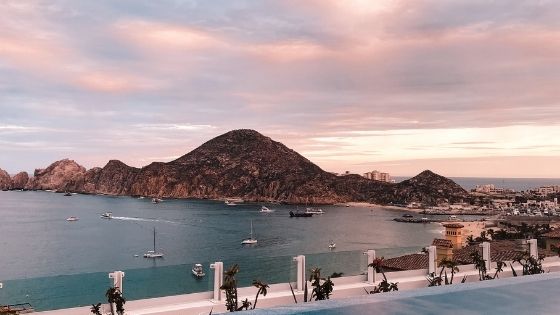
Is Mexico Safe for Travel in 2024? What Every Traveler Should Know

The Best Things To Do In Louisville, KY This Weekend
![safari clothing colors Insider’s Guide To Ruby Falls In Chattanooga [Video]](https://passportsandgrub.com/wp-content/uploads/2021/01/Ruby-Falls-Lookout-Mountain.png)
Insider’s Guide To Ruby Falls In Chattanooga [Video]

Weekend Getaway – How To Get From Lafayette to New Orleans

13 Pleasantly Warm Places You Must Visit in October
- Pingback: Jabulani Safari Reserve: Luxury Lodge in Kruger National Park
- Pingback: Best Romantic Getaways in South Africa [Updated December 2023]
- Pingback: Is Cape Town Safe for American Tourists (2023 Safety Guide + Tips)
- Pingback: Is Durban Safe for Travel in 2023 - South Africa Travel Advisory
- Pingback: Long Tail vs Short Tail Keywords: Your Guide to SEO Success
Leave a Reply Cancel reply
Your email address will not be published. Required fields are marked *
This site uses Akismet to reduce spam. Learn how your comment data is processed .

40 Facts About Elektrostal
Written by Lanette Mayes
Modified & Updated: 21 May 2024
Reviewed by Jessica Corbett

Elektrostal is a vibrant city located in the Moscow Oblast region of Russia. With a rich history, stunning architecture, and a thriving community, Elektrostal is a city that has much to offer. Whether you are a history buff, nature enthusiast, or simply curious about different cultures, Elektrostal is sure to captivate you.
This article will provide you with 40 fascinating facts about Elektrostal, giving you a better understanding of why this city is worth exploring. From its origins as an industrial hub to its modern-day charm, we will delve into the various aspects that make Elektrostal a unique and must-visit destination.
So, join us as we uncover the hidden treasures of Elektrostal and discover what makes this city a true gem in the heart of Russia.
Key Takeaways:
- Elektrostal, known as the “Motor City of Russia,” is a vibrant and growing city with a rich industrial history, offering diverse cultural experiences and a strong commitment to environmental sustainability.
- With its convenient location near Moscow, Elektrostal provides a picturesque landscape, vibrant nightlife, and a range of recreational activities, making it an ideal destination for residents and visitors alike.
Known as the “Motor City of Russia.”
Elektrostal, a city located in the Moscow Oblast region of Russia, earned the nickname “Motor City” due to its significant involvement in the automotive industry.
Home to the Elektrostal Metallurgical Plant.
Elektrostal is renowned for its metallurgical plant, which has been producing high-quality steel and alloys since its establishment in 1916.
Boasts a rich industrial heritage.
Elektrostal has a long history of industrial development, contributing to the growth and progress of the region.
Founded in 1916.
The city of Elektrostal was founded in 1916 as a result of the construction of the Elektrostal Metallurgical Plant.
Located approximately 50 kilometers east of Moscow.
Elektrostal is situated in close proximity to the Russian capital, making it easily accessible for both residents and visitors.
Known for its vibrant cultural scene.
Elektrostal is home to several cultural institutions, including museums, theaters, and art galleries that showcase the city’s rich artistic heritage.
A popular destination for nature lovers.
Surrounded by picturesque landscapes and forests, Elektrostal offers ample opportunities for outdoor activities such as hiking, camping, and birdwatching.
Hosts the annual Elektrostal City Day celebrations.
Every year, Elektrostal organizes festive events and activities to celebrate its founding, bringing together residents and visitors in a spirit of unity and joy.
Has a population of approximately 160,000 people.
Elektrostal is home to a diverse and vibrant community of around 160,000 residents, contributing to its dynamic atmosphere.
Boasts excellent education facilities.
The city is known for its well-established educational institutions, providing quality education to students of all ages.
A center for scientific research and innovation.
Elektrostal serves as an important hub for scientific research, particularly in the fields of metallurgy , materials science, and engineering.
Surrounded by picturesque lakes.
The city is blessed with numerous beautiful lakes , offering scenic views and recreational opportunities for locals and visitors alike.
Well-connected transportation system.
Elektrostal benefits from an efficient transportation network, including highways, railways, and public transportation options, ensuring convenient travel within and beyond the city.
Famous for its traditional Russian cuisine.
Food enthusiasts can indulge in authentic Russian dishes at numerous restaurants and cafes scattered throughout Elektrostal.
Home to notable architectural landmarks.
Elektrostal boasts impressive architecture, including the Church of the Transfiguration of the Lord and the Elektrostal Palace of Culture.
Offers a wide range of recreational facilities.
Residents and visitors can enjoy various recreational activities, such as sports complexes, swimming pools, and fitness centers, enhancing the overall quality of life.
Provides a high standard of healthcare.
Elektrostal is equipped with modern medical facilities, ensuring residents have access to quality healthcare services.
Home to the Elektrostal History Museum.
The Elektrostal History Museum showcases the city’s fascinating past through exhibitions and displays.
A hub for sports enthusiasts.
Elektrostal is passionate about sports, with numerous stadiums, arenas, and sports clubs offering opportunities for athletes and spectators.
Celebrates diverse cultural festivals.
Throughout the year, Elektrostal hosts a variety of cultural festivals, celebrating different ethnicities, traditions, and art forms.
Electric power played a significant role in its early development.
Elektrostal owes its name and initial growth to the establishment of electric power stations and the utilization of electricity in the industrial sector.
Boasts a thriving economy.
The city’s strong industrial base, coupled with its strategic location near Moscow, has contributed to Elektrostal’s prosperous economic status.
Houses the Elektrostal Drama Theater.
The Elektrostal Drama Theater is a cultural centerpiece, attracting theater enthusiasts from far and wide.
Popular destination for winter sports.
Elektrostal’s proximity to ski resorts and winter sport facilities makes it a favorite destination for skiing, snowboarding, and other winter activities.
Promotes environmental sustainability.
Elektrostal prioritizes environmental protection and sustainability, implementing initiatives to reduce pollution and preserve natural resources.
Home to renowned educational institutions.
Elektrostal is known for its prestigious schools and universities, offering a wide range of academic programs to students.
Committed to cultural preservation.
The city values its cultural heritage and takes active steps to preserve and promote traditional customs, crafts, and arts.
Hosts an annual International Film Festival.
The Elektrostal International Film Festival attracts filmmakers and cinema enthusiasts from around the world, showcasing a diverse range of films.
Encourages entrepreneurship and innovation.
Elektrostal supports aspiring entrepreneurs and fosters a culture of innovation, providing opportunities for startups and business development.
Offers a range of housing options.
Elektrostal provides diverse housing options, including apartments, houses, and residential complexes, catering to different lifestyles and budgets.
Home to notable sports teams.
Elektrostal is proud of its sports legacy, with several successful sports teams competing at regional and national levels.
Boasts a vibrant nightlife scene.
Residents and visitors can enjoy a lively nightlife in Elektrostal, with numerous bars, clubs, and entertainment venues.
Promotes cultural exchange and international relations.
Elektrostal actively engages in international partnerships, cultural exchanges, and diplomatic collaborations to foster global connections.
Surrounded by beautiful nature reserves.
Nearby nature reserves, such as the Barybino Forest and Luchinskoye Lake, offer opportunities for nature enthusiasts to explore and appreciate the region’s biodiversity.
Commemorates historical events.
The city pays tribute to significant historical events through memorials, monuments, and exhibitions, ensuring the preservation of collective memory.
Promotes sports and youth development.
Elektrostal invests in sports infrastructure and programs to encourage youth participation, health, and physical fitness.
Hosts annual cultural and artistic festivals.
Throughout the year, Elektrostal celebrates its cultural diversity through festivals dedicated to music, dance, art, and theater.
Provides a picturesque landscape for photography enthusiasts.
The city’s scenic beauty, architectural landmarks, and natural surroundings make it a paradise for photographers.
Connects to Moscow via a direct train line.
The convenient train connection between Elektrostal and Moscow makes commuting between the two cities effortless.
A city with a bright future.
Elektrostal continues to grow and develop, aiming to become a model city in terms of infrastructure, sustainability, and quality of life for its residents.
In conclusion, Elektrostal is a fascinating city with a rich history and a vibrant present. From its origins as a center of steel production to its modern-day status as a hub for education and industry, Elektrostal has plenty to offer both residents and visitors. With its beautiful parks, cultural attractions, and proximity to Moscow, there is no shortage of things to see and do in this dynamic city. Whether you’re interested in exploring its historical landmarks, enjoying outdoor activities, or immersing yourself in the local culture, Elektrostal has something for everyone. So, next time you find yourself in the Moscow region, don’t miss the opportunity to discover the hidden gems of Elektrostal.
Q: What is the population of Elektrostal?
A: As of the latest data, the population of Elektrostal is approximately XXXX.
Q: How far is Elektrostal from Moscow?
A: Elektrostal is located approximately XX kilometers away from Moscow.
Q: Are there any famous landmarks in Elektrostal?
A: Yes, Elektrostal is home to several notable landmarks, including XXXX and XXXX.
Q: What industries are prominent in Elektrostal?
A: Elektrostal is known for its steel production industry and is also a center for engineering and manufacturing.
Q: Are there any universities or educational institutions in Elektrostal?
A: Yes, Elektrostal is home to XXXX University and several other educational institutions.
Q: What are some popular outdoor activities in Elektrostal?
A: Elektrostal offers several outdoor activities, such as hiking, cycling, and picnicking in its beautiful parks.
Q: Is Elektrostal well-connected in terms of transportation?
A: Yes, Elektrostal has good transportation links, including trains and buses, making it easily accessible from nearby cities.
Q: Are there any annual events or festivals in Elektrostal?
A: Yes, Elektrostal hosts various events and festivals throughout the year, including XXXX and XXXX.
Elektrostal's fascinating history, vibrant culture, and promising future make it a city worth exploring. For more captivating facts about cities around the world, discover the unique characteristics that define each city . Uncover the hidden gems of Moscow Oblast through our in-depth look at Kolomna. Lastly, dive into the rich industrial heritage of Teesside, a thriving industrial center with its own story to tell.
Was this page helpful?
Our commitment to delivering trustworthy and engaging content is at the heart of what we do. Each fact on our site is contributed by real users like you, bringing a wealth of diverse insights and information. To ensure the highest standards of accuracy and reliability, our dedicated editors meticulously review each submission. This process guarantees that the facts we share are not only fascinating but also credible. Trust in our commitment to quality and authenticity as you explore and learn with us.
Share this Fact:

Image Unavailable

- To view this video download Flash Player

XL Flag Elektrostal Moscow oblast | landscape flag | 2.16m² | 23sqft | 120x180cm | 4x6ft - 100% Made in Germany - long lasting outdoor flag
Purchase options and add-ons, about this item.
- 100% Made in Germany » ... because the first impression last, quality flag for representative purposes *****
- State-of-the-art High-Tech Outdoor Fabric » One air-permeable 110 GSM Polyester to keep wind forces low and lifetime high
- Mirrored Back » Image printed on the front, mirrored image 100% visible on the rear side
- Landscape flag | 2.16m² | 23sqft | 120x180cm | 4x6ft
- Show your pride for your hometown with the Elektrostal flag! Made with quality materials and vibrant colors, this flag is the perfect way to display your patriotism and love for your city. Fly it proudly at home, at events, or even in your car. Get yours today and show your Elektrostal pride!
- The flag of Elektrostal, Moscow Oblast, is a striking combination of Old Glory red, representing strength and courage at 81%, complemented by a subtle touch of light grey at 5% for balance and harmony. The bold black stripe at 3% adds a touch of sophistication, while the shimmering gold stripes at 3% each symbolize prosperity and success. The flag is completed with a touch of very dark grey at 1%, representing the city s resilience and
- Elektrostal Moscow oblast
Product information
Warranty & support, looking for specific info, product description.
Flag: Elektrostal Moscow oblast landscape flag | 2.16m² | 23sqft | 120x180cm | 4x6ft Elektrostal Moscow oblast Elektrostal obwód moskiewski , flaga ???????????? ?????????? ??????? Since we know how important your external presentation is, we print our Elektrostal Moscow oblast flag for your representative appearance using the most modern machines in Germany. To ensure your maximum flexibility, we have equipped the flags with quality metal eyelets, to let you simply attach these flags to any flagpole. To let you use the flags for a long time, we have strengthened the flag using double safety seams and a tear proof strap at the side of the pole. Due to the quality of this business flag, you show a particular degree of the closeness to Elektrostal Moscow oblast. Details about this flag This landscape Elektrostal Moscow oblast flag is a quality product Made in Germany made of 110g/m² gloss polyester. This Elektrostal Moscow oblast flag is wind- and weather-resistant and highly durable. The flag colors are intensive and UV-resistant. This flag is specially made for outer space. This Elektrostal Moscow oblast flag will be delivered with a double safety-seam as well as with 2 metal eyelets to hoist at the flag pole. The metal eyelets give you great flexibility for placing this flag on any flagstaff. The mast side is reinforced with a white hem. The quality flag material and the metal eyelets will take care of a long endurance of this Elektrostal Moscow oblast flag. If required, the flag can be washed at 60 degrees Celsius. Recommended height of flag pole Elektrostal Moscow oblast flags of 2.16m² | 23sqft | 120x180cm | 4x6ft look best with flagpoles of around 6m | 18ft height. Need a bigger size or an other configuration? We can provide bigger sizes, other configurations, exclusive indoor ...
Customer reviews
Customer Reviews, including Product Star Ratings help customers to learn more about the product and decide whether it is the right product for them.
To calculate the overall star rating and percentage breakdown by star, we don’t use a simple average. Instead, our system considers things like how recent a review is and if the reviewer bought the item on Amazon. It also analyzed reviews to verify trustworthiness.
No customer reviews
- Amazon Newsletter
- About Amazon
- Accessibility
- Sustainability
- Press Center
- Investor Relations
- Amazon Devices
- Amazon Science
- Sell on Amazon
- Sell apps on Amazon
- Supply to Amazon
- Protect & Build Your Brand
- Become an Affiliate
- Become a Delivery Driver
- Start a Package Delivery Business
- Advertise Your Products
- Self-Publish with Us
- Become an Amazon Hub Partner
- › See More Ways to Make Money
- Amazon Visa
- Amazon Store Card
- Amazon Secured Card
- Amazon Business Card
- Shop with Points
- Credit Card Marketplace
- Reload Your Balance
- Amazon Currency Converter
- Your Account
- Your Orders
- Shipping Rates & Policies
- Amazon Prime
- Returns & Replacements
- Manage Your Content and Devices
- Recalls and Product Safety Alerts
- Conditions of Use
- Privacy Notice
- Consumer Health Data Privacy Disclosure
- Your Ads Privacy Choices

IMAGES
COMMENTS
What colour should you wear on safari? We recommend neutral safari clothing for your African travels. This includes shades of khaki, brown, beige/tan, and green. These colours blend in well with the bush and are best-suited to safari travel for a few important reasons.
Safari clothing should blend in with the environment. You should wear beige, green, and brown colored clothes. They are the staple colors of safari wear because they blend into the environment and can provide a better game-viewing experience. While wearing, bright colors such as red are said to scare off animals and make you stand out.
Black and blue clothing. East Africa is home to the tsetse fly which is attracted to dark colors and packs a nasty bite - best avoided by wearing lighter colours. Bright clothing. Don't draw attention to yourself if you want the best chance of spotting wildlife. Tuxedos & ballgowns.
Wear neutral colors, such as khaki, beige, taupe or grey. Black and dark blue are thought to attract the African tse tse flies, whereas predators identify red with wounded animals. With the amount of dust in the bush, white is hardly recommended as it gets dirty very easily.
1. Neutral Earth Colors for your Safari Outfit. Neutral-colored tones like khaki, beige, brown, and olive green work best to help you blend in with the natural surroundings of the African wilderness and are less likely to attract insects. Another tip to keep insects away on safari: avoid applying strong smelling perfume.
What to wear on safari: Clothes. T-shirts in neutral or earthy colours x 5. The green t-shirt in the photo above is by Mountain Equipment. I love it so much I bought three! Long trousers x 1 pair. I really like my lightweight ones from The North Face. Shorts x 1 pair.
2 warm fleece tops or jackets (good for a summer or winter safari outfit) 2 pairs of flip-flops or sandals (one for the wild and one for at the lodge) 2 safari dresses (for at the lodge) 2 swimming costumes. 1 waterproof jacket. 1 kikoy or sarong. 1 wide-brim hat or baseball cap. 1 beanie.
3.1 Neutral-Colored Clothing. Neutral colors such as khaki, beige, olive green, and light brown are the go-to choices for safari clothing. These colors help you blend into the natural surroundings and minimize the chances of startling wildlife. Avoid bright colors and flashy patterns, as they can attract unwanted attention from animals.
Top tips for selecting safari clothing with the best in safari, travel, and outdoor clothing technology & garment engineering. 1. Select clothing which is easy to pack, dries quickly, and wicks moisture away from the skin. 2. Keep bugs at bay: Get added defence by selecting clothing that offers a built-in anti-insect treatment.
In General. Wear lightweight safari clothing made with natural fibers that breathe. You do not want to take clothing with synthetic fabrics. The same general rules here apply to both men and women, but feel free to accessorize differently. Do bring some extra safari clothing for colder weather.
When going on a Tanzanian safari, wear clothes with neutral colors like Brown, Jungle Green and Beige that blend well with the Tanzanian Savannah. Avoid black and dark blue clothing since they easily attract tsetse flies. Also avoid white and bright colors since they get dirty easily. Let's take a deeper dive into the topic and discuss the ...
Clothing Colors for Safari. When it comes to choosing the right clothing colors for a safari adventure, it's important to consider both practicality and style. The colors you wear can affect your comfort, visibility, and overall experience in the wild. In this section, we will explore the benefits of neutral and earthy tones, as well as why ...
The Compass Rose Packing Cubes are now offered in two sizes: slim and medium. The slim size cubes measure 13 x 5 x 2.8, and the medium size cubes measure 2.8 x 13 x 8.5. Both fit an international carry-on suticase and can help you organize and compress clothing items. The medium sizes is great for bulkier items.
Amazon. Unbound Merino Wool V-Neck. MSRP - $85 | Material - Merino Wool. Our favorite women's t-shirt for safari and travel is the Unbound Wool V-Neck. A merino wool shirt is a worthy investment and one of the best travel clothes for any trip. Despite the price, we've already transitioned a lot of our wardrobe to the material.
Best Colors to Wear on Safari. In our opinion the best colors to wear on a safari are: Khaki. Brown. Green. Tan. Beige. The reason we recommend these colors over all others is that these are the colors that will help you blend in most with the African landscape be that forests, savannahs or plains.
What to Wear on Safari. This is our infographic cheat sheet for packing for a safari. it is a visual - & quick - guide on men's and women's safari clothing advice and what to wear on safari - an additional visual travel resource as you prepare for your safari.
Best Africa Safari Clothing Colors. Most PHs recommend dull earth colors in clothing. Camouflage patterns are okay in some countries, frowned upon or even banned in others. Or so I'm told. I've yet to have any camo clothing confiscated, and many PHs are wearing it. But many frown on it, so ask before you show up looking like a desert ninja.
Neutral colors like khaki, beige, and brown are the best choice for safari clothing. These colors blend in with the natural surroundings and help you to avoid standing out, which can be important when viewing wildlife. Avoid bright colors and patterns, which can attract unwanted attention from animals and make it difficult to blend in.
Wear neutral colors, such as khaki, beige, taupe, or grey. Having considered what to wear on safari, here's a selection of the clothes I recommend for your safari packing list. 1. Cotton Tee's (Long & Short) While nights are cold when in the bush, days are actually warm and you will often be wandering around in a t-shirt.
Elektrostal. Elektrostal ( Russian: Электроста́ль) is a city in Moscow Oblast, Russia. It is 58 kilometers (36 mi) east of Moscow. As of 2010, 155,196 people lived there.
40 Facts About Elektrostal. Elektrostal is a vibrant city located in the Moscow Oblast region of Russia. With a rich history, stunning architecture, and a thriving community, Elektrostal is a city that has much to offer. Whether you are a history buff, nature enthusiast, or simply curious about different cultures, Elektrostal is sure to ...
Amazon.com: magFlags Large Flag Elektrostal Moscow oblast | landscape flag | 1.35m² | 14.5sqft | 90x150cm | 3x5ft - 100% Made in Germany - long lasting outdoor flag
Amazon.com : magFlags XL Flag Elektrostal Moscow oblast | landscape flag | 2.16m² | 23sqft | 120x180cm | 4x6ft - 100% Made in Germany - long lasting outdoor flag : Outdoor Flags : Patio, Lawn & Garden